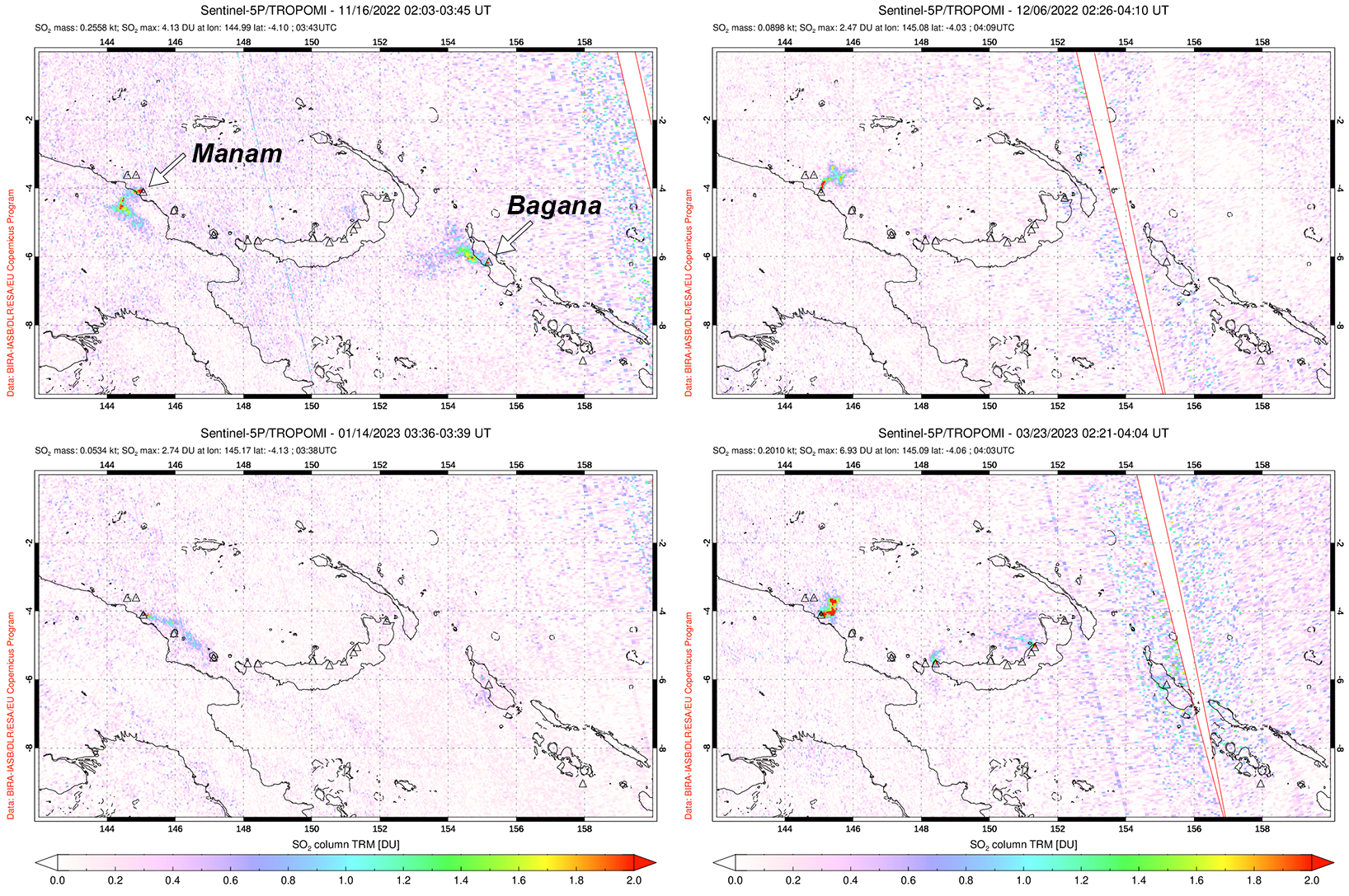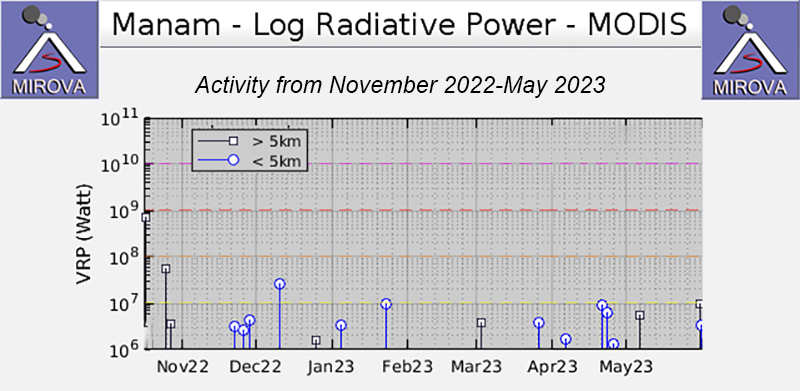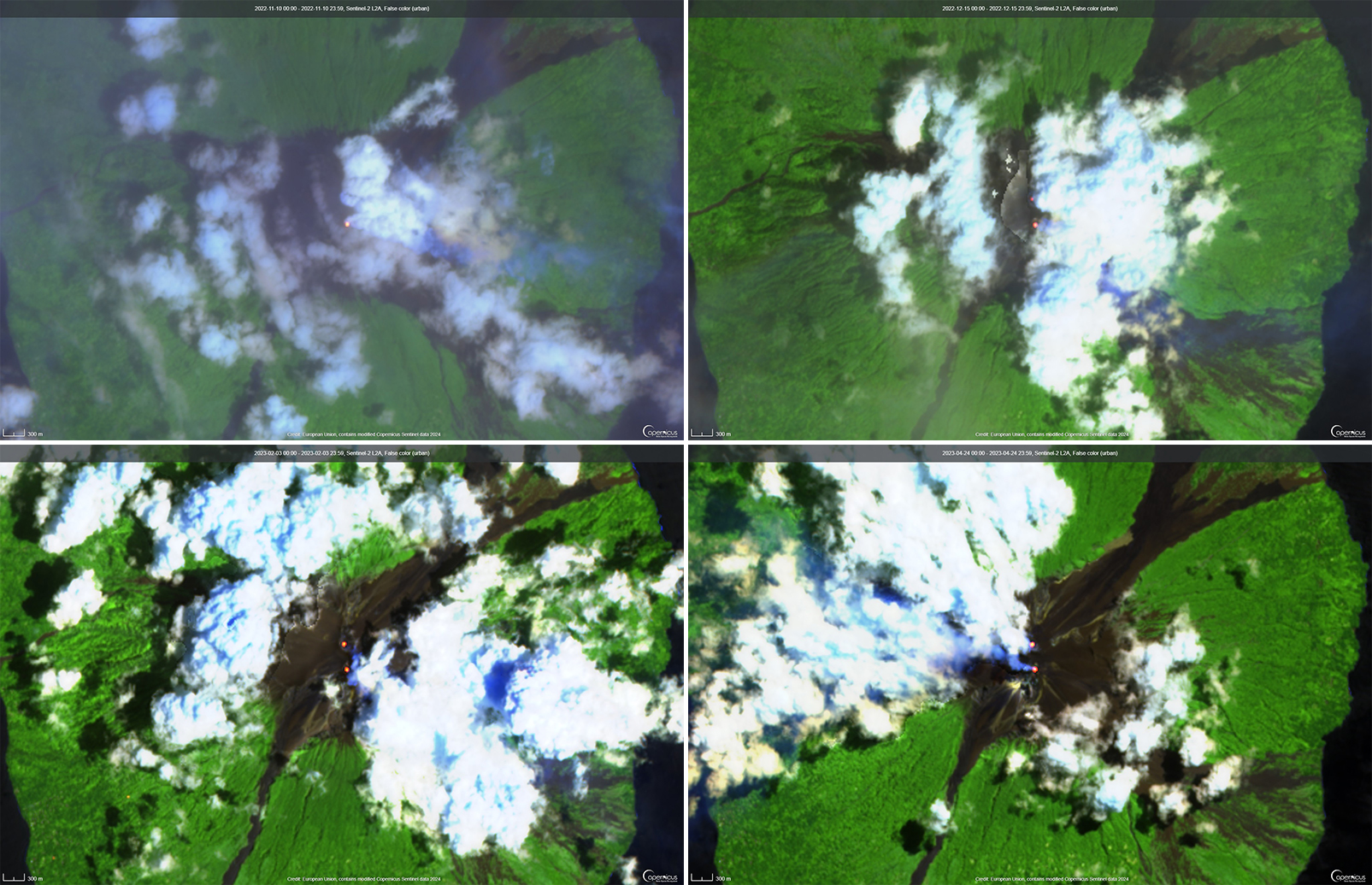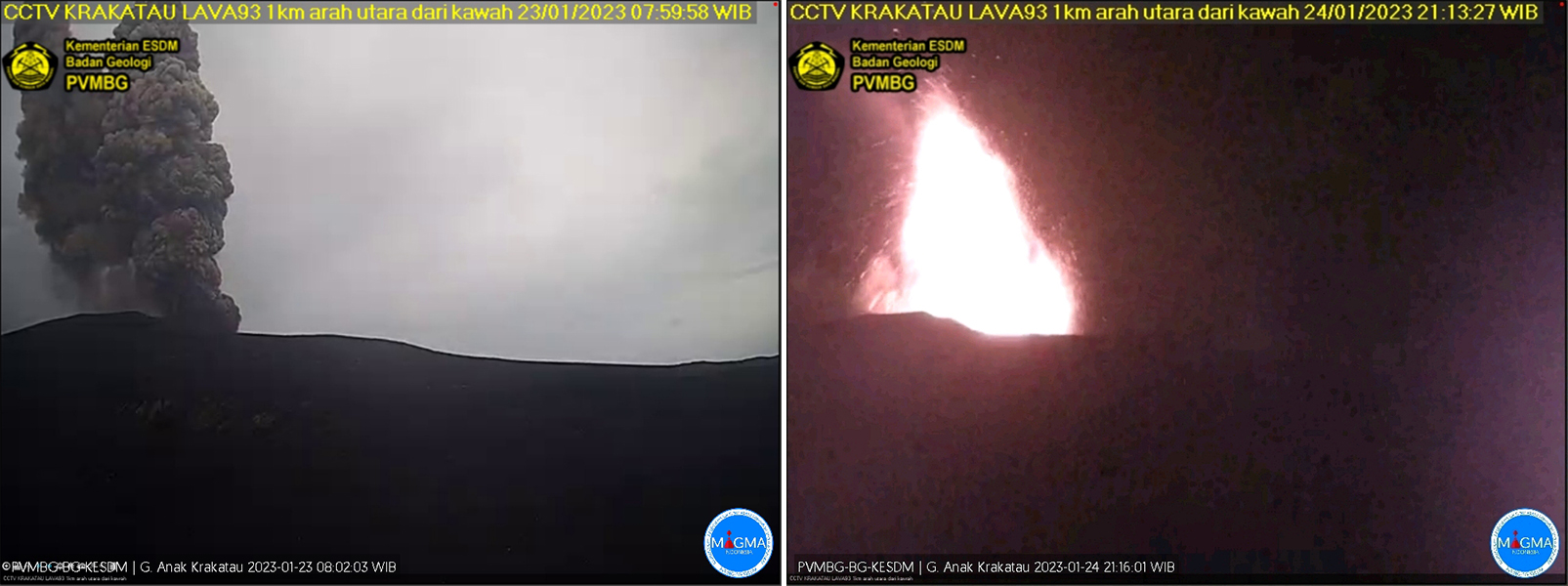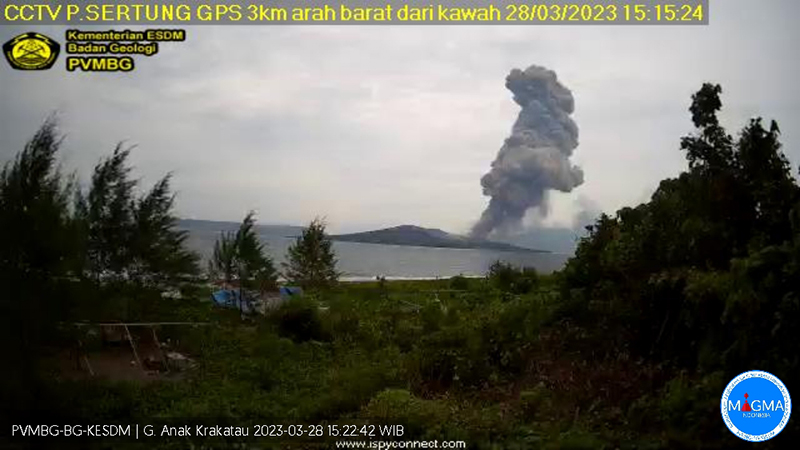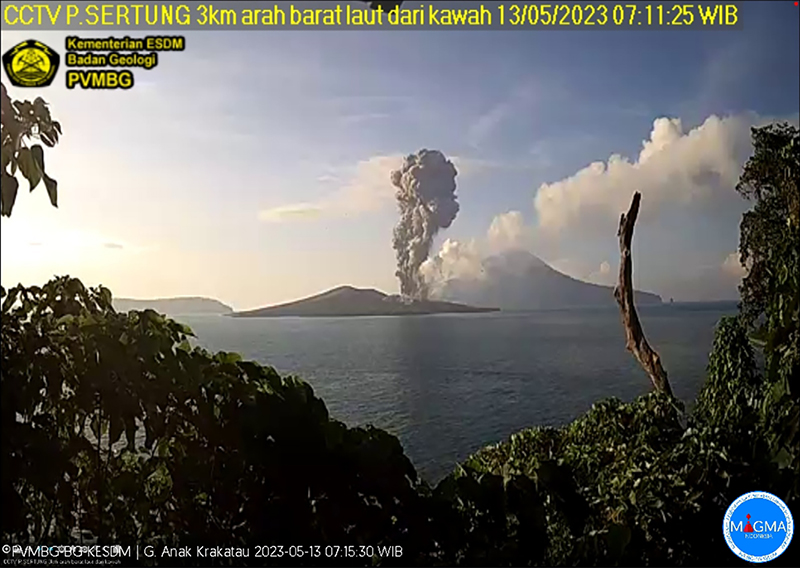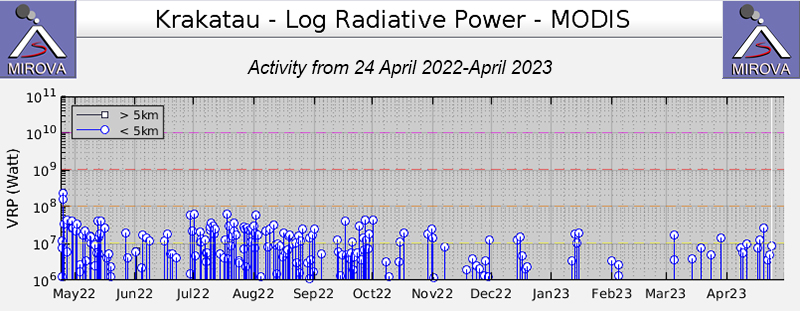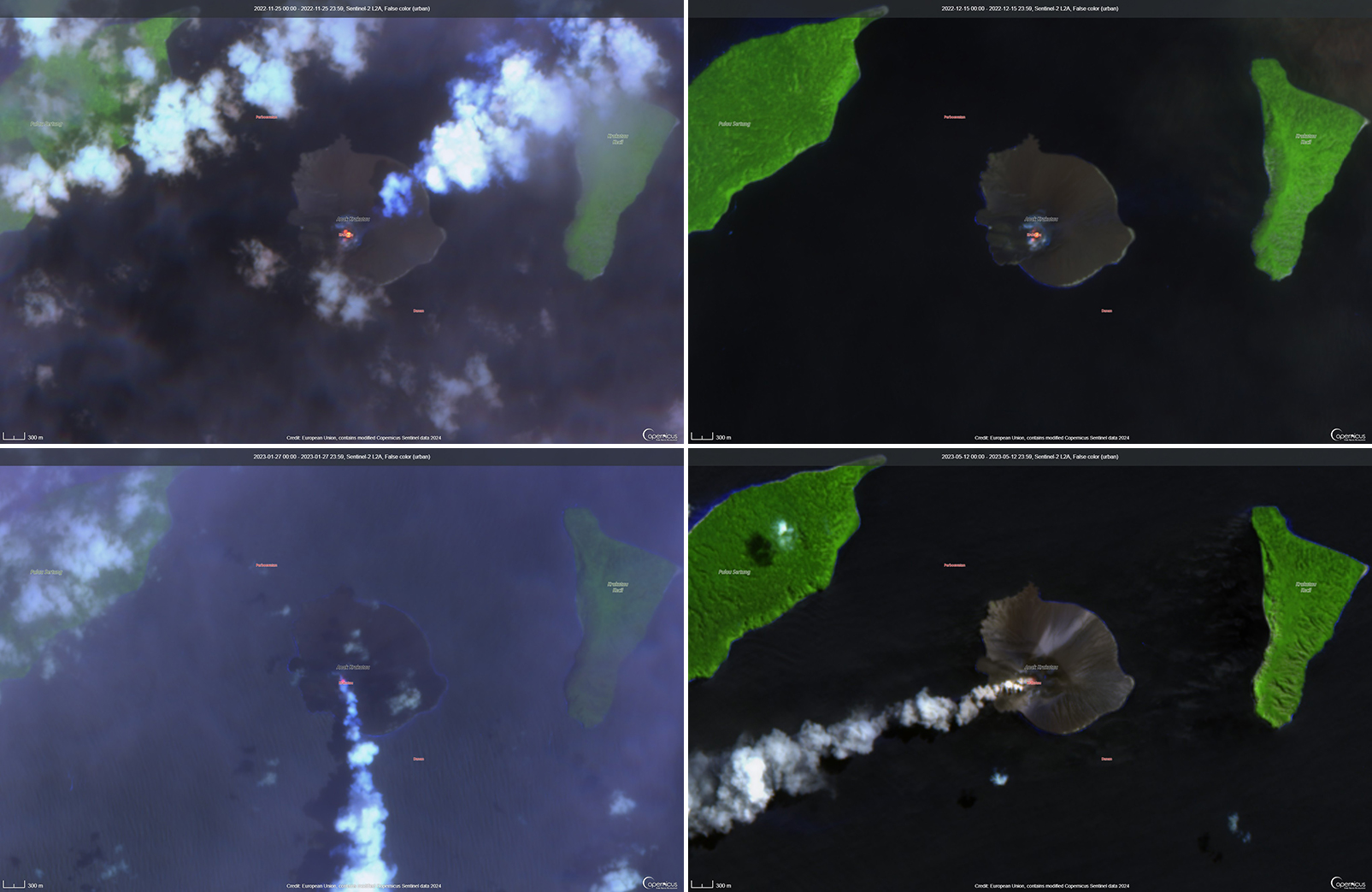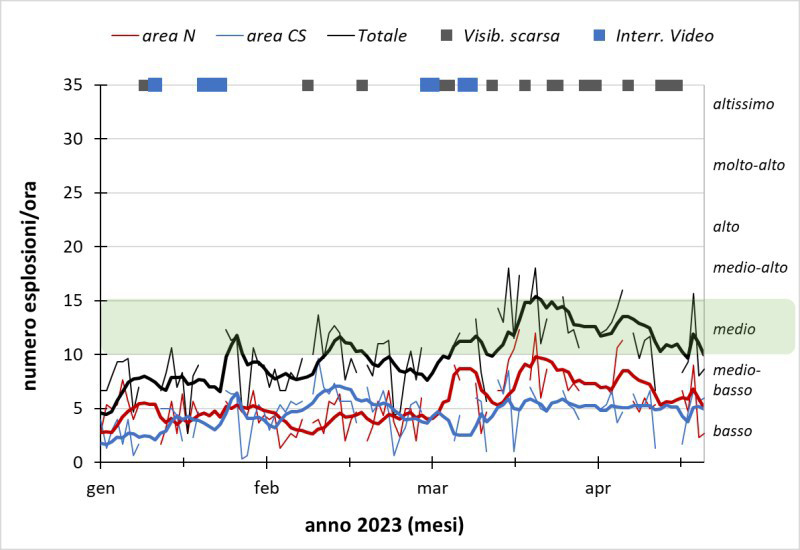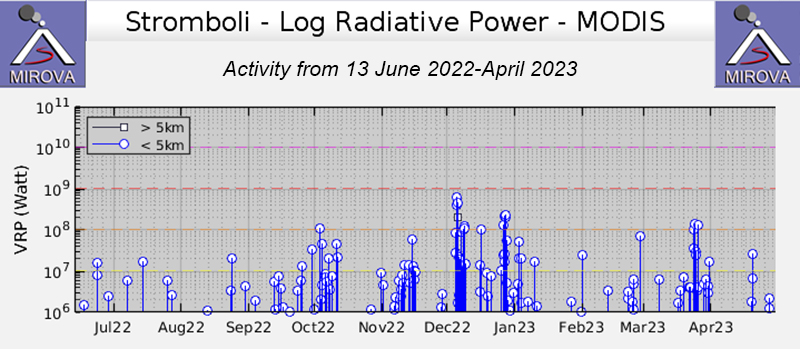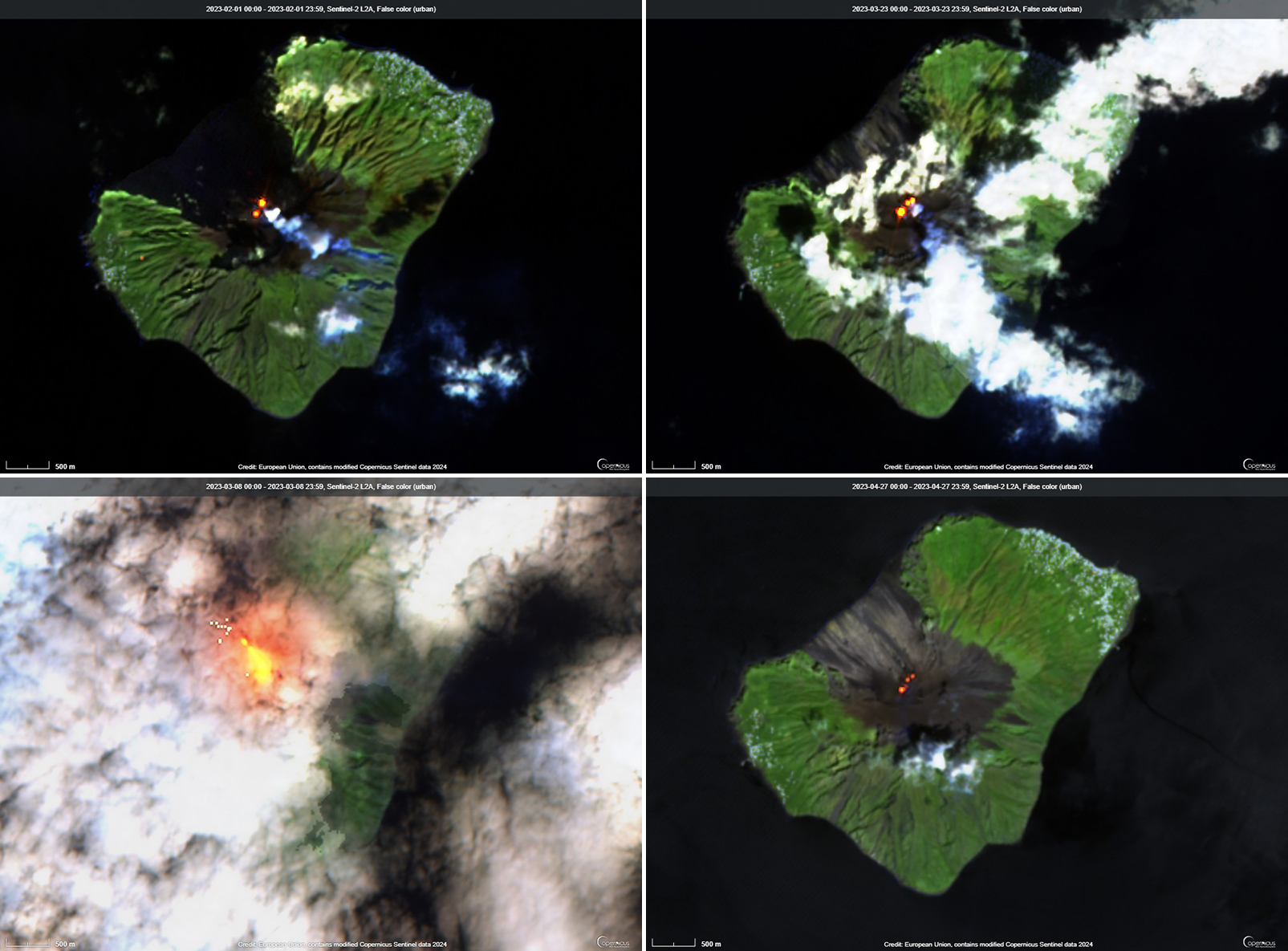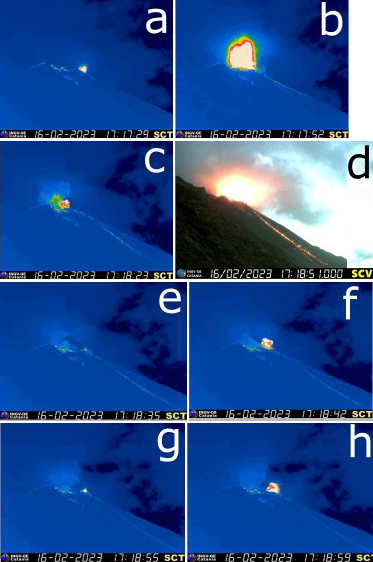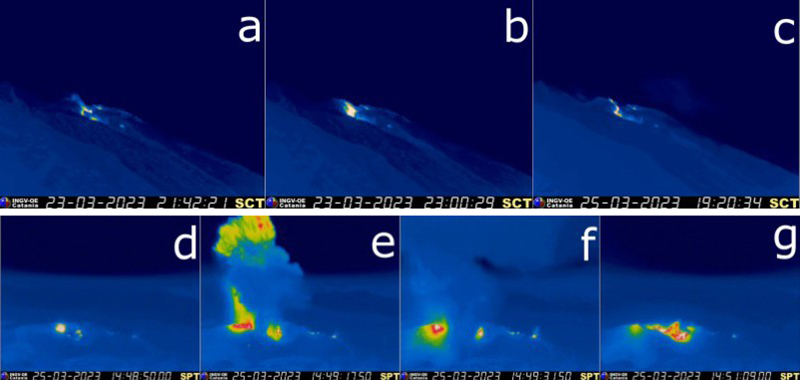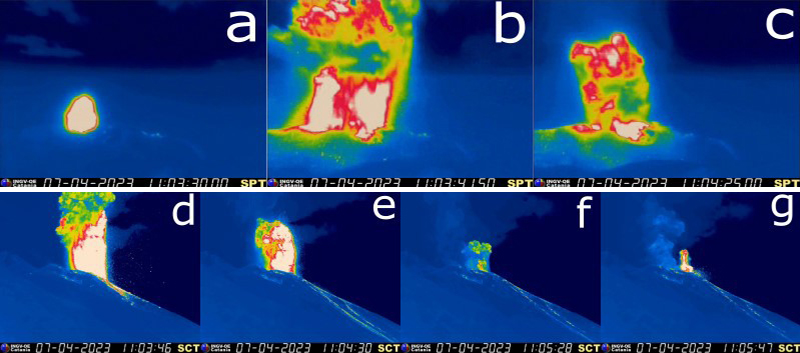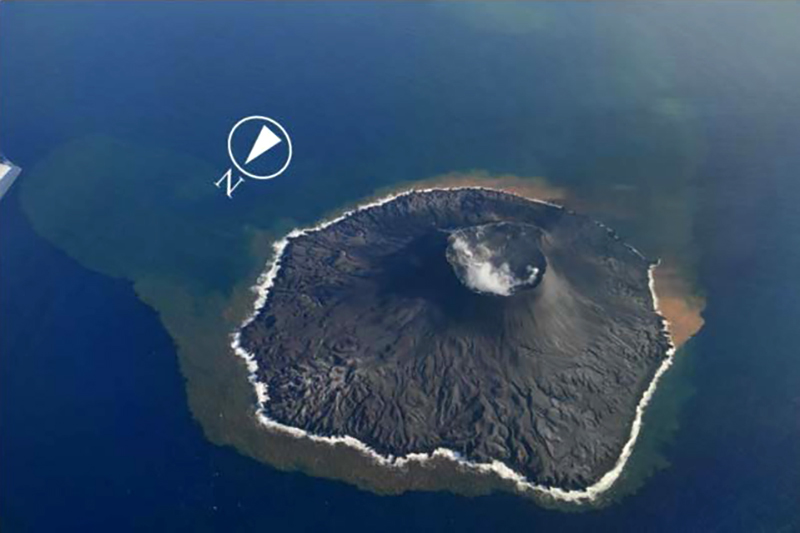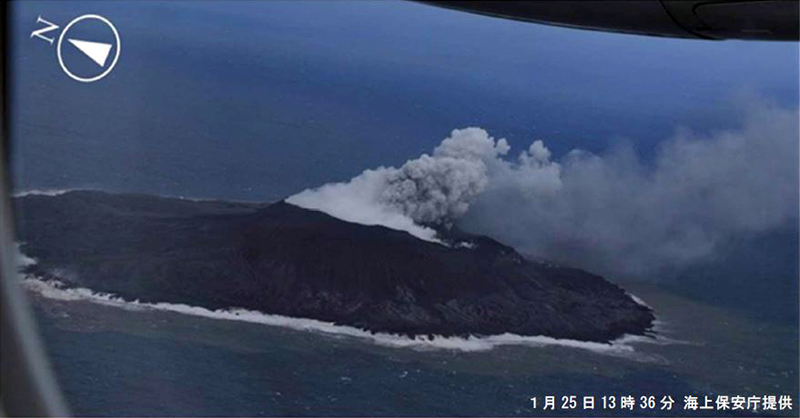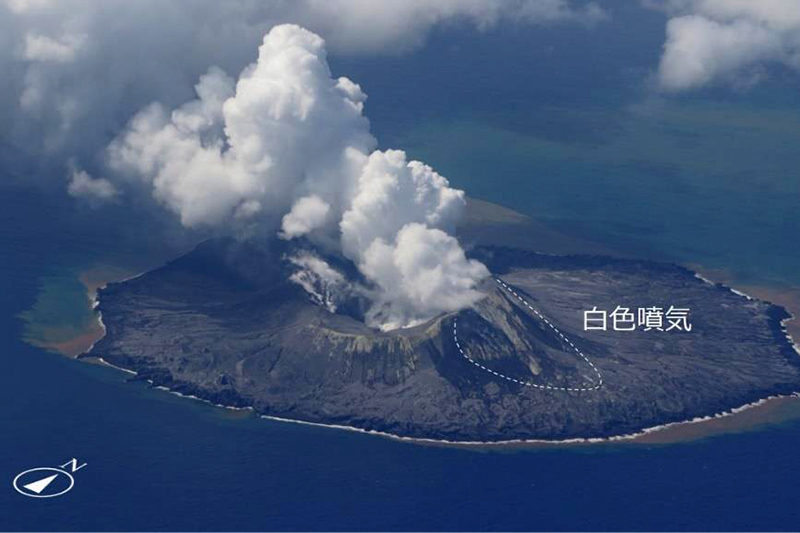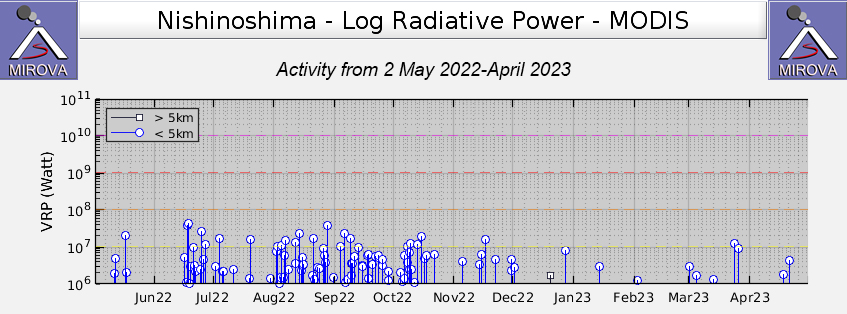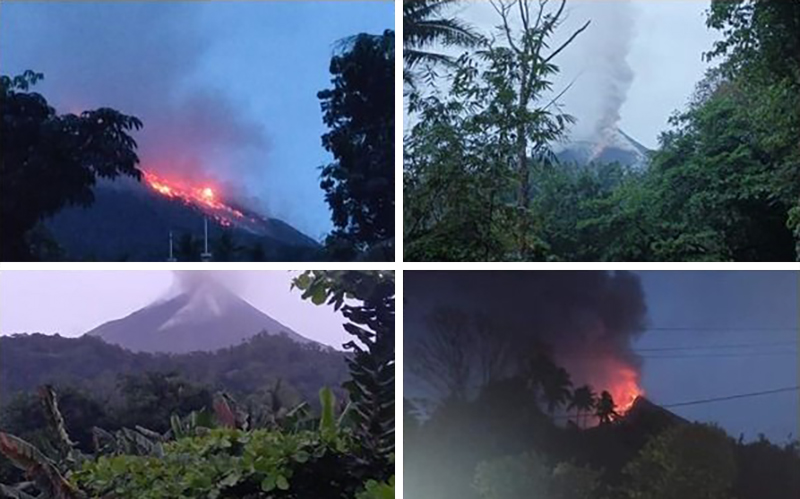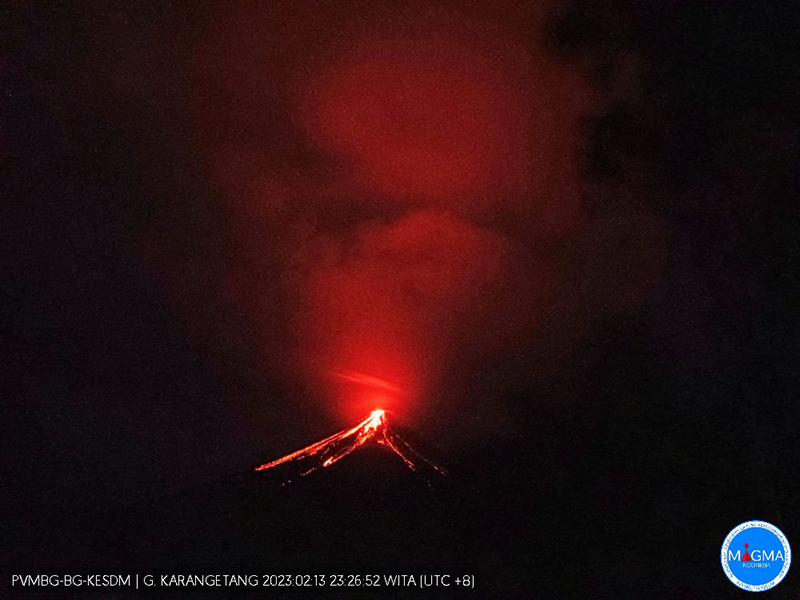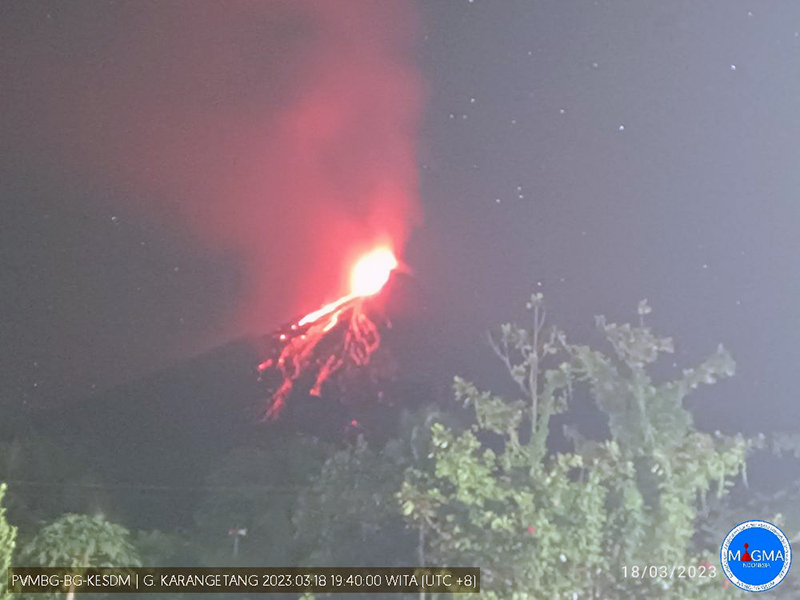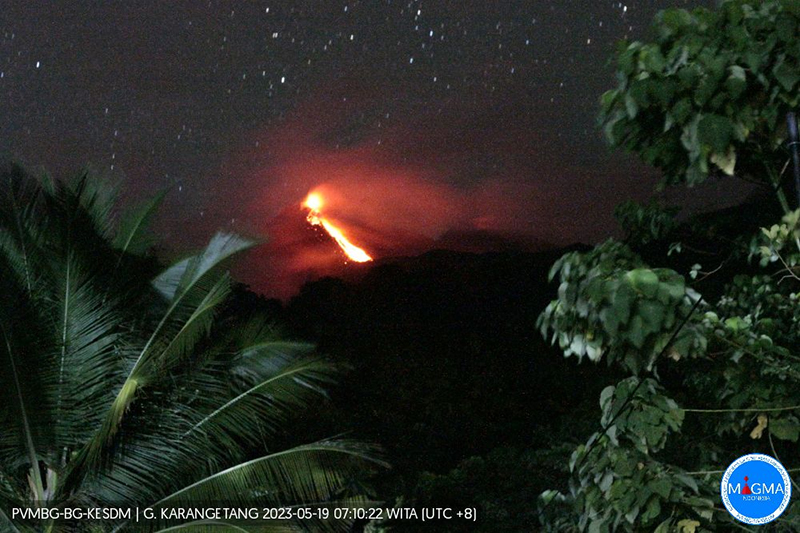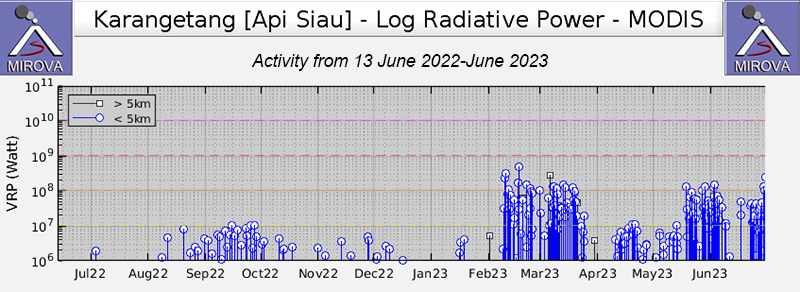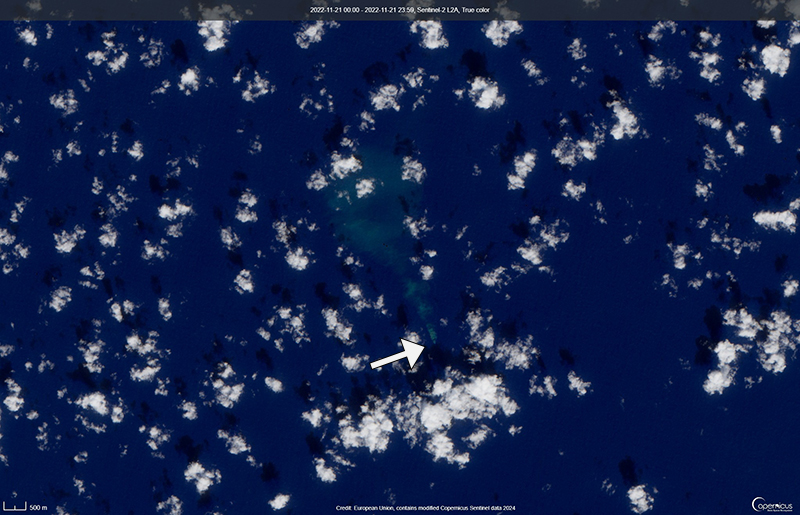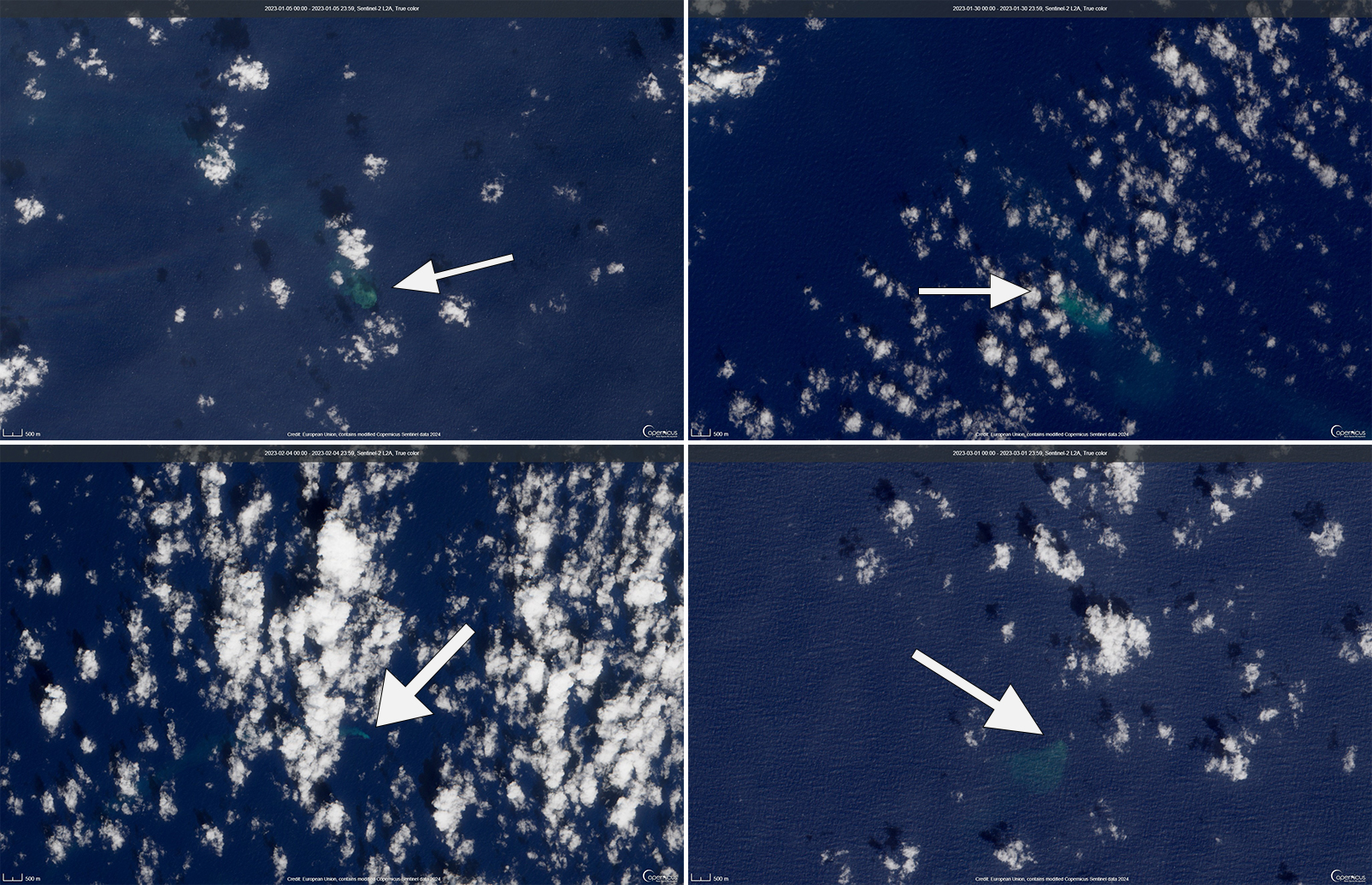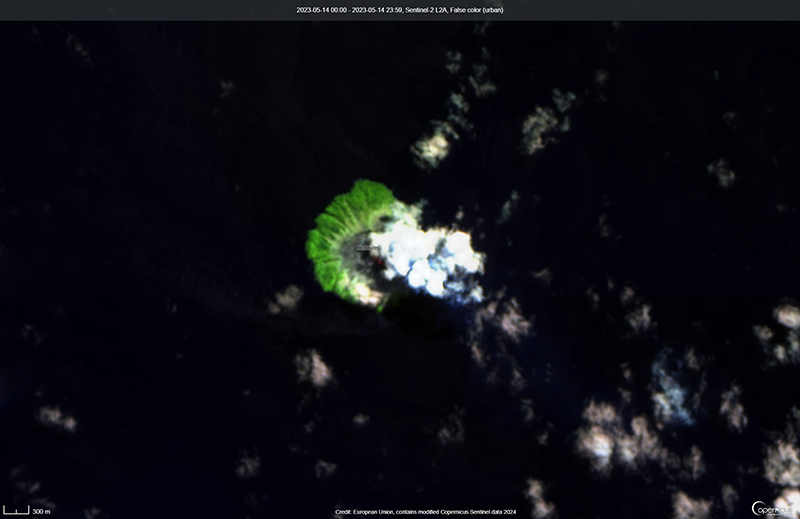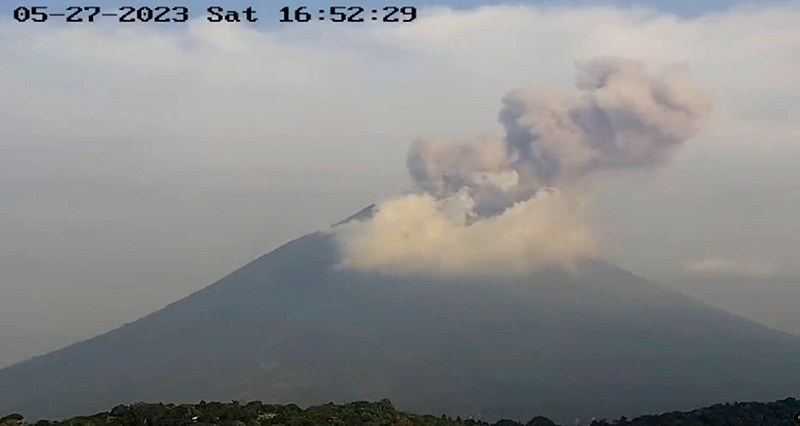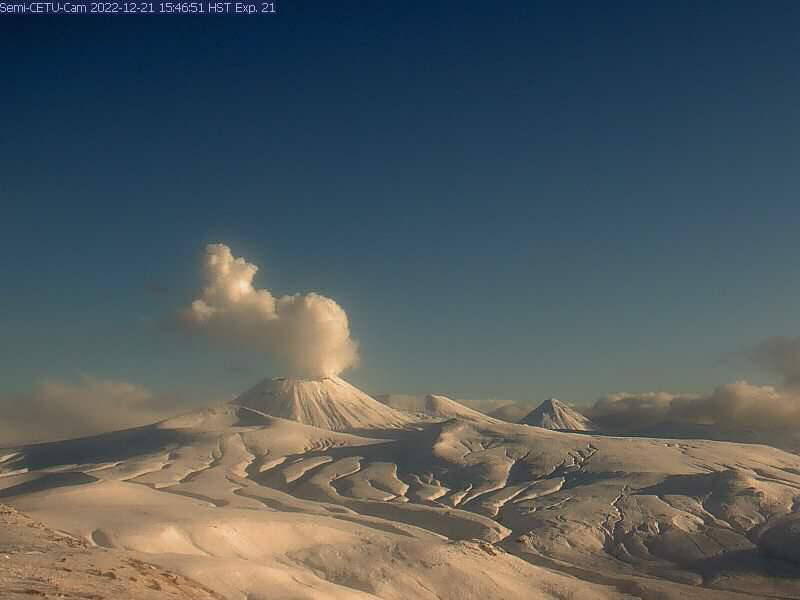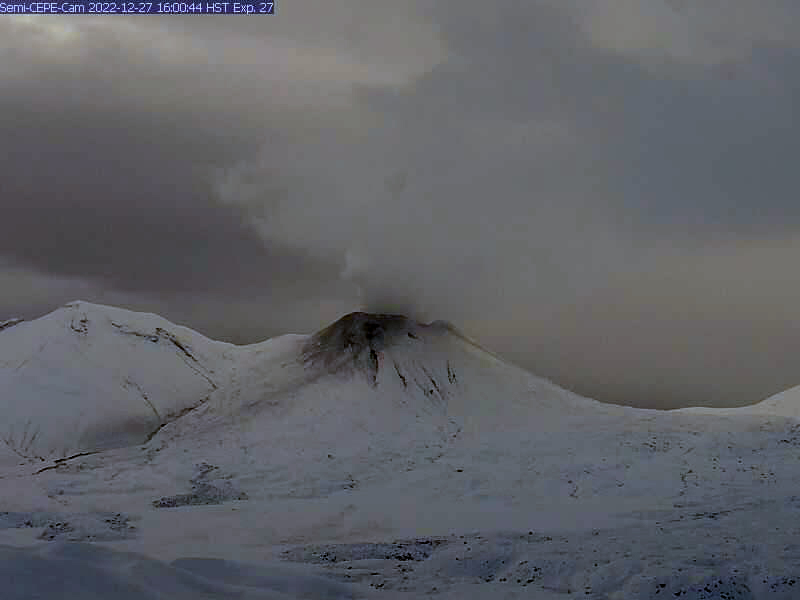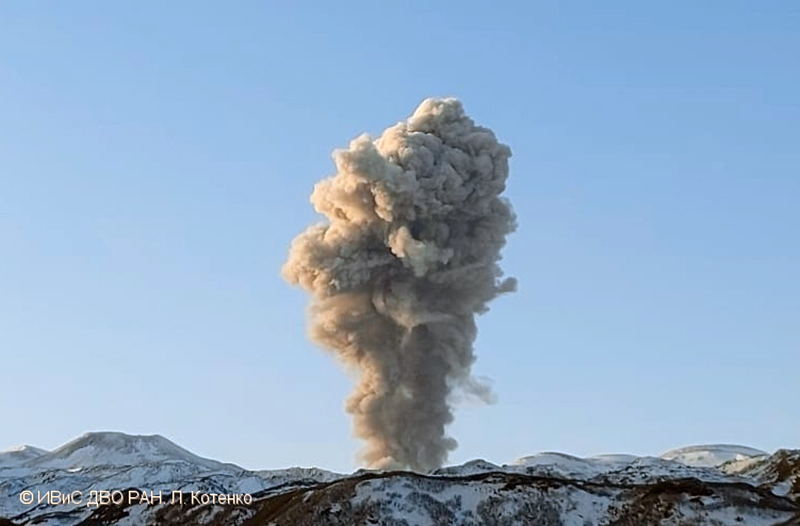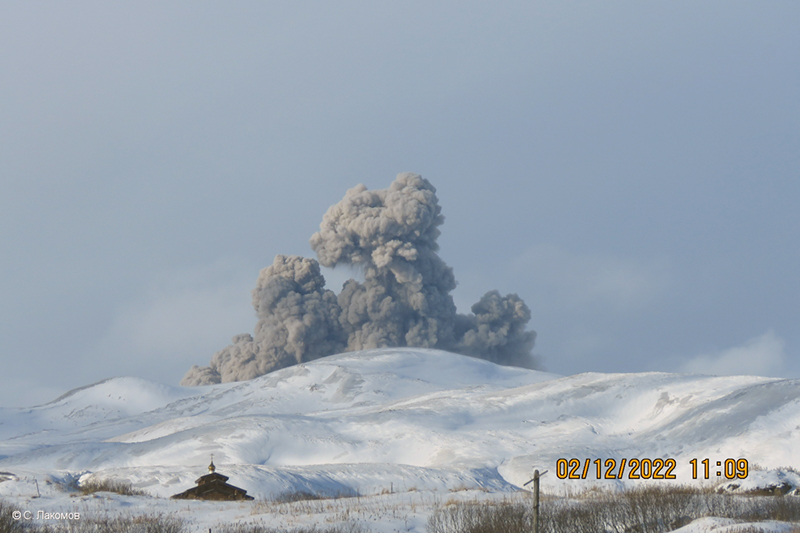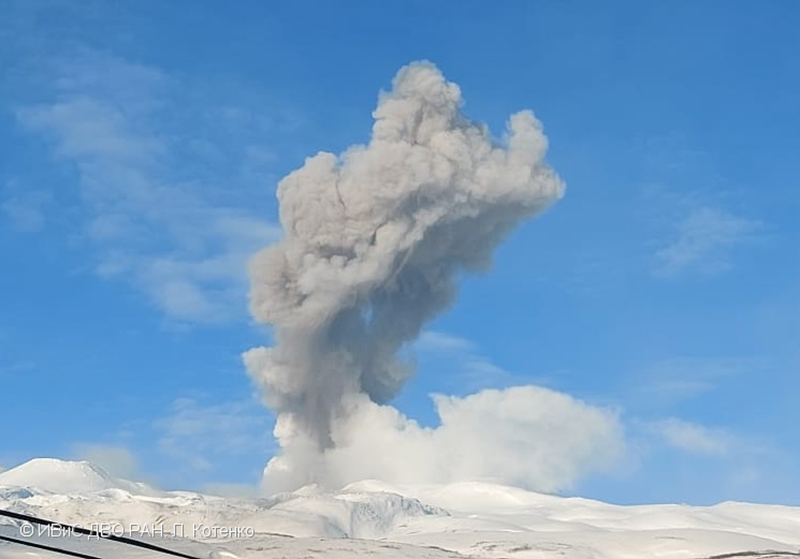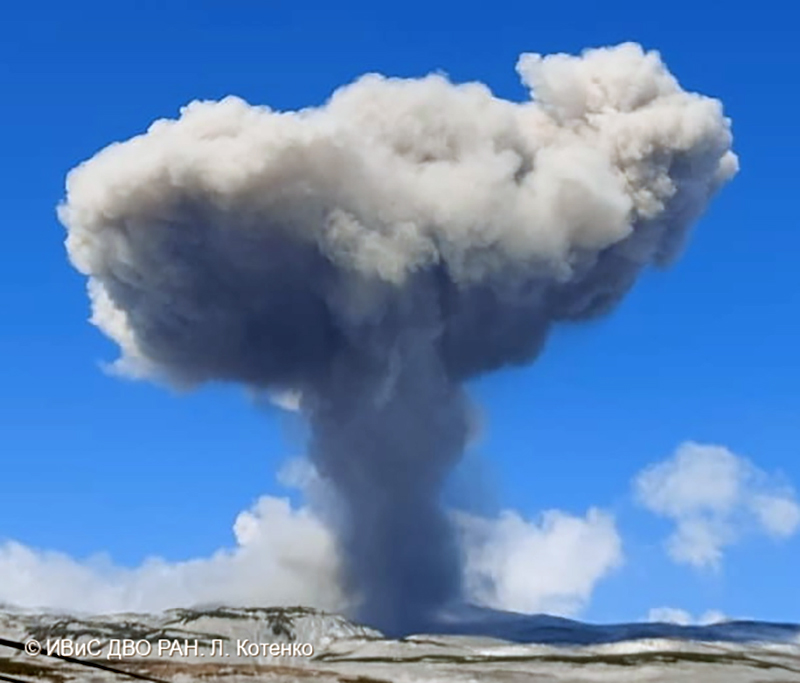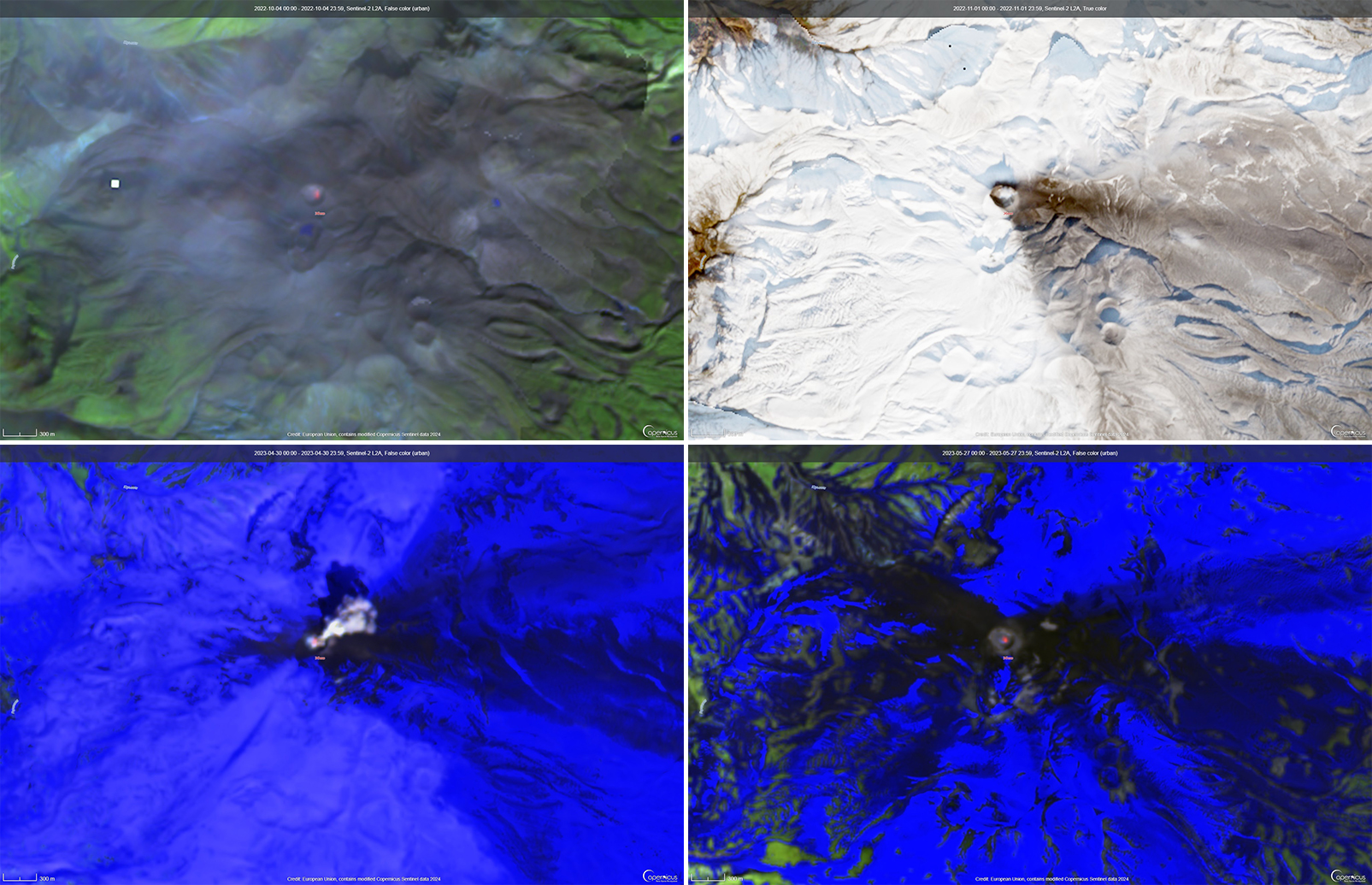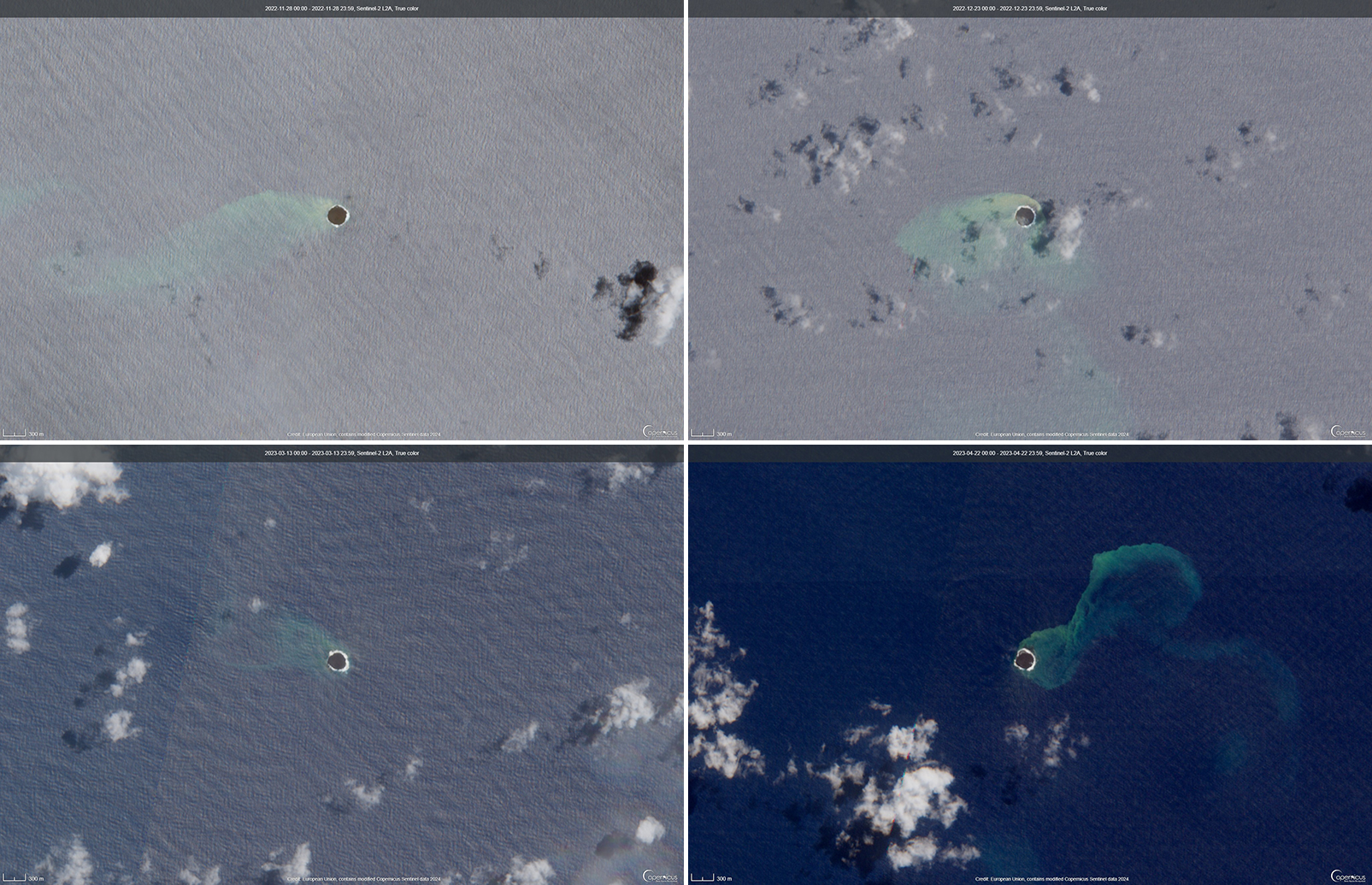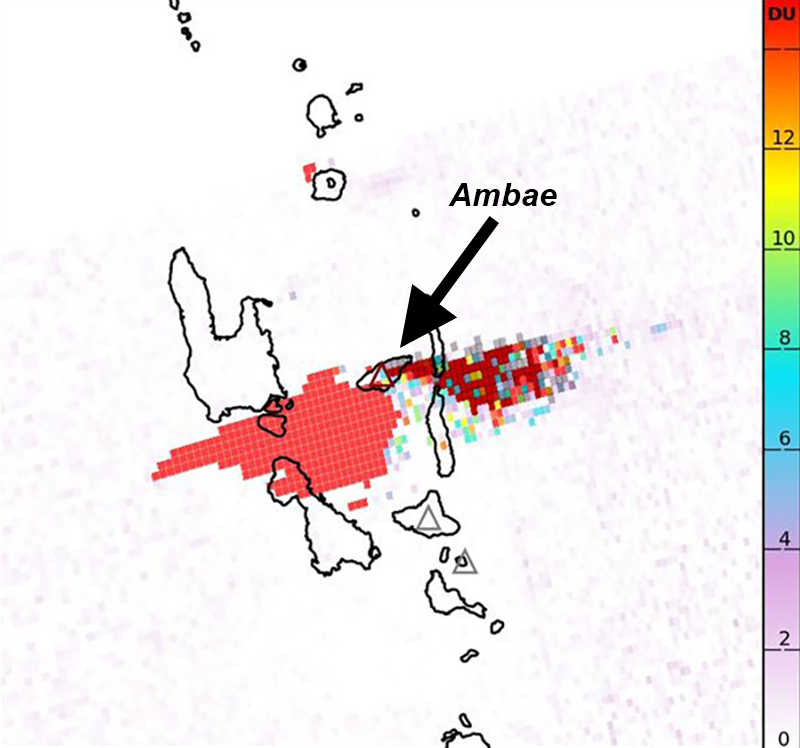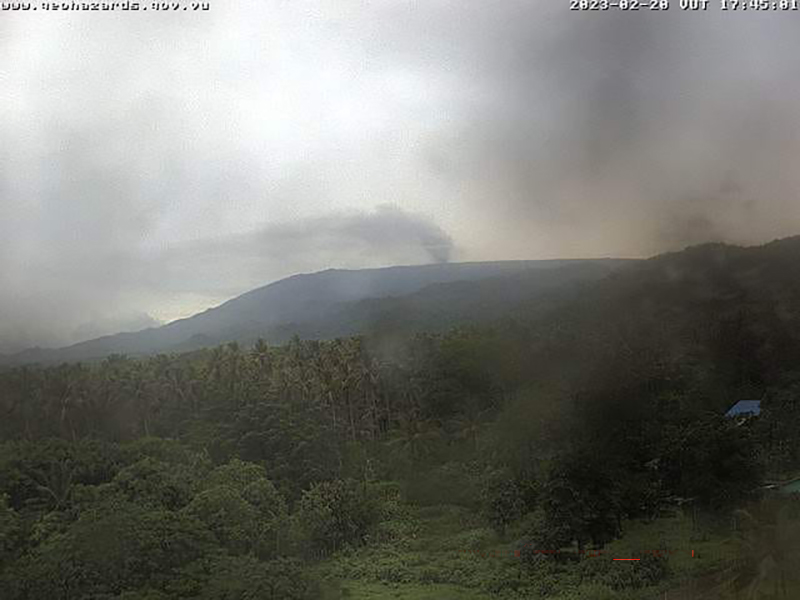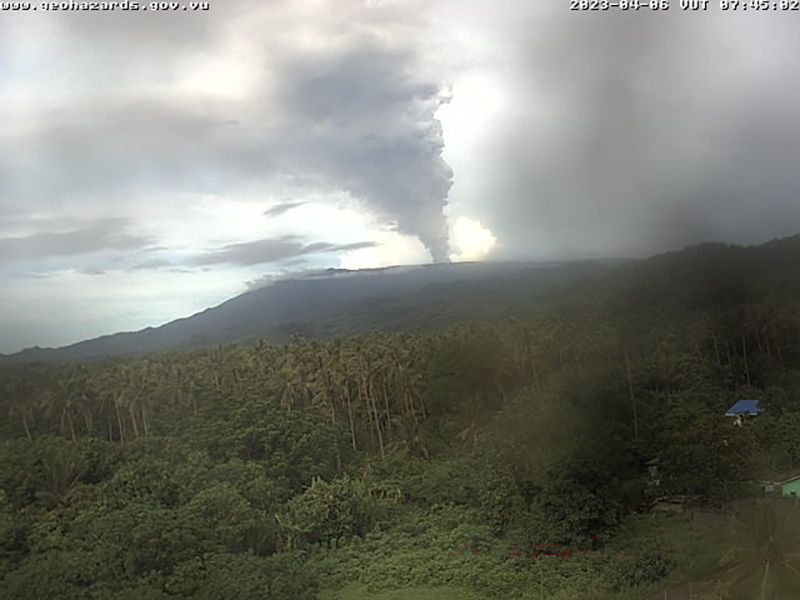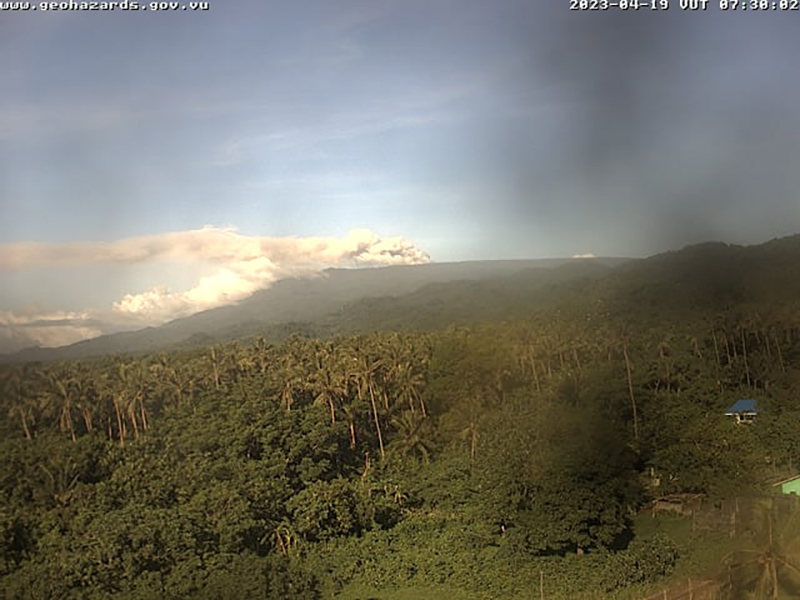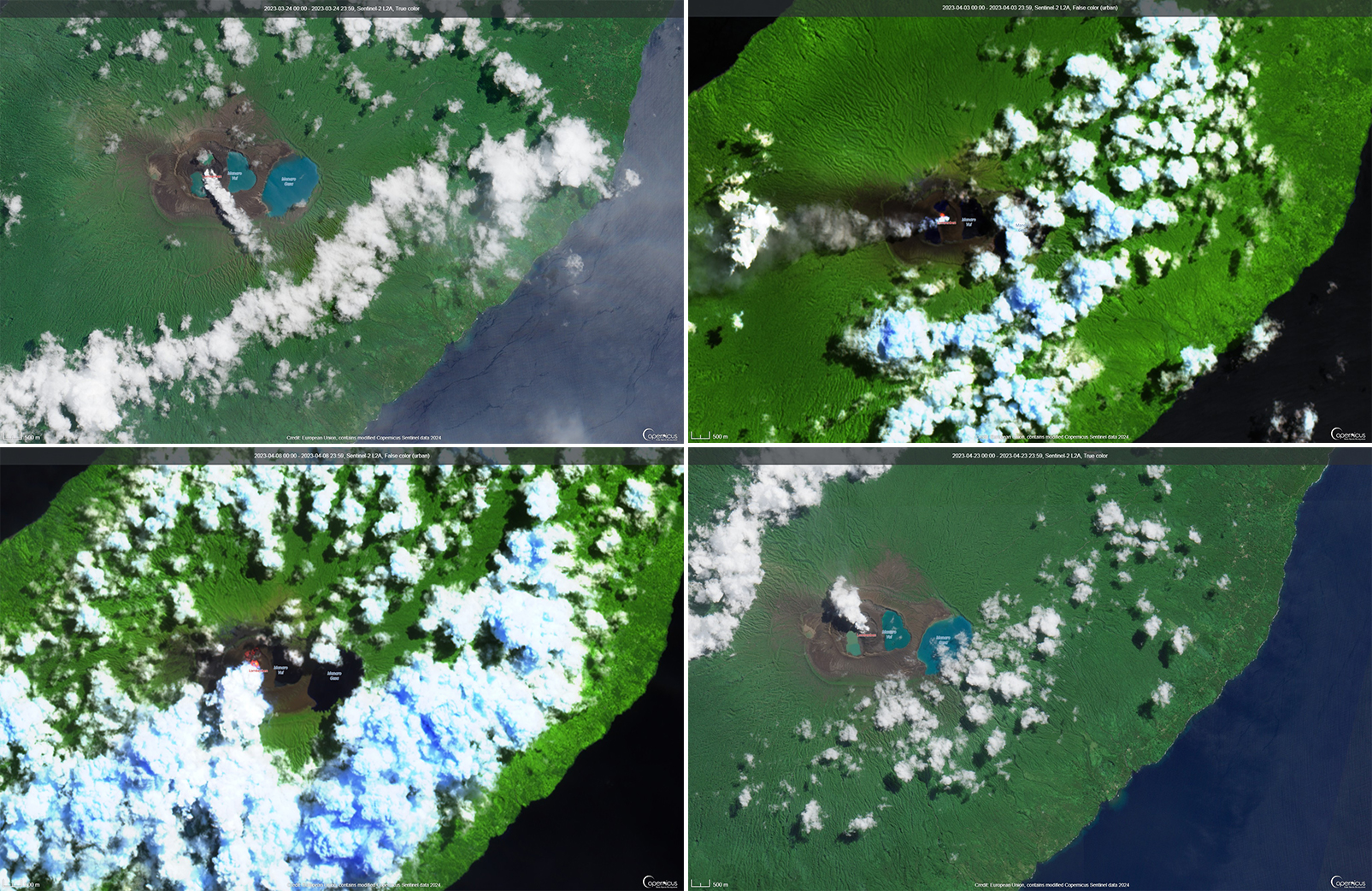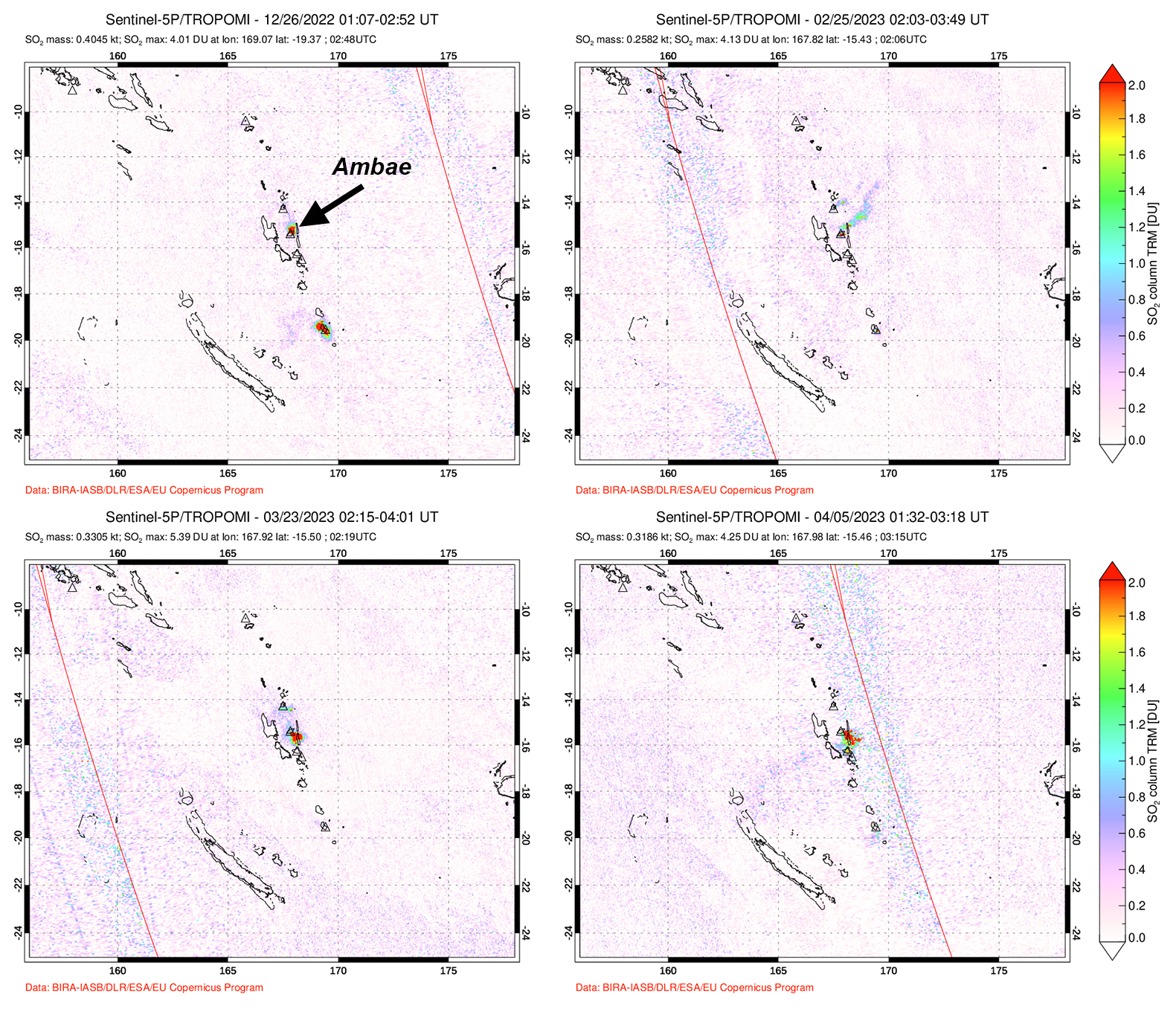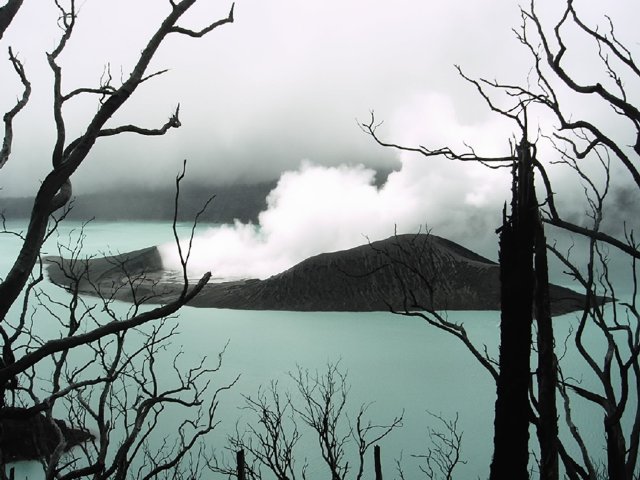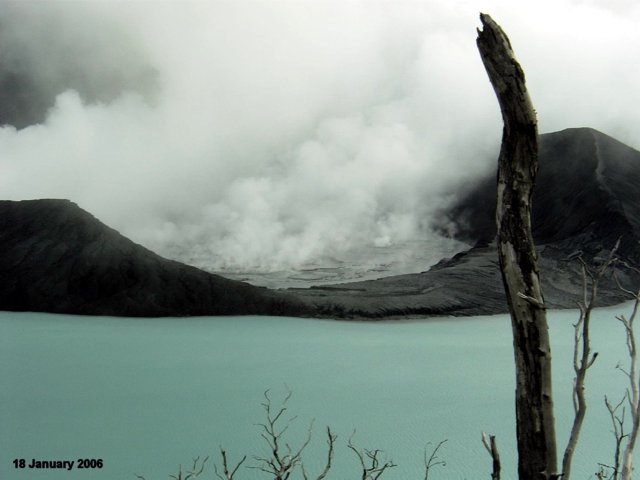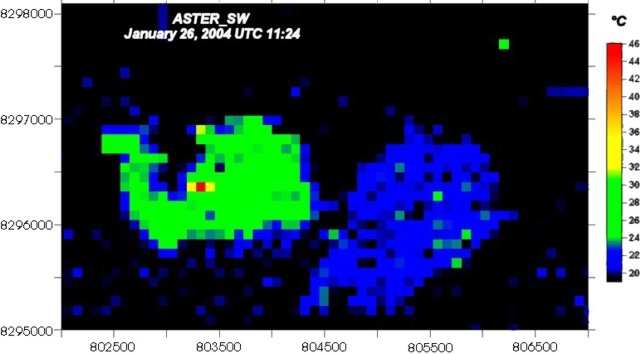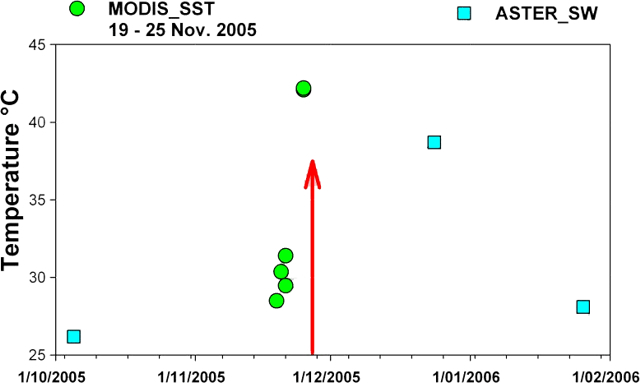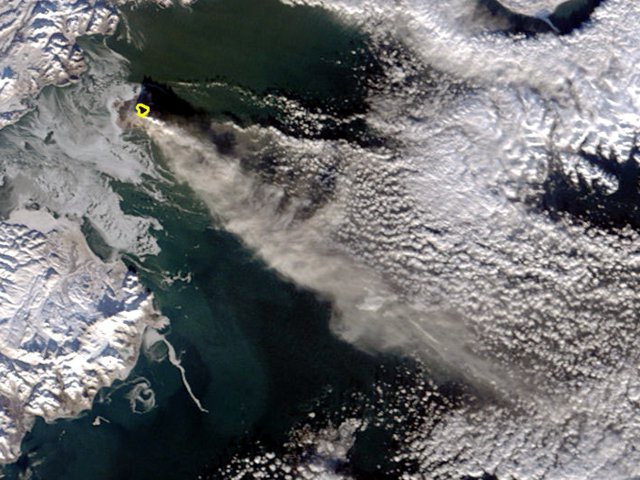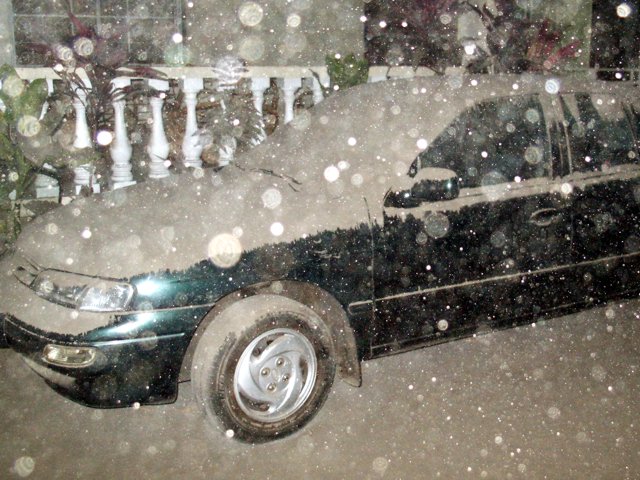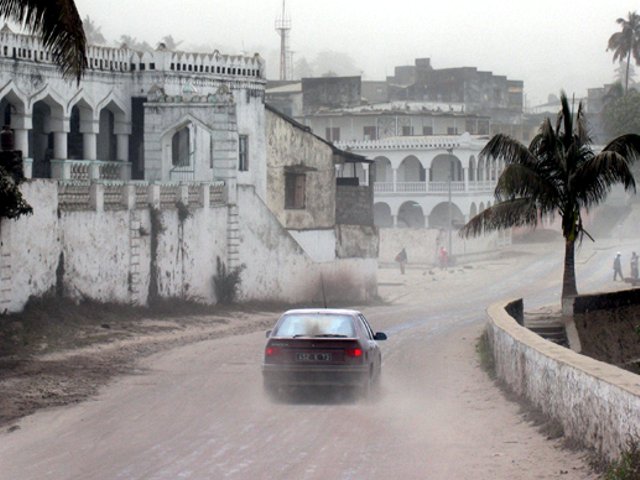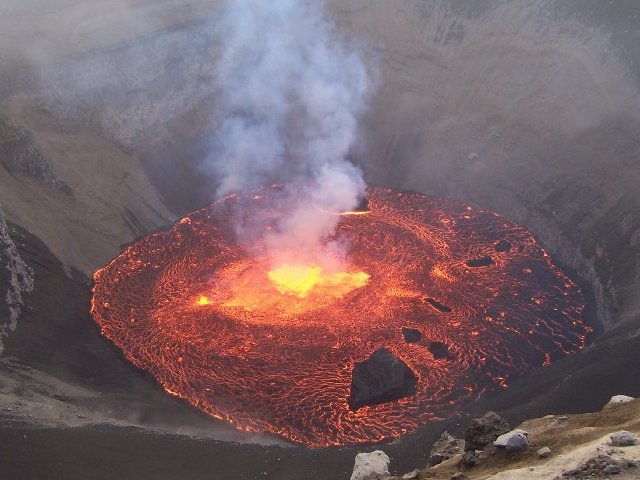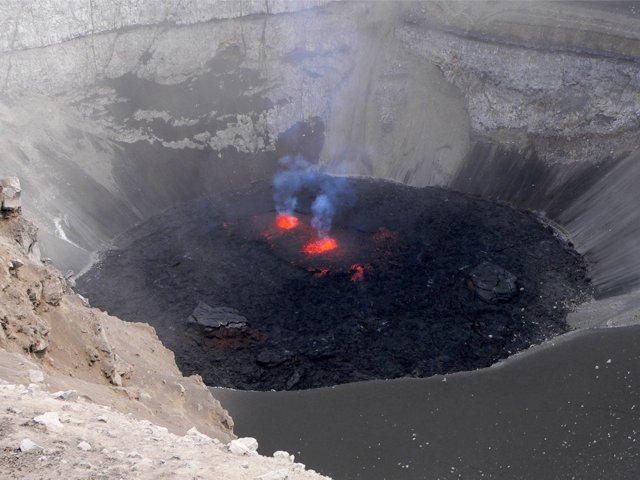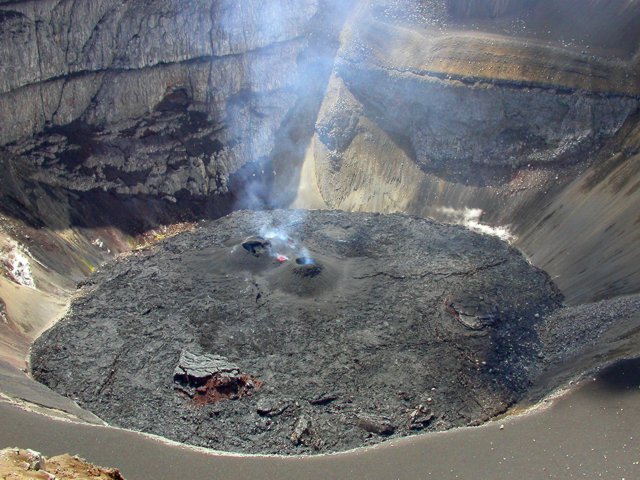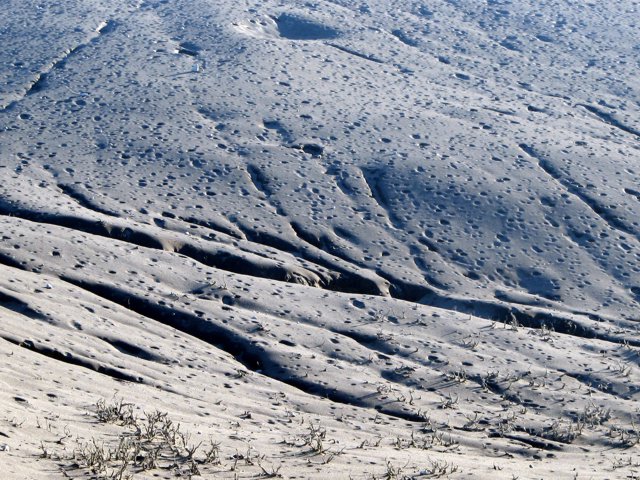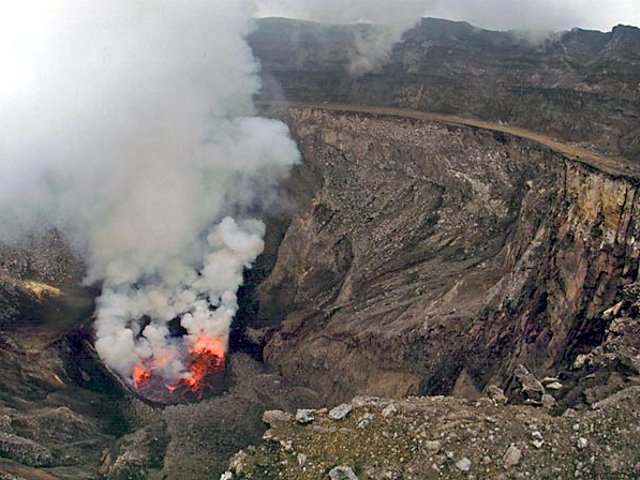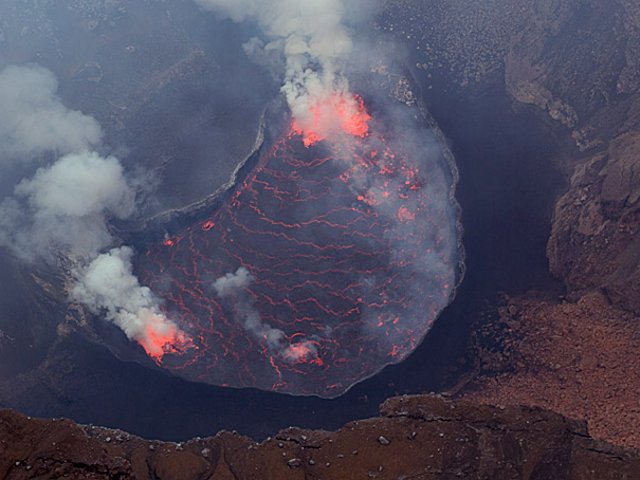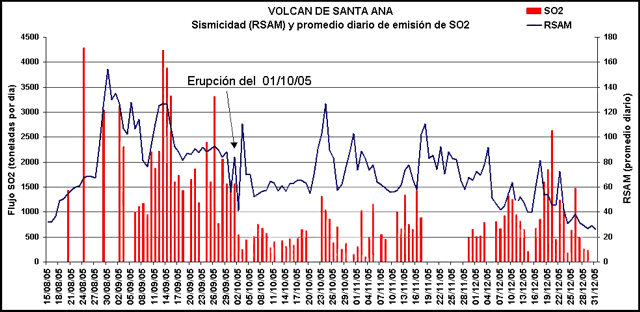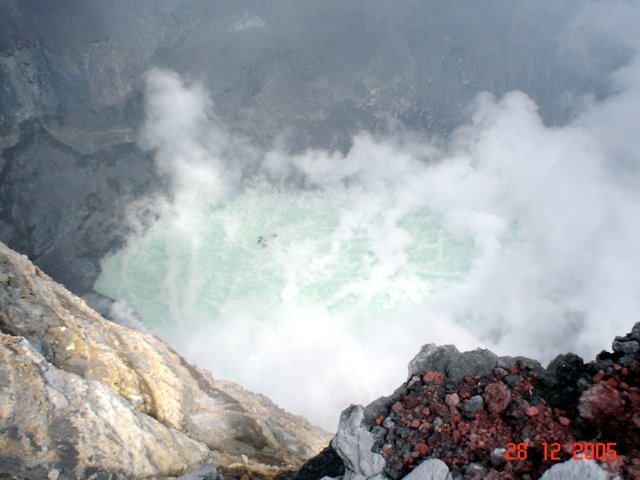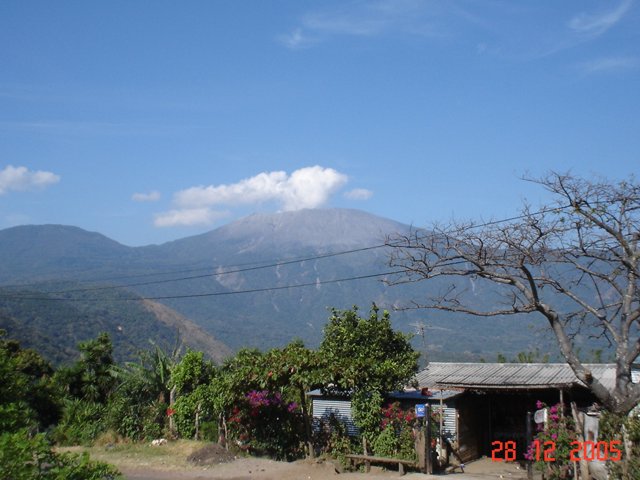Recently Published Bulletin Reports
Manam (Papua New Guinea) Few ash plumes during November-December 2022
Krakatau (Indonesia) Strombolian activity and ash plumes during November 2022-April 2023
Stromboli (Italy) Strombolian explosions and lava flows continue during January-April 2023
Nishinoshima (Japan) Small ash plumes and fumarolic activity during November 2022 through April 2023
Karangetang (Indonesia) Lava flows, incandescent avalanches, and ash plumes during January-June 2023
Ahyi (United States) Intermittent hydroacoustic signals and discolored plumes during November 2022-June 2023
Kadovar (Papua New Guinea) An ash plume and weak thermal anomaly during May 2023
San Miguel (El Salvador) Small gas-and-ash explosions during March and May 2023
Semisopochnoi (United States) Occasional explosions, ash deposits, and gas-and-steam plumes during December 2022-May 2023
Ebeko (Russia) Continued explosions, ash plumes, and ashfall during October 2022-May 2023
Home Reef (Tonga) Discolored plumes continued during November 2022-April 2023
Ambae (Vanuatu) New lava flow, ash plumes, and sulfur dioxide plumes during February-May 2023
Manam (Papua New Guinea) — July 2023  Cite this Report
Cite this Report
Manam
Papua New Guinea
4.08°S, 145.037°E; summit elev. 1807 m
All times are local (unless otherwise noted)
Few ash plumes during November-December 2022
Manam is a 10-km-wide island that consists of two active summit craters: the Main summit crater and the South summit crater and is located 13 km off the northern coast of mainland Papua New Guinea. Frequent mild-to-moderate eruptions have been recorded since 1616. The current eruption period began during June 2014 and has more recently been characterized by intermittent ash plumes and thermal activity (BGVN 47:11). This report updates activity that occurred from November 2022 through May 2023 based on information from the Darwin Volcanic Ash Advisory Center (VAAC) and various satellite data.
Ash plumes were reported during November and December 2022 by the Darwin VAAC. On 7 November an ash plume rose to 2.1 km altitude and drifted NE based on satellite images and weather models. On 14 November an ash plume rose to 2.1 km altitude and drifted W based on RVO webcam images. On 20 November ash plumes rose to 1.8 km altitude and drifted NW. On 26 December an ash plume rose to 3 km altitude and drifted S and SSE.
Intermittent sulfur dioxide plumes were detected using the TROPOMI instrument on the Sentinel-5P satellite, some of which exceeded at least two Dobson Units (DU) and drifted in different directions (figure 93). Occasional low-to-moderate power thermal anomalies were recorded by the MIROVA (Middle InfraRed Observation of Volcanic Activity) system; less than five anomalies were recorded each month during November 2022 through May 2023 (figure 94). Two thermal hotspots were detected by the MODVOLC thermal alerts system on 10 December 2022. On clear weather days, thermal activity was also captured in infrared satellite imagery in both the Main and South summit craters, accompanied by gas-and-steam emissions (figure 95).
Geologic Background. The 10-km-wide island of Manam, lying 13 km off the northern coast of mainland Papua New Guinea, is one of the country's most active volcanoes. Four large radial valleys extend from the unvegetated summit of the conical basaltic-andesitic stratovolcano to its lower flanks. These valleys channel lava flows and pyroclastic avalanches that have sometimes reached the coast. Five small satellitic centers are located near the island's shoreline on the northern, southern, and western sides. Two summit craters are present; both are active, although most observed eruptions have originated from the southern crater, concentrating eruptive products during much of the past century into the SE valley. Frequent eruptions, typically of mild-to-moderate scale, have been recorded since 1616. Occasional larger eruptions have produced pyroclastic flows and lava flows that reached flat-lying coastal areas and entered the sea, sometimes impacting populated areas.
Information Contacts: Rabaul Volcano Observatory (RVO), Geohazards Management Division, Department of Mineral Policy and Geohazards Management (DMPGM), PO Box 3386, Kokopo, East New Britain Province, Papua New Guinea; Darwin Volcanic Ash Advisory Centre (VAAC), Bureau of Meteorology, Northern Territory Regional Office, PO Box 40050, Casuarina, NT 0811, Australia (URL: http://www.bom.gov.au/info/vaac/); MIROVA (Middle InfraRed Observation of Volcanic Activity), a collaborative project between the Universities of Turin and Florence (Italy) supported by the Centre for Volcanic Risk of the Italian Civil Protection Department (URL: http://www.mirovaweb.it/); Hawai'i Institute of Geophysics and Planetology (HIGP) - MODVOLC Thermal Alerts System, School of Ocean and Earth Science and Technology (SOEST), Univ. of Hawai'i, 2525 Correa Road, Honolulu, HI 96822, USA (URL: http://modis.higp.hawaii.edu/); NASA Global Sulfur Dioxide Monitoring Page, Atmospheric Chemistry and Dynamics Laboratory, NASA Goddard Space Flight Center (NASA/GSFC), 8800 Greenbelt Road, Goddard, Maryland, USA (URL: https://so2.gsfc.nasa.gov/); Copernicus Browser, Copernicus Data Space Ecosystem, European Space Agency (URL: https://dataspace.copernicus.eu/browser/).
Krakatau (Indonesia) — July 2023  Cite this Report
Cite this Report
Krakatau
Indonesia
6.1009°S, 105.4233°E; summit elev. 285 m
All times are local (unless otherwise noted)
Strombolian activity and ash plumes during November 2022-April 2023
Krakatau is located in the Sunda Strait between Java and Sumatra, Indonesia. Caldera collapse during the catastrophic 1883 eruption destroyed Danan and Perbuwatan cones and left only a remnant of Rakata. The post-collapse cone of Anak Krakatau (Child of Krakatau) was constructed within the 1883 caldera at a point between the former Danan and Perbuwatan cones; it has been the site of frequent eruptions since 1927. The current eruption period began in May 2021 and has recently consisted of explosions, ash plumes, and thermal activity (BGVN 47:11). This report covers activity during November 2022 through April 2023 based on information provided by the Indonesian Center for Volcanology and Geological Hazard Mitigation, referred to as Pusat Vulkanologi dan Mitigasi Bencana Geologi (PVMBG), MAGMA Indonesia, the Darwin Volcanic Ash Advisory Center (VAAC), and several sources of satellite data.
Activity was relatively low during November and December 2022. Daily white gas-and-steam plumes rose 25-100 m above the summit and drifted in different directions. Gray ash plumes rose 200 m above the summit and drifted NE at 1047 and at 2343 on 11 November. On 14 November at 0933 ash plumes rose 300 m above the summit and drifted E. An ash plume was reported at 0935 on 15 December that rose 100 m above the summit and drifted NE. An eruptive event at 1031 later that day generated an ash plume that rose 700 m above the summit and drifted NE. A gray ash plume at 1910 rose 100 m above the summit and drifted E. Incandescent material was ejected above the vent based on an image taken at 1936.
During January 2023 daily white gas-and-steam plumes rose 25-300 m above the summit and drifted in multiple directions. Gray-to-brown ash plumes were reported at 1638 on 3 January, at 1410 and 1509 on 4 January, and at 0013 on 5 January that rose 100-750 m above the summit and drifted NE and E; the gray-to-black ash plume at 1509 on 4 January rose as high as 3 km above the summit and drifted E. Gray ash plumes were recorded at 1754, 2241, and 2325 on 11 January and at 0046 on 12 January and rose 200-300 m above the summit and drifted NE. Toward the end of January, PVMBG reported that activity had intensified; Strombolian activity was visible in webcam images taken at 0041, 0043, and 0450 on 23 January. Multiple gray ash plumes throughout the day rose 200-500 m above the summit and drifted E and SE (figure 135). Webcam images showed progressively intensifying Strombolian activity at 1919, 1958, and 2113 on 24 January; a gray ash plume at 1957 rose 300 m above the summit and drifted E (figure 135). Eruptive events at 0231 and 2256 on 25 January and at 0003 on 26 January ejected incandescent material from the vent, based on webcam images. Gray ash plumes observed during 26-27 January rose 300-500 m above the summit and drifted NE, E, and SE.
Low levels of activity were reported during February and March. Daily white gas-and-steam plumes rose 25-300 m above the summit and drifted in different directions. The Darwin VAAC reported that continuous ash emissions rose to 1.5-1.8 km altitude and drifted W and NW during 1240-1300 on 10 March, based on satellite images, weather models, and PVMBG webcams. White-and-gray ash plumes rose 500 m and 300 m above the summit and drifted SW at 1446 and 1846 on 18 March, respectively. An eruptive event was recorded at 2143, though it was not visible due to darkness. Multiple ash plumes were reported during 27-29 March that rose as high as 2.5 km above the summit and drifted NE, W, and SW (figure 136). Webcam images captured incandescent ejecta above the vent at 0415 and around the summit area at 2003 on 28 March and at 0047 above the vent on 29 March.
Daily white gas-and-steam plumes rose 25-300 m above the summit and drifted in multiple directions during April and May. White-and-gray and black plumes rose 50-300 m above the summit on 2 and 9 April. On 11 May at 1241 a gray ash plume rose 1-3 km above the summit and drifted SW. On 12 May at 0920 a gray ash plume rose 2.5 km above the summit and drifted SW and at 2320 an ash plume rose 1.5 km above the summit and drifted SW. An accompanying webcam image showed incandescent ejecta. On 13 May at 0710 a gray ash plume rose 2 km above the summit and drifted SW (figure 137).
The MIROVA (Middle InfraRed Observation of Volcanic Activity) graph of MODIS thermal anomaly data showed intermittent low-to-moderate power thermal anomalies during November 2022 through April 2023 (figure 138). Some of this thermal activity was also visible in infrared satellite imagery at the crater, accompanied by gas-and-steam and ash plumes that drifted in different directions (figure 139).
Geologic Background. The renowned Krakatau (frequently mis-named as Krakatoa) volcano lies in the Sunda Strait between Java and Sumatra. Collapse of an older edifice, perhaps in 416 or 535 CE, formed a 7-km-wide caldera. Remnants of that volcano are preserved in Verlaten and Lang Islands; subsequently the Rakata, Danan, and Perbuwatan cones were formed, coalescing to create the pre-1883 Krakatau Island. Caldera collapse during the catastrophic 1883 eruption destroyed Danan and Perbuwatan, and left only a remnant of Rakata. This eruption caused more than 36,000 fatalities, most as a result of tsunamis that swept the adjacent coastlines of Sumatra and Java. Pyroclastic surges traveled 40 km across the Sunda Strait and reached the Sumatra coast. After a quiescence of less than a half century, the post-collapse cone of Anak Krakatau (Child of Krakatau) was constructed within the 1883 caldera at a point between the former Danan and Perbuwatan cones. Anak Krakatau has been the site of frequent eruptions since 1927.
Information Contacts: Pusat Vulkanologi dan Mitigasi Bencana Geologi (PVMBG, also known as Indonesian Center for Volcanology and Geological Hazard Mitigation, CVGHM), Jalan Diponegoro 57, Bandung 40122, Indonesia (URL: http://www.vsi.esdm.go.id/); MAGMA Indonesia, Kementerian Energi dan Sumber Daya Mineral (URL: https://magma.esdm.go.id/v1); Darwin Volcanic Ash Advisory Centre (VAAC), Bureau of Meteorology, Northern Territory Regional Office, PO Box 40050, Casuarina, NT 0811, Australia (URL: http://www.bom.gov.au/info/vaac/); MIROVA (Middle InfraRed Observation of Volcanic Activity), a collaborative project between the Universities of Turin and Florence (Italy) supported by the Centre for Volcanic Risk of the Italian Civil Protection Department (URL: http://www.mirovaweb.it/); Copernicus Browser, Copernicus Data Space Ecosystem, European Space Agency (URL: https://dataspace.copernicus.eu/browser/).
Stromboli
Italy
38.789°N, 15.213°E; summit elev. 924 m
All times are local (unless otherwise noted)
Strombolian explosions and lava flows continue during January-April 2023
Stromboli, located in Italy, has exhibited nearly constant lava fountains for the past 2,000 years; recorded eruptions date back to 350 BCE. Eruptive activity occurs at the summit from multiple vents, which include a north crater area (N area) and a central-southern crater (CS area) on a terrace known as the ‘terrazza craterica’ at the head of the Sciara del Fuoco, a large scarp that runs from the summit down the NW side of the volcano-island. Activity typically consists of Strombolian explosions, incandescent ejecta, lava flows, and pyroclastic flows. Thermal and visual monitoring cameras are located on the nearby Pizzo Sopra La Fossa, above the terrazza craterica, and at multiple flank locations. The current eruption period has been ongoing since 1934 and recent activity has consisted of frequent Strombolian explosions and lava flows (BGVN 48:02). This report updates activity during January through April 2023 primarily characterized by Strombolian explosions and lava flows based on reports from Italy's Istituto Nazionale di Geofisica e Vulcanologia (INGV) and various satellite data.
Frequent explosive activity continued throughout the reporting period, generally in the low-to-medium range, based on the number of hourly explosions in the summit crater (figure 253, table 16). Intermittent thermal activity was recorded by the MIROVA (Middle InfraRed Observation of Volcanic Activity) analysis of MODIS satellite data (figure 254). According to data collected by the MODVOLC thermal algorithm, a total of 9 thermal alerts were detected: one on 2 January 2023, one on 1 February, five on 24 March, and two on 26 March. The stronger pulses of thermal activity likely reflected lava flow events. Infrared satellite imagery captured relatively strong thermal hotspots at the two active summit craters on clear weather days, showing an especially strong event on 8 March (figure 255).
Table 16. Summary of type, frequency, and intensity of explosive activity at Stromboli by month during January-April 2023; information from webcam observations. Courtesy of INGV weekly reports.
| Month |
Explosive Activity |
| Jan 2023 |
Typical Strombolian activity with spattering and lava overflows in the N crater area. Explosions were reported from 4 vents in the N area and 1-2 vents in the CS area. The average hourly frequency of explosions was low-to-medium (1-12 events/hour). The intensity of the explosions varied from low (less than 80 m high) to medium (less than 150 m high) in the N crater area and up to high (greater than 150 m high) in the CS crater area. |
| Feb 2023 |
Typical Strombolian activity with spattering in the N crater area. Explosions were reported from 2-3 vents in the N area and 1-4 vents in the CS area. The average hourly frequency of explosions was low-to-medium (1-14 events/hour). The intensity of the explosions varied from low (less than 80 m high) to medium (less than 150 m high) in the N crater area and up to high (greater than 150 m high) in the CS crater area. |
| Mar 2023 |
Typical Strombolian activity with spattering and lava overflows in the N crater area. Explosions were reported from 2-3 vents in the N area and 2-4 vents in the CS area. The average hourly frequency of explosions was low-to-medium (1-18 events/hour). The intensity of the explosions varied from low (less than 80 m high) to medium (less than 150 m high) in the N crater area and up to high (greater than 150 m high) in the CS crater area. |
| Apr 2023 |
Typical Strombolian activity. Explosions were reported from 2 vents in the N area and 2-3 vents in the CS area. The average hourly frequency of explosions was low-to-high (1-16 events/hour). The intensity of the explosions varied from low (less than 80 m high) to medium (less than 150 m high) in both the N and CS crater areas. |
Activity during January-February 2023. Strombolian explosions were reported in the N crater area, as well as lava effusion. Explosive activity in the N crater area ejected coarse material (bombs and lapilli). Intense spattering was observed in both the N1 and N2 craters. In the CS crater area, explosions generally ejected fine material (ash), sometimes to heights greater than 250 m. The intensity of the explosions was characterized as low-to-medium in the N crater and medium-to-high in the CS crater. After intense spattering activity from the N crater area, a lava overflow began at 2136 on 2 January that flowed part way down the Sciara del Fuoco, possibly moving down the drainage that formed in October, out of view from webcams. The flow remained active for a couple of hours before stopping and beginning to cool. A second lava flow was reported at 0224 on 4 January that similarly remained active for a few hours before stopping and cooling. Intense spattering was observed on 11 and 13 January from the N1 crater. After intense spattering activity at the N2 crater at 1052 on 17 January another lava flow started to flow into the upper part of the Sciara del Fuoco (figure 256), dividing into two: one that traveled in the direction of the drainage formed in October, and the other one moving parallel to the point of emission. By the afternoon, the rate of the flow began to decrease, and at 1900 it started to cool. A lava flow was reported at 1519 on 24 January following intense spattering in the N2 area, which began to flow into the upper part of the Sciara del Fuoco. By the morning of 25 January, the lava flow had begun to cool. During 27 January the frequency of eruption in the CS crater area increased to 6-7 events/hour compared to the typical 1-7 events/hour; the following two days showed a decrease in frequency to less than 1 event/hour. Starting at 1007 on 30 January a high-energy explosive sequence was produced by vents in the CS crater area. The sequence began with an initial energetic pulse that lasted 45 seconds, ejecting predominantly coarse products 300 m above the crater that fell in an ESE direction. Subsequent and less intense explosions ejected material 100 m above the crater. The total duration of this event lasted approximately two minutes. During 31 January through 6, 13, and 24 February spattering activity was particularly intense for short periods in the N2 crater.
An explosive sequence was reported on 16 February that was characterized by a major explosion in the CS crater area (figure 257). The sequence began at 1817 near the S2 crater that ejected material radially. A few seconds later, lava fountains were observed in the central part of the crater. Three explosions of medium intensity (material was ejected less than 150 m high) were recorded at the S2 crater. The first part of this sequence lasted approximately one minute, according to INGV, and material rose 300 m above the crater and then was deposited along the Sciara del Fuoco. The second phase began at 1818 at the S1 crater; it lasted seven seconds and material was ejected 150 m above the crater. Another event 20 seconds later lasted 12 seconds, also ejecting material 150 m above the crater. The sequence ended with at least three explosions of mostly fine material from the S1 crater. The total duration of this sequence was about two minutes.
Short, intense spattering activity was noted above the N1 crater on 27 and 28 February. A lava overflow was first reported at 0657 from the N2 crater on 27 February that flowed into the October 2022 drainage. By 1900 the flow had stopped. A second lava overflow also in the N crater area occurred at 2149, which overlapped the first flow and then stopped by 0150 on 28 February. Material detached from both the lava overflows rolled down the Sciara del Fuoco, some of which was visible in webcam images.
Activity during March-April 2023. Strombolian activity continued with spattering activity and lava overflows in the N crater area during March. Explosive activity at the N crater area varied from low (less than 80 m high) to medium (less than 150 m high) and ejected coarse material, such as bombs and lapilli. Spattering was observed above the N1 crater, while explosive activity at the CS crater area varied from medium to high (greater than 150 m high) and ejected coarse material. Intense spattering activity was observed for short periods on 6 March above the N1 crater. At approximately 0610 a lava overflow was reported around the N2 crater on 8 March, which then flowed into the October 2022 drainage. By 1700 the flow started to cool. A second overflow began at 1712 on 9 March and overlapped the previous flow. It had stopped by 2100. Material from both flows was deposited along the Sciara del Fuoco, though much of the activity was not visible in webcam images. On 11 March a lava overflow was observed at 0215 that overlapped the two previous flows in the October 2022 drainage. By late afternoon on 12 March, it had stopped.
During a field excursion on 16 March, scientists noted that a vent in the central crater area was degassing. Another vent showed occasional Strombolian activity that emitted ash and lapilli. During 1200-1430 low-to-medium intense activity was reported; the N1 crater emitted ash emissions and the N2 crater emitted both ash and coarse material. Some explosions also occurred in the CS crater area that ejected coarse material. The C crater in the CS crater area occasionally showed gas jetting and low intensity explosions on 17 and 22 March; no activity was observed at the S1 crater. Intense, longer periods of spattering were reported in the N1 crater on 19, 24, and 25 March. Around 2242 on 23 March a lava overflow began from the N1 crater that, after about an hour, began moving down the October 2022 drainage and flow along the Sciara del Fuoco (figure 258). Between 0200 and 0400 on 26 March the flow rate increased, which generated avalanches of material from collapses at the advancing flow front. By early afternoon, the flow began to cool. On 25 March at 1548 an explosive sequence began from one of the vents at S2 in the CS crater area (figure 258). Fine ash mixed with coarse material was ejected 300 m above the crater rim and drifted SSE. Some modest explosions around Vent C were detected at 1549 on 25 March, which included an explosion at 1551 that ejected coarse material. The entire explosive sequence lasted approximately three minutes.
During April explosions persisted in both the N and CS crater areas. Fine material was ejected less than 80 m above the N crater rim until 6 April, followed by ejection of coarser material. Fine material was also ejected less than 80 m above the CS crater rim. The C and S2 crater did not show significant eruptive activity. On 7 April an explosive sequence was detected in the CS crater area at 1203 (figure 259). The first explosion lasted approximately 18 seconds and ejected material 400 m above the crater rim, depositing pyroclastic material in the upper part of the Sciara del Fuoco. At 1204 a second, less intense explosion lasted approximately four seconds and deposited pyroclastic products outside the crater area and near Pizzo Sopra La Fossa. A third explosion at 1205 was mainly composed of ash that rose about 150 m above the crater and lasted roughly 20 seconds. A fourth explosion occurred at 1205 about 28 seconds after the third explosion and ejected a mixture of coarse and fine material about 200 m above the crater; the explosion lasted roughly seven seconds. Overall, the entire explosive sequence lasted about two minutes and 20 seconds. After the explosive sequence on 7 April, explosions in both the N and CS crater areas ejected material as high as 150 m above the crater.
On 21 April research scientists from INGV made field observations in the summit area of Stromboli, and some lapilli samples were collected. In the N crater area near the N1 crater, a small cone was observed with at least two active vents, one of which was characterized by Strombolian explosions. The other vent produced explosions that ejected ash and chunks of cooled lava. At the N2 crater at least one vent was active and frequently emitted ash. In the CS crater area, a small cone contained 2-3 degassing vents and a smaller, possible fissure area also showed signs of degassing close to the Pizzo Sopra La Fossa. In the S part of the crater, three vents were active: a small hornito was characterized by modest and rare explosions, a vent that intermittently produced weak Strombolian explosions, and a vent at the end of the terrace that produced frequent ash emissions. Near the S1 crater there was a hornito that generally emitted weak gas-and-steam emissions, sometimes associated with “gas rings”. On 22 April another field inspection was carried out that reported two large sliding surfaces on the Sciara del Fuoco that showed where blocks frequently descended toward the sea. A thermal anomaly was detected at 0150 on 29 April.
Geologic Background. Spectacular incandescent nighttime explosions at Stromboli have long attracted visitors to the "Lighthouse of the Mediterranean" in the NE Aeolian Islands. This volcano has lent its name to the frequent mild explosive activity that has characterized its eruptions throughout much of historical time. The small island is the emergent summit of a volcano that grew in two main eruptive cycles, the last of which formed the western portion of the island. The Neostromboli eruptive period took place between about 13,000 and 5,000 years ago. The active summit vents are located at the head of the Sciara del Fuoco, a prominent scarp that formed about 5,000 years ago due to a series of slope failures which extends to below sea level. The modern volcano has been constructed within this scarp, which funnels pyroclastic ejecta and lava flows to the NW. Essentially continuous mild Strombolian explosions, sometimes accompanied by lava flows, have been recorded for more than a millennium.
Information Contacts: Istituto Nazionale di Geofisica e Vulcanologia (INGV), Sezione di Catania, Piazza Roma 2, 95123 Catania, Italy, (URL: http://www.ct.ingv.it/en/); MIROVA (Middle InfraRed Observation of Volcanic Activity), a collaborative project between the Universities of Turin and Florence (Italy) supported by the Centre for Volcanic Risk of the Italian Civil Protection Department (URL: http://www.mirovaweb.it/); Hawai'i Institute of Geophysics and Planetology (HIGP) - MODVOLC Thermal Alerts System, School of Ocean and Earth Science and Technology (SOEST), Univ. of Hawai'i, 2525 Correa Road, Honolulu, HI 96822, USA (URL: http://modis.higp.hawaii.edu/); Copernicus Browser, Copernicus Data Space Ecosystem, European Space Agency (URL: https://dataspace.copernicus.eu/browser/).
Nishinoshima (Japan) — July 2023  Cite this Report
Cite this Report
Nishinoshima
Japan
27.247°N, 140.874°E; summit elev. 100 m
All times are local (unless otherwise noted)
Small ash plumes and fumarolic activity during November 2022 through April 2023
Nishinoshima is a small island located about 1,000 km S of Tokyo in the Ogasawara Arc in Japan. The island is the summit of a massive submarine volcano that has prominent peaks to the S, W, and NE. Eruptions date back to 1973; the most recent eruption period began in October 2022 and was characterized by ash plumes and fumarolic activity (BGVN 47:12). This report describes ash plumes and fumarolic activity during November 2022 through April 2023 based on monthly reports from the Japan Meteorological Agency (JMA) monthly reports and satellite data.
The most recent eruptive activity prior to the reporting internal occurred on 12 October 2022, when an ash plume rose 3.5 km above the crater rim. An aerial observation conducted by the Japan Coast Guard (JCG) on 25 November reported that white fumaroles rose approximately 200 m above the central crater of a pyroclastic cone (figure 119), and multiple plumes were observed on the ESE flank of the cone. Discolored water ranging from reddish-brown to brown and yellowish-green were visible around the perimeter of the island (figure 119). No significant activity was reported in December.
During an overflight conducted by JCG on 25 January 2023 intermittent activity and small, blackish-gray plumes rose 900 m above the central part of the crater were observed (figure 120). The fumarolic zone of the E flank and base of the cone had expanded and emissions had intensified. Dark brown discolored water was visible around the perimeter of the island.
No significant activity was reported during February through March. Ash plumes at 1050 and 1420 on 11 April rose 1.9 km above the crater rim and drifted NW and N. These were the first ash plumes observed since 12 October 2022. On 14 April JCG carried out an overflight and reported that no further eruptive activity was visible, although white gas-and-steam plumes were visible from the central crater and rose 900 m high (figure 121). Brownish and yellow-green discolored water surrounded the island.
Intermittent low-to-moderate power thermal anomalies were recorded in the MIROVA graph (Middle InfraRed Observation of Volcanic Activity) during November 2022 through April 2023 (figure 123). A cluster of six to eight anomalies were detected during November while a smaller number were detected during the following months: two to three during December, one during mid-January 2023, one during February, five during March, and two during April. Thermal activity was also reflected in infrared satellite data at the summit crater, accompanied by occasional gas-and-steam plumes (figure 124).
Geologic Background. The small island of Nishinoshima was enlarged when several new islands coalesced during an eruption in 1973-74. Multiple eruptions that began in 2013 completely covered the previous exposed surface and continued to enlarge the island. The island is the summit of a massive submarine volcano that has prominent peaks to the S, W, and NE. The summit of the southern cone rises to within 214 m of the ocean surface 9 km SSE.
Information Contacts: Japan Meteorological Agency (JMA), 1-3-4 Otemachi, Chiyoda-ku, Tokyo 100-8122, Japan (URL: http://www.jma.go.jp/jma/indexe.html); MIROVA (Middle InfraRed Observation of Volcanic Activity), a collaborative project between the Universities of Turin and Florence (Italy) supported by the Centre for Volcanic Risk of the Italian Civil Protection Department (URL: http://www.mirovaweb.it/); Copernicus Browser, Copernicus Data Space Ecosystem, European Space Agency (URL: https://dataspace.copernicus.eu/browser/).
Karangetang (Indonesia) — July 2023  Cite this Report
Cite this Report
Karangetang
Indonesia
2.781°N, 125.407°E; summit elev. 1797 m
All times are local (unless otherwise noted)
Lava flows, incandescent avalanches, and ash plumes during January-June 2023
Karangetang (also known as Api Siau), at the northern end of the island of Siau, Indonesia, contains five summit craters along a N-S line. More than 40 eruptions have been recorded since 1675; recent eruptions have included frequent explosive activity, sometimes accompanied by pyroclastic flows and lahars. Lava dome growth has occurred in the summit craters and collapses of lava flow fronts have produced pyroclastic flows. The two active summit craters are Kawah Dua (the N crater) and Kawah Utama (the S crater, also referred to as the “Main Crater”). The most recent eruption began in late November 2018 and has more recently consisted of weak thermal activity and gas-and-steam emissions (BGVN 48:01). This report updates activity characterized by lava flows, incandescent avalanches, and ash plumes during January through June 2023 using reports from Pusat Vulkanologi dan Mitigasi Bencana Geologi (PVMBG, also known as CVGHM, or the Center of Volcanology and Geological Hazard Mitigation), MAGMA Indonesia, the Darwin VAAC (Volcano Ash Advisory Center), and satellite data.
Activity during January was relatively low and mainly consisted of white gas-and-steam emissions that rose 25-150 m above Main Crater (S crater) and drifted in different directions. Incandescence was visible from the lava dome in Kawah Dua (the N crater). Weather conditions often prevented clear views of the summit. On 18 January the number of seismic signals that indicated avalanches of material began to increase. In addition, there were a total of 71 earthquakes detected during the month.
Activity continued to increase during the first week of February. Material from Main Crater traveled as far as 800 m down the Batuawang (S) and Batang (W) drainages and as far as 1 km W down the Beha (W) drainage on 4 February. On 6 February 43 earthquake events were recorded, and on 7 February, 62 events were recorded. White gas-and-steam emissions rose 25-250 m above both summit craters throughout the month. PVMBG reported an eruption began during the evening of 8 February around 1700. Photos showed incandescent material at Main Crater. Incandescent material had also descended the flank in at least two unconfirmed directions as far as 2 km from Main Crater, accompanied by ash plumes (figure 60). As a result, PVMBG increased the Volcano Alert Level (VAL) to 3 (the second highest level on a 1-4 scale).
Occasional nighttime webcam images showed three main incandescent lava flows of differing lengths traveling down the S, SW, and W flanks (figure 61). Incandescent rocks were visible on the upper flanks, possibly from ejected or collapsed material from the crater, and incandescence was the most intense at the summit. Based on analyses of satellite imagery and weather models, the Darwin VAAC reported that daily ash plumes during 16-20 February rose to 2.1-3 km altitude and drifted NNE, E, and SE. BNPB reported on 16 February that as many as 77 people were evacuated and relocated to the East Siau Museum. A webcam image taken at 2156 on 17 February possibly showed incandescent material descending the SE flank. Ash plumes rose to 2.1 km altitude and drifted SE during 22-23 February, according to the Darwin VAAC.
Incandescent avalanches of material and summit incandescence at Main Crater continued during March. White gas-and-steam emissions during March generally rose 25-150 m above the summit crater; on 31 March gas-and-steam emissions rose 200-400 m high. An ash plume rose to 2.4 km altitude and drifted S at 1710 on 9 March and a large thermal anomaly was visible in images taken at 0550 and 0930 on 10 March. Incandescent material was visible at the summit and on the flanks based on webcam images taken at 0007 and 2345 on 16 March, at 1828 on 17 March, at 1940 on 18 March, at 2311 on 19 March, and at 2351 on 20 March. Incandescence was most intense on 18 and 20 March and webcam images showed possible Strombolian explosions (figure 62). An ash plume rose to 2.4 km altitude and drifted SW on 18 March, accompanied by a thermal anomaly.
Summit crater incandescence at Main Crater and on the flanks persisted during April. Incandescent material at the S crater and on the flanks was reported at 0016 on 1 April. The lava flows had stopped by 1 April according to PVMBG, although incandescence was still visible up to 10 m high. Seismic signals indicating effusion decreased and by 6 April they were no longer detected. Incandescence was visible from both summit craters. On 26 April the VAL was lowered to 2 (the second lowest level on a 1-4 scale). White gas-and-steam emissions rose 25-200 m above the summit crater.
During May white gas-and-steam emissions generally rose 50-250 m above the summit, though it was often cloudy, which prevented clear views; on 21 May gas-and-steam emissions rose 50-400 m high. Nighttime N summit crater incandescence rose 10-25 m above the lava dome, and less intense incandescence was noted above Main Crater, which reached about 10 m above the dome. Sounds of falling rocks at Main Crater were heard on 15 May and the seismic network recorded 32 rockfall events in the crater on 17 May. Avalanches traveled as far as 1.5 km down the SW and S flanks, accompanied by rumbling sounds on 18 May. Incandescent material descending the flanks was captured in a webcam image at 2025 on 19 May (figure 63) and on 29 May; summit crater incandescence was observed in webcam images at 2332 on 26 May and at 2304 on 29 May. On 19 May the VAL was again raised to 3.
Occasional Main Crater incandescence was reported during June, as well as incandescent material on the flanks. White gas-and-steam emissions rose 10-200 m above the summit crater. Ash plumes rose to 2.1 km altitude and drifted SE and E during 2-4 June, according to the Darwin VAAC. Material on the flanks of Main Crater were observed at 2225 on 7 June, at 2051 on 9 June, at 0007 on 17 June, and at 0440 on 18 June. Webcam images taken on 21, 25, and 27 June showed incandescence at Main Crater and from material on the flanks.
MIROVA (Middle InfraRed Observation of Volcanic Activity) analysis of MODIS satellite data showed strong thermal activity during mid-February through March and mid-May through June, which represented incandescent avalanches and lava flows (figure 64). During April through mid-May the power of the anomalies decreased but frequent anomalies were still detected. Brief gaps in activity occurred during late March through early April and during mid-June. Infrared satellite images showed strong lava flows mainly affecting the SW and S flanks, accompanied by gas-and-steam emissions (figure 65). According to data recorded by the MODVOLC thermal algorithm, there were a total of 79 thermal hotspots detected: 28 during February, 24 during March, one during April, five during May, and 21 during June.
Geologic Background. Karangetang (Api Siau) volcano lies at the northern end of the island of Siau, about 125 km NNE of the NE-most point of Sulawesi. The stratovolcano contains five summit craters along a N-S line. It is one of Indonesia's most active volcanoes, with more than 40 eruptions recorded since 1675 and many additional small eruptions that were not documented (Neumann van Padang, 1951). Twentieth-century eruptions have included frequent explosive activity sometimes accompanied by pyroclastic flows and lahars. Lava dome growth has occurred in the summit craters; collapse of lava flow fronts have produced pyroclastic flows.
Information Contacts: Pusat Vulkanologi dan Mitigasi Bencana Geologi (PVMBG, also known as Indonesian Center for Volcanology and Geological Hazard Mitigation, CVGHM), Jalan Diponegoro 57, Bandung 40122, Indonesia (URL: http://www.vsi.esdm.go.id/); MAGMA Indonesia, Kementerian Energi dan Sumber Daya Mineral (URL: https://magma.esdm.go.id/v1); Badan Nasional Penanggulangan Bencana (BNPB), National Disaster Management Agency, Graha BNPB - Jl. Scout Kav.38, East Jakarta 13120, Indonesia (URL: http://www.bnpb.go.id/); Darwin Volcanic Ash Advisory Centre (VAAC), Bureau of Meteorology, Northern Territory Regional Office, PO Box 40050, Casuarina, NT 0811, Australia (URL: http://www.bom.gov.au/info/vaac/); MIROVA (Middle InfraRed Observation of Volcanic Activity), a collaborative project between the Universities of Turin and Florence (Italy) supported by the Centre for Volcanic Risk of the Italian Civil Protection Department (URL: http://www.mirovaweb.it/); Hawai'i Institute of Geophysics and Planetology (HIGP) - MODVOLC Thermal Alerts System, School of Ocean and Earth Science and Technology (SOEST), Univ. of Hawai'i, 2525 Correa Road, Honolulu, HI 96822, USA (URL: http://modis.higp.hawaii.edu/); Copernicus Browser, Copernicus Data Space Ecosystem, European Space Agency (URL: https://dataspace.copernicus.eu/browser/); IDN Times, Jl. Jend. Gatot Subroto Kav. 27 3rd Floor Kuningan, Jakarta, Indonesia 12950, Status of Karangetang Volcano in Sitaro Islands Increases (URL: https://sulsel.idntimes.com/news/indonesia/savi/status-gunung-api-karangetang-di-kepulauan-sitaro-meningkat?page=all).
Ahyi (United States) — July 2023  Cite this Report
Cite this Report
Ahyi
United States
20.42°N, 145.03°E; summit elev. -75 m
All times are local (unless otherwise noted)
Intermittent hydroacoustic signals and discolored plumes during November 2022-June 2023
Ahyi seamount is a large, conical submarine volcano that rises to within 75 m of the ocean surface about 18 km SE of the island of Farallon de Pajaros in the Northern Marianas. The remote location of the seamount has made eruptions difficult to document, but seismic stations installed in the region confirmed an eruption in the vicinity in 2001. No new activity was detected until April-May 2014 when an eruption was detected by NOAA (National Oceanic and Atmospheric Administration) divers, hydroacoustic sensors, and seismic stations (BGVN 42:04). New activity was first detected on 15 November by hydroacoustic sensors that were consistent with submarine volcanic activity. This report covers activity during November 2022 through June 2023 based on daily and weekly reports from the US Geological Survey.
Starting in mid-October, hydroacoustic sensors at Wake Island (2.2 km E) recorded signals consistent with submarine volcanic activity, according to a report from the USGS issued on 15 November 2022. A combined analysis of the hydroacoustic signals and seismic stations located at Guam and Chichijima Island, Japan, suggested that the source of this activity was at or near the Ahyi seamount. After a re-analysis of a satellite image of the area that was captured on 6 November, USGS confirmed that there was no evidence of discoloration at the ocean surface. Few hydroacoustic and seismic signals continued through November, including on 18 November, which USGS suggested signified a decline or pause in unrest. A VONA (Volcano Observatory Notice for Aviation) reported that a discolored water plume was persistently visible in satellite data starting on 18 November (figure 6). Though clouds often obscured clear views of the volcano, another discolored water plume was captured in a satellite image on 26 November. The Aviation Color Code (ACC) was raised to Yellow (the second lowest level on a four-color scale) and the Volcano Alert Level (VAL) was raised to Advisory (the second lowest level on a four-level scale) on 29 November.
During December, occasional detections were recorded on the Wake Island hydrophone sensors and discolored water over the seamount remained visible. During 2-7, 10-12, and 16-31 December possible explosion signals were detected. A small area of discolored water was observed in high-resolution Sentinel-2 satellite images during 1-6 December (figure 7). High-resolution satellite images recorded discolored water plumes on 13 December that originated from the summit region; no observations indicated that activity breached the ocean surface. A possible underwater plume was visible in satellite images on 18 December, and during 19-20 December a definite but diffuse underwater plume located SSE from the main vent was reported. An underwater plume was visible in a satellite image taken on 26 December (figure 7).
Hydrophone sensors continued to detect signals consistent with possible explosions during 1-8 January 2023. USGS reported that the number of detections decreased during 4-5 January. The hydrophone sensors experienced a data outage that started at 0118 on 8 January and continued through 10 January, though according to USGS, possible explosions were recorded prior to the data outage and likely continued during the outage. A discolored water plume originating from the summit region was detected in a partly cloudy satellite image on 8 January. On 11-12 and 15-17 January possible explosion signals were recorded again. One small signal was detected during 22-23 January and several signals were recorded on 25 and 31 January. During 27-31 January a plume of discolored water was observed above the seamount in satellite imagery (figure 8).
Low levels of activity continued during February and March, based on data from pressure sensors on Wake Island. During 1 and 4-6 February activity was reported, and a submarine plume was observed on 4 February (figure 8). Possible explosion signals were detected during 7-8, 10, 13-14, and 24 February. During 1-2 and 3-5 March a plume of discolored water was observed in satellite imagery (figure 8). Almost continuous hydroacoustic signals were detected in remote pressure sensor data on Wake Island 2,270 km E from the volcano during 7-13 March. During 12-13 March water discoloration around the seamount was observed in satellite imagery, despite cloudy weather. By 14 March discolored water extended about 35 km, but no direction was noted. USGS reported that the continuous hydroacoustic signals detected during 13-14 March stopped abruptly on 14 March and no new detections were observed. Three 30 second hydroacoustic detections were reported during 17-19 March, but no activity was visible due to cloudy weather. A data outage was reported during 21-22 March, making pressure sensor data unavailable; a discolored water plume was, however, visible in satellite data. A possible underwater explosion signal was detected by pressure sensors at Wake Island on 26, 29, and 31 March, though the cause and origin of these events were unclear.
Similar low activity continued during April, May, and June. Several signals were detected during 1-3 April in pressure sensors at Wake Island. USGS suggested that these may be related to underwater explosions or earthquakes at the volcano, but no underwater plumes were visible in clear satellite images. The pressure sensors had data outages during 12-13 April and no data were recorded; no underwater plumes were visible in satellite images, although cloudy weather obscured most clear views. Eruptive activity was reported starting at 2210 on 21 May. On 22 May a discolored water plume that extended 4 km was visible in satellite images, though no direction was recorded. During 23-24 May some signals were detected by the underwater pressure sensors. Possible hydroacoustic signals were detected during 2-3 and 6-8 June. Multiple hydroacoustic signals were detected during 9-11 and 16-17 June, although no activity was visible in satellite images. One hydroacoustic signal was detected during 23-24 June, but there was some uncertainty about its association with volcanic activity. A single possible hydroacoustic signal was detected during 30 June to 1 July.
Geologic Background. Ahyi seamount is a large conical submarine volcano that rises to within 75 m of the ocean surface ~18 km SE of the island of Farallon de Pajaros in the northern Marianas. Water discoloration has been observed there, and in 1979 the crew of a fishing boat felt shocks over the summit area, followed by upwelling of sulfur-bearing water. On 24-25 April 2001 an explosive eruption was detected seismically by a station on Rangiroa Atoll, Tuamotu Archipelago. The event was well constrained (+/- 15 km) at a location near the southern base of Ahyi. An eruption in April-May 2014 was detected by NOAA divers, hydroacoustic sensors, and seismic stations.
Information Contacts: US Geological Survey, Volcano Hazards Program (USGS-VHP), 12201 Sunrise Valley Drive, Reston, VA, USA, https://volcanoes.usgs.gov/index.html; Copernicus Browser, Copernicus Data Space Ecosystem, European Space Agency (URL: https://dataspace.copernicus.eu/browser/).
Kadovar (Papua New Guinea) — June 2023  Cite this Report
Cite this Report
Kadovar
Papua New Guinea
3.608°S, 144.588°E; summit elev. 365 m
All times are local (unless otherwise noted)
An ash plume and weak thermal anomaly during May 2023
Kadovar is a 2-km-wide island that is the emergent summit of a Bismarck Sea stratovolcano. It lies off the coast of New Guinea, about 25 km N of the mouth of the Sepik River. Prior to an eruption that began in 2018, a lava dome formed the high point of the volcano, filling an arcuate landslide scarp open to the S. Submarine debris-avalanche deposits occur to the S of the island. The current eruption began in January 2018 and has comprised lava effusion from vents at the summit and at the E coast; more recent activity has consisted of ash plumes, weak thermal activity, and gas-and-steam plumes (BGVN 48:02). This report covers activity during February through May 2023 using information from the Darwin Volcanic Ash Advisory Center (VAAC) and satellite data.
Activity during the reporting period was relatively low and mainly consisted of white gas-and-steam plumes that were visible in natural color satellite images on clear weather days (figure 67). According to a Darwin VAAC report, at 2040 on 6 May an ash plume rose to 4.6 km altitude and drifted W; by 2300 the plume had dissipated. MODIS satellite instruments using the MODVOLC thermal algorithm detected a single thermal hotspot on the SE side of the island on 7 May. Weak thermal activity was also detected in a satellite image on the E side of the island on 14 May, accompanied by a white gas-and-steam plume that drifted SE (figure 68).
Geologic Background. The 2-km-wide island of Kadovar is the emergent summit of a Bismarck Sea stratovolcano of Holocene age. It is part of the Schouten Islands, and lies off the coast of New Guinea, about 25 km N of the mouth of the Sepik River. Prior to an eruption that began in 2018, a lava dome formed the high point of the andesitic volcano, filling an arcuate landslide scarp open to the south; submarine debris-avalanche deposits occur in that direction. Thick lava flows with columnar jointing forms low cliffs along the coast. The youthful island lacks fringing or offshore reefs. A period of heightened thermal phenomena took place in 1976. An eruption began in January 2018 that included lava effusion from vents at the summit and at the E coast.
Information Contacts: Darwin Volcanic Ash Advisory Centre (VAAC), Bureau of Meteorology, Northern Territory Regional Office, PO Box 40050, Casuarina, NT 0811, Australia (URL: http://www.bom.gov.au/info/vaac/); Hawai'i Institute of Geophysics and Planetology (HIGP) - MODVOLC Thermal Alerts System, School of Ocean and Earth Science and Technology (SOEST), Univ. of Hawai'i, 2525 Correa Road, Honolulu, HI 96822, USA (URL: http://modis.higp.hawaii.edu/); Copernicus Browser, Copernicus Data Space Ecosystem, European Space Agency (URL: https://dataspace.copernicus.eu/browser/).
San Miguel (El Salvador) — June 2023  Cite this Report
Cite this Report
San Miguel
El Salvador
13.434°N, 88.269°W; summit elev. 2130 m
All times are local (unless otherwise noted)
Small gas-and-ash explosions during March and May 2023
San Miguel in El Salvador is a broad, deep crater complex that has been frequently modified by eruptions recorded since the early 16th century and consists of the summit known locally as Chaparrastique. Flank eruptions have produced lava flows that extended to the N, NE, and SE during the 17-19th centuries. The most recent activity has consisted of minor ash eruptions from the summit crater. The current eruption period began in November 2022 and has been characterized by frequent phreatic explosions, gas-and-ash emissions, and sulfur dioxide plumes (BGVN 47:12). This report describes small gas-and-ash explosions during December 2022 through May 2023 based on special reports from the Ministero de Medio Ambiente y Recursos Naturales (MARN).
Activity has been relatively low since the last recorded explosions on 29 November 2022. Seismicity recorded by the San Miguel Volcano Station (VSM) located on the N flank at 1.7 km elevation had decreased by 7 December. Sulfur dioxide gas measurements taken with DOAS (Differential Optical Absorption Spectroscopy) mobile equipment were below typical previously recorded values: 300 tons per day (t/d). During December, small explosions were recorded by the seismic network and manifested as gas-and-steam emissions.
Gas-and-ash explosions in the crater occurred during January 2023, which were recorded by the seismic network. Sulfur dioxide values remained low, between 300-400 t/d through 10 March. At 0817 on 14 January a gas-and-ash emission was visible in webcam images, rising just above the crater rim. Some mornings during February, small gas-and-steam plumes were visible in the crater. On 7 March at 2252 MARN noted an increase in degassing from the central crater; gas emissions were constantly observed through the early morning hours on 8 March. During the early morning of 8 March through the afternoon on 9 March, 12 emissions were registered, some accompanied by ash. The last gas-and-ash emission was recorded at 1210 on 9 March; very fine ashfall was reported in El Tránsito (10 km S), La Morita (6 km W), and La Piedrita (3 km W). The smell of sulfur was reported in Piedra Azul (5 km SW). On 16 March MARN reported that gas-and-steam emissions decreased.
Low degassing and very low seismicity were reported during April; no explosions have been detected between 9 March and 27 May. The sulfur dioxide emissions remained between 350-400 t/d; during 13-20 April sulfur dioxide values fluctuated between 30-300 t/d. Activity remained low through most of May; on 23 May seismicity increased. An explosion was detected at 1647 on 27 May generated a gas-and-ash plume that rose 700 m high (figure 32); a decrease in seismicity and gas emissions followed. The DOAS station installed on the W flank recorded sulfur dioxide values that reached 400 t/d on 27 May; subsequent measurements showed a decrease to 268 t/d on 28 May and 100 t/d on 29 May.
Geologic Background. The symmetrical cone of San Miguel, one of the most active volcanoes in El Salvador, rises from near sea level to form one of the country's most prominent landmarks. A broad, deep, crater complex that has been frequently modified by eruptions recorded since the early 16th century caps the truncated unvegetated summit, also known locally as Chaparrastique. Flanks eruptions of the basaltic-andesitic volcano have produced many lava flows, including several during the 17th-19th centuries that extended to the N, NE, and SE. The SE-flank flows are the largest and form broad, sparsely vegetated lava fields crossed by highways and a railroad skirting the base of the volcano. Flank vent locations have migrated higher on the edifice during historical time, and the most recent activity has consisted of minor ash eruptions from the summit crater.
Information Contacts: Ministero de Medio Ambiente y Recursos Naturales (MARN), Km. 5½ Carretera a Nueva San Salvador, Avenida las Mercedes, San Salvador, El Salvador (URL: http://www.snet.gob.sv/ver/vulcanologia).
Semisopochnoi (United States) — June 2023  Cite this Report
Cite this Report
Semisopochnoi
United States
51.93°N, 179.58°E; summit elev. 1221 m
All times are local (unless otherwise noted)
Occasional explosions, ash deposits, and gas-and-steam plumes during December 2022-May 2023
Semisopochnoi is located in the western Aleutians, is 20-km-wide at sea level, and contains an 8-km-wide caldera. The three-peaked Mount Young (formerly Cerberus) was constructed within the caldera during the Holocene. Each of these peaks contains a summit crater; the lava flows on the N flank appear younger than those on the S side. The current eruption period began in early February 2021 and has more recently consisted of intermittent explosions and ash emissions (BGVN 47:12). This report updates activity during December 2022 through May 2023 using daily, weekly, and special reports from the Alaska Volcano Observatory (AVO). AVO monitors the volcano using local seismic and infrasound sensors, satellite data, web cameras, and remote infrasound and lightning networks.
Activity during most of December 2022 was relatively quiet; according to AVO no eruptive or explosive activity was observed since 7 November 2022. Intermittent tremor and occasional small earthquakes were observed in geophysical data. Continuous gas-and-steam emissions were observed from the N crater of Mount Young in webcam images on clear weather days (figure 25). On 24 December, there was a slight increase in earthquake activity and several small possible explosion signals were detected in infrasound data. Eruptive activity resumed on 27 December at the N crater of Mount Young; AVO issued a Volcano Activity Notice (VAN) that reported minor ash deposits on the flanks of Mount Young that extended as far as 1 km from the vent, according to webcam images taken during 27-28 December (figure 26). No ash plumes were observed in webcam or satellite imagery, but a persistent gas-and-steam plume that might have contained some ash rose to 1.5 km altitude. As a result, AVO raised the Aviation Color Code (ACC) to Orange (the second highest level on a four-color scale) and the Volcano Alert Level (VAL) to Watch (the second highest level on a four-level scale). Possible explosions were detected during 21 December 2022 through 1 January 2023 and seismic tremor was recorded during 30-31 December.
During January 2023 eruptive activity continued at the active N crater of Mount Young. Minor ash deposits were observed on the flanks, extending about 2 km SSW, based on webcam images from 1 and 3 January. A possible explosion occurred during 1-2 January based on elevated seismicity recorded on local seismometers and an infrasound signal recorded minutes later by an array at Adak. Though no ash plumes were observed in webcam or satellite imagery, a persistent gas-and-steam plume rose to 1.5 km altitude that might have carried minor traces of ash. Ash deposits were accompanied by periods of elevated seismicity and infrasound signals from the local geophysical network, which AVO reported were likely due to weak explosive activity. Low-level explosive activity was also detected during 2-3 January, with minor gas-and-steam emissions and a new ash deposit that was visible in webcam images. Low-level explosive activity was detected in geophysical data during 4-5 January, with elevated seismicity and infrasound signals observed on local stations. Volcanic tremor was detected during 7-9 January and very weak explosive activity was detected in seismic and infrasound data on 9 January. Weak seismic and infrasound signals were recorded on 17 January, which indicated minor explosive activity, but no ash emissions were observed in clear webcam images; a gas-and-steam plume continued to rise to 1.5 km altitude. During 29-30 January, ash deposits near the summit were observed on fresh snow, according to webcam images.
The active N cone at Mount Young continued to produce a gas-and-steam plume during February, but no ash emissions or explosive events were detected. Seismicity remained elevated with faint tremor during early February. Gas-and-steam emissions from the N crater were observed in clear webcam images on 11-13 and 16 February; no explosive activity was detected in seismic, infrasound, or satellite data. Seismicity has also decreased, with no significant seismic tremor observed since 25 January. Therefore, the ACC was lowered to Yellow (the second lowest level on a four-color scale) and the VAL was lowered to Advisory (the second lowest level on a four-color scale) on 22 February.
Gas-and-steam emissions persisted during March from the N cone of Mount Young, based on clear webcam images. A few brief episodes of weak tremor were detected in seismic data, although seismicity decreased over the month. A gas-and-steam plume detected in satellite data extended 150 km on 18 March. Low-level ash emissions from the N cone at Mount Young were observed in several webcam images during 18-19 March, in addition to small explosions and volcanic tremor. The ACC was raised to Orange and the VAL increased to Watch on 19 March. A small explosion was detected in seismic and infrasound data on 21 March.
Low-level unrest continued during April, although cloudy weather often obscured views of the summit; periods of seismic tremor and local earthquakes were recorded. During 3-4 April a gas-and-steam plume was visible traveling more than 200 km overnight; no ash was evident in the plume, according to AVO. A gas-and-steam plume was observed during 4-6 April that extended 400 km but did not seem to contain ash. Small explosions were detected in seismic and infrasound data on 5 April. Occasional clear webcam images showed continuing gas-and-steam emissions rose from Mount Young, but no ash deposits were observed on the snow. On 19 April small explosions and tremor were detected in seismic and infrasound data. A period of seismic tremor was detected during 22-25 April, with possible weak explosions on 25 April. Ash deposits were visible near the crater rim, but it was unclear if these deposits were recent or due to older deposits.
Occasional small earthquakes were recorded during May, but there were no signs of explosive activity seen in geophysical data. Gas-and-steam emissions continued from the N crater of Mount Young, based on webcam images, and seismicity remained slightly elevated. A new, light ash deposit was visible during the morning of 5 May on fresh snow on the NW flank of Mount Young. During 10 May periods of volcanic tremor were observed. The ACC was lowered to Yellow and the VAL to Advisory on 17 May due to no additional evidence of activity.
Geologic Background. Semisopochnoi, the largest subaerial volcano of the western Aleutians, is 20 km wide at sea level and contains an 8-km-wide caldera. It formed as a result of collapse of a low-angle, dominantly basaltic volcano following the eruption of a large volume of dacitic pumice. The high point of the island is Anvil Peak, a double-peaked late-Pleistocene cone that forms much of the island's northern part. The three-peaked Mount Cerberus (renamed Mount Young in 2023) was constructed within the caldera during the Holocene. Each of the peaks contains a summit crater; lava flows on the N flank appear younger than those on the south side. Other post-caldera volcanoes include the symmetrical Sugarloaf Peak SSE of the caldera and Lakeshore Cone, a small cinder cone at the edge of Fenner Lake in the NE part of the caldera. Most documented eruptions have originated from Young, although Coats (1950) considered that both Sugarloaf and Lakeshore Cone could have been recently active.
Information Contacts: Alaska Volcano Observatory (AVO), a cooperative program of a) U.S. Geological Survey, 4200 University Drive, Anchorage, AK 99508-4667 USA (URL: https://avo.alaska.edu/), b) Geophysical Institute, University of Alaska, PO Box 757320, Fairbanks, AK 99775-7320, USA, and c) Alaska Division of Geological & Geophysical Surveys, 794 University Ave., Suite 200, Fairbanks, AK 99709, USA (URL: http://dggs.alaska.gov/).
Ebeko
Russia
50.686°N, 156.014°E; summit elev. 1103 m
All times are local (unless otherwise noted)
Continued explosions, ash plumes, and ashfall during October 2022-May 2023
Ebeko, located on the N end of Paramushir Island in the Kuril Islands, consists of three summit craters along a SSW-NNE line at the northern end of a complex of five volcanic cones. Eruptions date back to the late 18th century and have been characterized as small-to-moderate explosions from the summit crater, accompanied by intense fumarolic activity. The current eruption period began in June 2022 and has recently consisted of frequent explosions, ash plumes, and thermal activity (BGVN 47:10). This report covers similar activity during October 2022 through May 2023, based on information from the Kamchatka Volcanic Eruptions Response Team (KVERT) and satellite data.
Activity during October consisted of explosive activity, ash plumes, and occasional thermal anomalies. Visual data by volcanologists from Severo-Kurilsk showed explosions producing ash clouds up to 2.1-3 km altitude which drifted E, N, NE, and SE during 1-8, 10, 16, and 18 October. KVERT issued several Volcano Observatory Notices for Aviation (VONA) on 7, 13-15, and 27 October 2022, stating that explosions generated ash plumes that rose to 2.3-4 km altitude and drifted 5 km E, NE, and SE. Ashfall was reported in Severo-Kurilsk (Paramushir Island, about 7 km E) on 7 and 13 October. Satellite data showed a thermal anomaly over the volcano on 15-16 October. Visual data showed ash plumes rising to 2.5-3.6 km altitude on 22, 25-29, and 31 October and moving NE due to constant explosions.
Similar activity continued during November, with explosions, ash plumes, and ashfall occurring. KVERT issued VONAs on 1-2, 4, 6-7, 9, 13, and 16 November that reported explosions and resulting ash plumes that rose to 1.7-3.6 km altitude and drifted 3-5 km SE, ESE, E, and NE. On 1 November ash plumes extended as far as 110 km SE. On 5, 8, 12, and 24-25 November explosions and ash plumes rose to 2-3.1 km altitude and drifted N and E. Ashfall was observed in Severo-Kurilsk on 7 and 16 November. A thermal anomaly was visible during 1-4, 16, and 20 November. Explosions during 26 November rose as high as 2.7 km altitude and drifted NE (figure 45).
Explosions and ash plumes continued to occur in December. During 1-2 and 4 December volcanologists from Severo-Kurilsk observed explosions that sent ash to 1.9-2.5 km altitude and drifted NE and SE (figure 46). VONAs were issued on 5, 9, and 16 December reporting that explosions generated ash plumes rising to 1.9 km, 2.6 km, and 2.4 km altitude and drifted 5 km SE, E, and NE, respectively. A thermal anomaly was visible in satellite imagery on 16 December. On 18 and 27-28 December explosions produced ash plumes that rose to 2.5 km altitude and drifted NE and SE. On 31 December an ash plume rose to 2 km altitude and drifted NE.
Explosions continued during January 2023, based on visual observations by volcanologists from Severo-Kurilsk. During 1-7 January explosions generated ash plumes that rose to 4 km altitude and drifted NE, E, W, and SE. According to VONAs issued by KVERT on 2, 4, 10, and 23 January, explosions produced ash plumes that rose to 2-4 km altitude and drifted 5 km N, NE, E, and ENE; the ash plume that rose to 4 km altitude occurred on 10 January (figure 47). Satellite data showed a thermal anomaly during 3-4, 10, 13, 16, 21, 22, and 31 January. KVERT reported that an ash cloud on 4 January moved 12 km NE. On 6 and 9-11 January explosions sent ash plumes to 4.5 km altitude and drifted W and ESE. On 13 January an ash plume rose to 3 km altitude and drifted SE. During 20-24 January ash plumes from explosions rose to 3.7 km altitude and drifted SE, N, and NE. On 21 January the ash plume drifted as far as 40 km NE. During 28-29 and 31 January and 1 February ash plumes rose to 4 km altitude and drifted NE.
During February, explosions, ash plumes, and ashfall were reported. During 1, 4-5 and 7-8 February explosions generated ash plumes that rose to 4.5 km altitude and drifted E and NE; ashfall was observed on 5 and 8 February. On 6 February an explosion produced an ash plume that rose to 3 km altitude and drifted 7 km E, causing ashfall in Severo-Kurilsk. A thermal anomaly was visible in satellite data on 8, 9, 13, and 21 February. Explosions on 9 and 12-13 February produced ash plumes that rose to 4 km altitude and drifted E and NE; the ash cloud on 12 February extended as far as 45 km E. On 22 February explosions sent ash to 3 km altitude that drifted E. During 24 and 26-27 February ash plumes rose to 4 km altitude and drifted E. On 28 February an explosion sent ash to 2.5-3 km altitude and drifted 5 km E; ashfall was observed in Severo-Kurilsk.
Activity continued during March; visual observations showed that explosions generated ash plumes that rose to 3.6 km altitude on 3, 5-7, and 9-12 March and drifted E, NE, and NW. Thermal anomalies were visible on 10, 13, and 29-30 March in satellite imagery. On 18, 21-23, 26, and 29-30 March explosions produced ash plumes that rose to 2.8 km altitude and drifted NE and E; the ash plumes during 22-23 March extended up to 76 km E. A VONA issued on 21 March reported an explosion that produced an ash plume that rose to 2.8 km altitude and drifted 5 km E. Another VONA issued on 23 March reported that satellite data showed an ash plume rising to 3 km altitude and drifted 14 km E.
Explosions during April continued to generate ash plumes. On 1 and 4 April an ash plume rose to 2.8-3.5 km altitude and drifted SE and NE. A thermal anomaly was visible in satellite imagery during 1-6 April. Satellite data showed ash plumes and clouds rising to 2-3 km altitude and drifting up to 12 km SW and E on 3 and 6 April (figure 48). KVERT issued VONAs on 3, 5, 14, 16 April describing explosions that produced ash plumes rising to 3 km, 3.5 km, 3.5 km, and 3 km altitude and drifting 5 km S, 5 km NE and SE, 72 km NNE, and 5 km NE, respectively. According to satellite data, the resulting ash cloud from the explosion on 14 April was 25 x 7 km in size and drifted 72-104 km NNE during 14-15 April. According to visual data by volcanologists from Severo-Kurilsk explosions sent ash up to 3.5 km altitude that drifted NE and E during 15-16, 22, 25-26, and 29 April.
The explosive eruption continued during May. Explosions during 3-4, 6-7, and 9-10 May generated ash plumes that rose to 4 km altitude and drifted SW and E. Satellite data showed a thermal anomaly on 3, 9, 13-14, and 24 May. During 12-16, 23-25, and 27-28 May ash plumes rose to 3.5 km altitude and drifted in different directions due to explosions. Two VONA notices were issued on 16 and 25 May, describing explosions that generated ash plumes rising to 3 km and 3.5 km altitude, respectively and extending 5 km E. The ash cloud on 25 May drifted 75 km SE.
Thermal activity in the summit crater, occasionally accompanied by ash plumes and ash deposits on the SE and E flanks due to frequent explosions, were visible in infrared and true color satellite images (figure 49).
Geologic Background. The flat-topped summit of the central cone of Ebeko volcano, one of the most active in the Kuril Islands, occupies the northern end of Paramushir Island. Three summit craters located along a SSW-NNE line form Ebeko volcano proper, at the northern end of a complex of five volcanic cones. Blocky lava flows extend west from Ebeko and SE from the neighboring Nezametnyi cone. The eastern part of the southern crater contains strong solfataras and a large boiling spring. The central crater is filled by a lake about 20 m deep whose shores are lined with steaming solfataras; the northern crater lies across a narrow, low barrier from the central crater and contains a small, cold crescentic lake. Historical activity, recorded since the late-18th century, has been restricted to small-to-moderate explosive eruptions from the summit craters. Intense fumarolic activity occurs in the summit craters, on the outer flanks of the cone, and in lateral explosion craters.
Information Contacts: Kamchatka Volcanic Eruptions Response Team (KVERT), Far Eastern Branch, Russian Academy of Sciences, 9 Piip Blvd., Petropavlovsk-Kamchatsky, 683006, Russia (URL: http://www.kscnet.ru/ivs/kvert/); MIROVA (Middle InfraRed Observation of Volcanic Activity), a collaborative project between the Universities of Turin and Florence (Italy) supported by the Centre for Volcanic Risk of the Italian Civil Protection Department (URL: http://www.mirovaweb.it/); Copernicus Browser, Copernicus Data Space Ecosystem, European Space Agency (URL: https://dataspace.copernicus.eu/browser/).
Home Reef
Tonga
18.992°S, 174.775°W; summit elev. -10 m
All times are local (unless otherwise noted)
Discolored plumes continued during November 2022-April 2023
Home Reef is a submarine volcano located in the central Tonga islands between Lateiki (Metis Shoal) and Late Island. The first recorded eruption occurred in the mid-19th century, when an ephemeral island formed. An eruption in 1984 produced a 12-km-high eruption plume, a large volume of floating pumice, and an ephemeral island 500 x 1,500 m wide, with cliffs 30-50 m high that enclosed a water-filled crater. Another island-forming eruption in 2006 produced widespread pumice rafts that drifted as far as Australia; by 2008 the island had eroded below sea level. The previous eruption occurred during October 2022 and was characterized by a new island-forming eruption, lava effusion, ash plumes, discolored water, and gas-and-steam plumes (BGVN 47:11). This report covers discolored water plumes during November 2022 through April 2023 using satellite data.
Discolored plumes continued during the reporting period and were observed in true color satellite images on clear weather days. Satellite images show light green-yellow discolored water extending W on 8 and 28 November 2022 (figure 31), and SW on 18 November. Light green-yellow plumes extended W on 3 December, S on 13 December, SW on 18 December, and W and S on 23 December (figure 31). On 12 January 2023 discolored green-yellow plumes extended to the NE, E, SE, and N. The plume moved SE on 17 January and NW on 22 January. Faint discolored water in February was visible moving NE on 1 February. A discolored plume extended NW on 8 and 28 March and NW on 13 March (figure 31). During April, clear weather showed green-blue discolored plumes moving S on 2 April, W on 7 April, and NE and S on 12 April. A strong green-yellow discolored plume extended E and NE on 22 April for several kilometers (figure 31).
Geologic Background. Home Reef, a submarine volcano midway between Metis Shoal and Late Island in the central Tonga islands, was first reported active in the mid-19th century, when an ephemeral island formed. An eruption in 1984 produced a 12-km-high eruption plume, large amounts of floating pumice, and an ephemeral 500 x 1,500 m island, with cliffs 30-50 m high that enclosed a water-filled crater. In 2006 an island-forming eruption produced widespread dacitic pumice rafts that drifted as far as Australia. Another island was built during a September-October 2022 eruption.
Information Contacts: Copernicus Browser, Copernicus Data Space Ecosystem, European Space Agency (URL: https://dataspace.copernicus.eu/browser/).
Ambae
Vanuatu
15.389°S, 167.835°E; summit elev. 1496 m
All times are local (unless otherwise noted)
New lava flow, ash plumes, and sulfur dioxide plumes during February-May 2023
Ambae, also known as Aoba, is a large basaltic shield volcano in Vanuatu. A broad pyroclastic cone containing three crater lakes (Manaro Ngoru, Voui, and Manaro Lakua) is located at the summit within the youngest of at least two nested calderas. Periodic phreatic and pyroclastic explosions have been reported since the 16th century. A large eruption more than 400 years ago resulted in a volcanic cone within the summit crater that is now filled by Lake Voui; the similarly sized Lake Manaro fills the western third of the caldera. The previous eruption ended in August 2022 that was characterized by gas-and-steam and ash emissions and explosions of wet tephra (BGVN 47:10). This report covers a new eruption during February through May 2023 that consisted of a new lava flow, ash plumes, and sulfur dioxide emissions, using information from the Vanuatu Meteorology and Geo-Hazards Department (VMGD) and satellite data.
During the reporting period, the Alert Level remained at a 2 (on a scale of 0-5), which has been in place since December 2021. Activity during October 2022 through March 2023 remained relatively low and mostly consisted of gas-and-steam emissions in Lake Voui. VMGD reported that at 1300 on 15 November a satellite image captured a strong amount of sulfur dioxide rising above the volcano (figure 99), and that seismicity slightly increased. The southern and northern part of the island reported a strong sulfur dioxide smell and heard explosions. On 20 February 2023 a gas-and-ash plume rose 1.3 km above the summit and drifted SSW, according to a webcam image (figure 100). Gas-and-steam and possibly ash emissions continued on 23 February and volcanic earthquakes were recorded by the seismic network.
During April, volcanic earthquakes and gas-and-steam and ash emissions were reported from the cone in Lake Voui. VMGD reported that activity increased during 5-7 April; high gas-and-steam and ash plumes were visible, accompanied by nighttime incandescence. According to a Wellington VAAC report, a low-level ash plume rose as high as 2.5 km above the summit and drifted W and SW on 5 April, based on satellite imagery. Reports in Saratamata stated that a dark ash plume drifted to the WSW, but no loud explosion was heard. Webcam images from 2100 showed incandescence above the crater and reflected in the clouds. According to an aerial survey, field observations, and satellite data, water was no longer present in the lake. A lava flow was reported effusing from the vent and traveling N into the dry Lake Voui, which lasted three days. The next morning at 0745 on 6 April a gas-and-steam and ash plume rose 5.4 km above the summit and drifted ESE, based on information from VMGD (figure 101). The Wellington VAAC also reported that light ashfall was observed on the island. Intermittent gas-and-steam and ash emissions were visible on 7 April, some of which rose to an estimated 3 km above the summit and drifted E. Webcam images during 0107-0730 on 7 April showed continuing ash emissions. A gas-and-steam and ash plume rose 695 m above the summit crater at 0730 on 19 April and drifted ESE, based on a webcam image (figure 102).
According to visual and infrared satellite data, water was visible in Lake Voui as late as 24 March 2023 (figure 103). The vent in the caldera showed a gas-and-steam plume drifted SE. On 3 April thermal activity was first detected, accompanied by a gas-and-ash plume that drifted W (figure 103). The lava flow moved N within the dry lake and was shown cooling by 8 April. By 23 April much of the water in the lake had returned. Occasional sulfur dioxide plumes were detected by the TROPOMI instrument on the Sentinel-5P satellite that exceeded 2 Dobson Units (DU) and drifted in different directions (figure 104).
Geologic Background. The island of Ambae, also known as Aoba, is a massive 2,500 km3 basaltic shield that is the most voluminous volcano of the New Hebrides archipelago. A pronounced NE-SW-trending rift zone with numerous scoria cones gives the 16 x 38 km island an elongated form. A broad pyroclastic cone containing three crater lakes (Manaro Ngoru, Voui, and Manaro Lakua) is located at the summit within the youngest of at least two nested calderas, the largest of which is 6 km in diameter. That large central edifice is also called Manaro Voui or Lombenben volcano. Post-caldera explosive eruptions formed the summit craters about 360 years ago. A tuff cone was constructed within Lake Voui (or Vui) about 60 years later. The latest known flank eruption, about 300 years ago, destroyed the population of the Nduindui area near the western coast.
Information Contacts: Geo-Hazards Division, Vanuatu Meteorology and Geo-Hazards Department (VMGD), Ministry of Climate Change Adaptation, Meteorology, Geo-Hazards, Energy, Environment and Disaster Management, Private Mail Bag 9054, Lini Highway, Port Vila, Vanuatu (URL: http://www.vmgd.gov.vu/, https://www.facebook.com/VanuatuGeohazardsObservatory/); Wellington Volcanic Ash Advisory Centre (VAAC), Meteorological Service of New Zealand Ltd (MetService), PO Box 722, Wellington, New Zealand (URL: http://www.metservice.com/vaac/, http://www.ssd.noaa.gov/VAAC/OTH/NZ/messages.html); MIROVA (Middle InfraRed Observation of Volcanic Activity), a collaborative project between the Universities of Turin and Florence (Italy) supported by the Centre for Volcanic Risk of the Italian Civil Protection Department (URL: http://www.mirovaweb.it/); Global Sulfur Dioxide Monitoring Page, Atmospheric Chemistry and Dynamics Laboratory, NASA Goddard Space Flight Center (NASA/GSFC), 8800 Greenbelt Road, Goddard, Maryland, USA (URL: https://so2.gsfc.nasa.gov/); Copernicus Browser, Copernicus Data Space Ecosystem, European Space Agency (URL: https://dataspace.copernicus.eu/browser/).
Search Bulletin Archive by Publication Date
Select a month and year from the drop-downs and click "Show Issue" to have that issue displayed in this tab.
The default month and year is the latest issue available.
Bulletin of the Global Volcanism Network - Volume 31, Number 01 (January 2006)
Managing Editor: Richard Wunderman
Ambae (Vanuatu)
Crater-lake photos and satellite temperatures data show ongoing activity
Augustine (United States)
January 2006 eruptions; pyroclastic flows, ash plumes, and aviation hazards
Barren Island (India)
November 2005-January 2006 ash emissions, lava flows, and pyroclastics
Cleveland (United States)
6 February 2006 eruption on remote, non-instrumented island
Galeras (Colombia)
Eruption begins on 24 November 2005 sending ash plumes into air
Karthala (Comoros)
Looking at the 2005 eruption's precursors, deposits, and human impact
Lamongan (Indonesia)
Above-background seismicity during 5-6 January 2005
Lopevi (Vanuatu)
Correction to previously published MODIS hotspot data
Nyamulagira (DR Congo)
To the N, swarms of long-period, along-rift earthquakes
Nyiragongo (DR Congo)
Continuous ash plumes and active lava lake
Santa Ana (El Salvador)
Post-eruption lahars but seismicity and SO2 fluxes both often low
Tanaga (United States)
Weak, moderate depth seismicity
Ambae
Vanuatu
15.389°S, 167.835°E; summit elev. 1496 m
All times are local (unless otherwise noted)
Crater-lake photos and satellite temperatures data show ongoing activity
As previously reported, a new eruption at Aoba began 27 November 2005 in one of the crater lakes (Lake Voui). The eruption formed a cinder cone in the lake (figures 23 and 24) that contained a crater with a small hot lake (BGVN 30:11 and 30:12).
On 31 January a high, dark ash plume caused ashfall in the S part of the island. Small eruptions continued in February.
Alain Bernard recently processed a 26 January 2006 nighttime ASTER (Advanced Spaceborne Thermal Emission and Reflection Radiometer) image. Figure 25 shows the ASTER product called AST_04 (TIR?thermal infrared radiometer, 8.12-11.65 ?m wavelengths?band 10) unprocessed image of Aoba with Lakes Voui and Lakua. The TIR bands, with a spatial resolution of 90 m, give the ability to detect small thermal anomalies (a few degrees C), perform thermal mapping, and monitor temporal variations in the lake surface temperature. As shown in figure 26, Lake Voui's temperature in early January 2006 dropped by ~ 10°C to a mean of 25.4°C (down from 35.7°C one month earlier). Temperature differences between Voui and Lakua dropped to 4.3°C, reaching almost to the background levels observed in July 2005 (see plot "Temperature data from Lake Voui at Aoba, October 1998-December 2005 . . ."; BGVN 30:11). There is still a strong thermal anomaly of 46.1°C inside the new island (figure 13).
As of 11 February 2006 at 1011 hours (10 February 2006 at 2311 UTC), Alain Bernard reported that Lakes Voui and Lakua temperatures were, respectively, 27.2°C and 23.2°C (delta T = 4°C). The maximum temperature for the mud pool was ~ 57°C.
Geologic Background. The island of Ambae, also known as Aoba, is a massive 2,500 km3 basaltic shield that is the most voluminous volcano of the New Hebrides archipelago. A pronounced NE-SW-trending rift zone with numerous scoria cones gives the 16 x 38 km island an elongated form. A broad pyroclastic cone containing three crater lakes (Manaro Ngoru, Voui, and Manaro Lakua) is located at the summit within the youngest of at least two nested calderas, the largest of which is 6 km in diameter. That large central edifice is also called Manaro Voui or Lombenben volcano. Post-caldera explosive eruptions formed the summit craters about 360 years ago. A tuff cone was constructed within Lake Voui (or Vui) about 60 years later. The latest known flank eruption, about 300 years ago, destroyed the population of the Nduindui area near the western coast.
Information Contacts: Alain Bernard, IAVCEI Commission on Volcanic Lakes, Université Libre de Bruxelles (ULB), CP160/02, avenue F.D. Roosevelt 50, Brussels, Belgium (URL: http://www.ulb.ac.be/sciences/cvl/aoba/Ambae1.html, http://www.ulb.ac.be/sciences/cvl/multispectral/multispectral2.htm); Esline Garaebiti, Department of Geology, Mines, and Water Resources (DGMWR), Port-Vila, Vanuatu.
Augustine (United States) — January 2006  Cite this Report
Cite this Report
Augustine
United States
59.3626°N, 153.435°W; summit elev. 1218 m
All times are local (unless otherwise noted)
January 2006 eruptions; pyroclastic flows, ash plumes, and aviation hazards
Following a period of increased seismicity at Augustine that began in May 2005, discrete seismic events on 9 and 11 December may have perturbed the hydrothermal system, initiating small steam explosions. On 12 December, a plume extended 75 km SE of the volcano, and its S and E flanks were dusted with ash (likely non-juvenile). Additional steam explosions took place later in the month, and the smell of sulfur was reported by residents in villages on the E side of Cook Inlet. The first major eruptions at Augustine occurred on 11 January 2006, when two discrete explosions produced an ash cloud that reached 9 km altitude (BGVN 30:12) and the Concern Color Code was raised to Red. Further eruptions occurred on 13, 14, and 17 January. After the eruption at 0758 on 17 January, seismicity diminished significantly and AVO lowered the color code from Red to Orange late on 18 January.
By the morning of 19 January seismicity remained fixed at lower levels; it decreased further on 20 January but was still above background. Periods of quiescence and low seismicity in the intervals between eruptive events are not unusual at Augustine, having occurred during the 1976 and 1986 eruptive episodes. During 23-26 January, satellite observations indicated the persistence of faint thermal anomalies and steaming continued at the summit.
Occasional intervals of increased seismicity were observed for the next few days. On 27 January 2006 an explosive eruption began at about 2000 and lasted for 9 minutes. AVO raised the color code from Orange to Red. According to the National Weather Service (NWS), an ash cloud reached a maximum altitude of around 9 km and drifted SE. Augustine erupted again at 2337 on 27 January 2006. This event lasted 1 minute and no ash was detected above 3 km. A third eruption occurred at 0204 on 28 January 2006 and lasted 2 minutes. Ash drifted SE at an altitude of about 8 km according to NWS. A fourth eruption occurred at 0742 on 28 January and lasted 3 minutes; the ash cloud drifted SE at a maximum altitude of 7.5 km.
Another explosive event began at 1430 on 28 January. Seismic activity continued and continuous ash emission was observed in AVO web camera images. NWS reported ash to 9 km altitude travelling SSW. Following this explosion, Augustine was in a state of continuous eruption accompanied by persistent ash emission until around 3 February.
Overflight observations on 29 January suggested that pyroclastic flows were being produced. NWS radar indicated that ash clouds from events at 1117 on 29 January, and 0325 and 0621 on 30 January, rose to 7.5 km altitude. Other than during these three events an ash-rich plume rose to about 4 km altitude. On 30 January, Alaska Airlines canceled all flights into and out of Anchorage because of the potential danger of ash. Flights resumed on 31 January.
On 1 February AVO lowered the Concern Color Code from Red to Orange. Although seismic data indicated sustained eruptive activity, ash clouds to altitudes greater than 4.5 km altitude had not been observed on NWS radar since 0621 on 30 January. Low-level explosions, pyroclastic flows, and production of ash continued (figure 26).
By 3 February seismic data indicated that low-level explosions, block-and-ash-flows, and sustained production of ash were continuing intermittently and had changed little in character or intensity since 1 February. Seismicity dropped significantly on the evening of 3 February. Observers on an overflight on 3 February saw a steam-rich, ash-poor plume emerge from the cloud tops and reach no higher than 2 km altitude. NWS reported no ash in satellite or radar data.
Observations by AVO scientists during visits on 8 February, as well as satellite and seismic data and other remote observations, indicated that a lava dome was present at the summit. Streams of gas, ash, and incandescent blocks were observed descending the upper NE flank on the evening of 7 February and early on the 8th, indicating that small-volume collapses of the lava dome were occurring and that the dome was actively growing. Seismicity remained at low levels, though still above background. Low-level ash plumes and occasional pyroclastic flows on the flanks continued. A persistent thermal signal was observed in satellite data. Incandescence was visible from Homer.
On 11 February, seismic data indicated that the new lava dome at Augustine's summit continued to grow. Seismic stations on the flanks of the volcano recorded rockfalls and pyroclastic flows associated with small-volume collapses of the lava dome. A plume composed of gas, steam, and small amounts of ash continued to be emitted from the summit, and low-level, dilute ash clouds were likely present in the vicinity of the volcano.
Just before midnight on 12-13 February a low-light camera operated by the University of Alaska Fairbanks captured a small hot avalanche down the north flank of the volcano. The event was also recorded on AVO's pressure sensor on Augustine Island. A light dusting of new ash on the E flank of the volcano may have been related to this avalanche event. Satellite data on 13 February showed a persistent thermal anomaly at the volcano's summit. Together, these data suggested that the lava dome continued to grow and underwent occasional, minor collapse events.
On 16 February, clear satellite views showed a strong thermal anomaly in the summit crater area. Seismometers continued to record rockfalls and small pyroclastic-flow signals indicative of occasional, minor collapses of the lava dome. Over 10-16 February, the number of these events declined steadily, suggesting that the rate of lava effusion was slowing. An observation flight on 16 February obtained good views of the summit: a new, steaming, blocky lava dome occupied the summit crater. The dome filled much of the crater and extended as a rubbly tongue 500-800 m down the upper N flank. Dark aprons of collapse debris, including large steaming blocks, extend downslope to the N. The rim of the summit crater was largely snow-free and mantled by thick, coarse, pyroclastic deposits, likely from the explosive events in January. The dome resulted from the largely non-explosive extrusion of degassed lava following the cessation of explosive activity on January 30.
By the end of this report period (22 February) unrest was continuing. Seismicity remained above background levels. Rockfalls and avalanches from the lava dome continued but appeared to be declining in frequency. Satellite images continued to show a persistent thermal anomaly. A plume composed of variable amounts of gas, steam, and small amounts of ash likely continued intermittently from Augustine's summit. Dome building eruptive activity may continue intermittently over the next several months.
Aviation hazard. Tina Neal (USGS-AVO) provided some thought-provoking insights into Augustine's aviation-ash issues. The following quote with minor modification is information she sent in a 14 February email message to the Volcanicclouds listserve, some follow up messages, and a review.
"Volcanologists often rely upon pilot observations to provide the all-important visual confirmation and description of distant volcanic events. What we need to remember, however, is that it is quite difficult to get more than snippets of information in a PIREP [aviation pilot report]: Pilots and controllers are often extremely busy and controllers cannot ask more than very basic follow up questions. Air traffic communication protocols put a premium on succinct transmissions. I was lucky enough recently to hear this play out in real time during an Augustine eruption when I happened to be visiting the Anchorage Air Traffic Control facility and was allowed to plug in to monitor the sector around Augustine. While we should continue to encourage full and detailed PIREPs following the VAR [Volcanic Activity Report] format, we should not be terribly surprised when the return is not very complete. Similarly, follow up communications directly with the pilot, possible in some cases, are difficult and not the highest priority of Observatory staff.
"Thus far for the Augustine eruption, we do have documentation of impacts from the ash clouds and the distal fine ash and SO2 cloud from explosive events, largely taken from PIREPS passed to AVO by the FAA and the National Weather Service. In addition to these instances below, flight routes were moved in anticipation of possible ash cloud motion following several explosions, and flight cancellations did occur.
"[1.] On 14 January a jet aircraft about [80 km E] of Yakutat at FL310 [9.4 km altitude, at 59 deg. 30.65 min. N, 139 deg. 8.89 min. W; ~800 km from Augustine] skimmed through the top of the 'brown' cloud for about 10 minutes and reported smelling a 'dirty, musty odor.' The pilot climbed to FL330 and deviated to the NE around the cloud. [The plane was out of service for two days.] Borescope inspection upon landing showed no damage and no ash accumulation.[Later anaysis suggested the ash cloud encountered may have been a combination of 5 separate drifting ash clouds from 5 separate discrete events during 13-14 January.] "[2.] On the same day, another jet near the same location saw a brown haze layer about 2000 feet [610 m] thick and made a climbing turn to avoid it.
"[3. On] 31 January [there were reports of a] light sulfur smell from several aircraft over Anchorage.
"[4.] AVO received the followings email account about a possible encounter between a Cessna Cherokee and a distant ash cloud from Augustine on 30 January (we have yet to follow up for any further information and verification).
"I am traveling in the Bristol Bay Area and was in Togiak last night. Last night I started coughing and sneezing and on the flight to Dillingham this morning the pilot and I noticed volcanic ash in the air from ground level and according to the pilot up to 7,000 feet [2.1 km altitude]. The ash is very fine but is sticking to the wind screen of the aircraft. Along with the ash my eyes were stinging and I noticed a little burning in my nose. As we approached the Dillingham area and got out of the mountains the air quickly cleared. At this time it seems to only be in the mountains and according to the pilots in different places all the way to King Salmon. I do not know if you have received these reports yet."
In addition, Volcaniclouds discussions included this message from Ken Dean (Geophysical Institute-AVO). It provided some further discussion and references on past eruption-cloud behavior from Mt. Cleveland (1,250 km SW of Augustine).
". . . there was an incident on 22 February 2001 attributed to a volcanic cloud from the eruption of Cleveland Volcano on 19 Feb. 2001. A PIREP from a B747 near San Francisco [California] reported a strong (sulfur) smell and particles in the cabin. At first we thought this was an erroneous report since it was so far from the eruption and satellite date did not show anything in the region of the aircraft. However, when we ran the Puff dispersion model using re-analysis data, the simulated volcanic cloud encountered the aircraft at the time of the PIREP. This was a match in space, time and altitude. Note: Puff runs using predicted data were somewhat ambiguous regarding this encounter but the re-analysis data were much more definitive."
References. Dean, K.G., Dehn, J., Papp, K.R., Smith, S., Izbekov, P., Peterson, R., Kearney, C., and Steffke, A., 2004, Integrated satellite observations of the 2001 eruption of Mt. Cleveland: Alaska, J. Vol. Geophys. Res., v. 135, p. 63, doi10.1016/j.jvolgeores.2003.12.013.
Simpson, J.J., Hufford, G.L., Pieri, D., Servranckx, R., Berg, J.S., and Bauer, C., 2002, The February 2001 Eruption of Mount Cleveland, Alaska: Case Study of an Aviation Hazard: Weather and Forecasting, v. 17, p. 691-704.
Geologic Background. Augustine volcano, rising above Kamishak Bay in the southern Cook Inlet about 290 km SW of Anchorage, is the most active volcano of the eastern Aleutian arc. It consists of a complex of overlapping summit lava domes surrounded by an apron of volcaniclastic debris that descends to the sea on all sides. Few lava flows are exposed; the flanks consist mainly of debris-avalanche and pyroclastic-flow deposits formed by repeated collapse and regrowth of the summit. The latest episode of edifice collapse occurred during Augustine's large 1883 eruption; subsequent dome growth has restored the edifice to a height comparable to that prior to 1883. The oldest dated volcanic rocks on Augustine are more than 40,000 years old. At least 11 large debris avalanches have reached the sea during the past 1,800-2,000 years, and five major pumiceous tephras have been erupted during this interval. Recorded eruptions have typically consisted of explosive activity with emplacement of pumiceous pyroclastic-flow deposits followed by lava dome extrusion with associated block-and-ash flows.
Information Contacts: Anchorage VAAC, Alaska Aviation Weather Unit, National Weather Service, 6930 Sand Lake Road, Anchorage, AK 99502, USA (URL: http://aawu.arh.noaa.gov/vaac.php); Alaska Volcano Observatory (AVO), a cooperative program of the U.S. Geological Survey, 4200 University Drive, Anchorage, AK 99508-4667, USA (URL: http://www.avo.alaska.edu/), Geophysical Institute, University of Alaska, PO Box 757320, Fairbanks, AK 99775-7320, USA, and Alaska Division of Geological & Geophysical Surveys, 794 University Ave., Suite 200, Fairbanks, AK 99709, USA; Jesse Allen, NASA Earth Observatory; Tina Neal, U.S. Geological Survey-Alaska Volcano Observatory; Ken Dean and Pavel E. Izbekov, Geophysical Institute, University of Alaska.
Barren Island (India) — January 2006  Cite this Report
Cite this Report
Barren Island
India
12.278°N, 93.858°E; summit elev. 354 m
All times are local (unless otherwise noted)
November 2005-January 2006 ash emissions, lava flows, and pyroclastics
Activity continued at Barren Island since the volcano's latest eruption that began 28 May 2005 (BGVN 30:05, 30:07, and 30:09). The MODVOLC Alerts Team web site has shown that the MODIS (moderate resolution imaging spectroradiometer) satellite recorded nearly daily thermal anomalies from 26 May 2005 (two days earlier than observed by other means). The thermal anomalies continued through 21 January 2006. In contrast, no thermal anomalies were recorded by satellites in the year prior to 26 May 2005.
D. Chandrasekharam of the Indian Institute of Technology and members of the Indian Coast Guard observed that since 4 November the volcano emitted large volumes of gas and ash emissions, and lava flows had reached the sea. Chandrasekharam stated that the early 2006 activity was more intense than when the eruption began in May 2005. The recent activity was preceded by about ten moderate earthquakes in the region, including M 4.8 and 4.5 events on 3 November.
During 12-15 November 2005, ash plumes emitted from Barren Island were visible on satellite imagery drifting predominantly SSW, but they were no longer visible on 16 November. Ash plumes were visible on satellite imagery on 19 and 20 December at a maximum height of ~ 3.7 km, and during 21-23 December at a maximum height of 4.6 km. Satellite imagery showed a thin ash plume from Barren Island extending WNW during 5-7 January 2006.
Two earthquakes occurred in January 2006. On the 6th, an M 5.4 event struck 137 km E of Barren Island, and on the 21st, an M 5.6 event struck 104 km NNW of the island.
To monitor the ongoing volcanism, a team from the Geological Survey of India, including M.M. Mukherjee, P.C. Bandopadhyay, Tapan Pal, and Sri Prasun Ghosh, approached aboard the Indian Coast Guard Ship C.S. GANGA DEVI during 12-13 January 2006. The party sailed to within 0.8 km of Barren Island and studied the nature of the eruption from shipboard. The eruption resembled fireworks projecting different colors over the crater and on the slope of the cone. Dense clusters of incandescent pyroclasts of various sizes ejected forcefully from the crater mouth "with ballistic trajectories." Apart from eruption from the main crater, a "glow of fire" from the N flank of the cone and thin layers of red hot materials on W slope were observed. The Darwin VAAC reported that ash plumes from Barren Island during 26-27 January rose to ~ 3 km.
Geologic Background. Barren Island, a possession of India in the Andaman Sea about 135 km NE of Port Blair in the Andaman Islands, is the only historically active volcano along the N-S volcanic arc extending between Sumatra and Burma (Myanmar). It is the emergent summit of a volcano that rises from a depth of about 2250 m. The small, uninhabited 3-km-wide island contains a roughly 2-km-wide caldera with walls 250-350 m high. The caldera, which is open to the sea on the west, was created during a major explosive eruption in the late Pleistocene that produced pyroclastic-flow and -surge deposits. Historical eruptions have changed the morphology of the pyroclastic cone in the center of the caldera, and lava flows that fill much of the caldera floor have reached the sea along the western coast.
Information Contacts: D. Chandrasekharam, Indian Institute of Technology, Department of Earth Sciences, Bombay 400076, India (URL: http://www.geos.iitb.ac.in/index.php/dc); Dhanapati Haldar, Presidency College, Kolkata, 4/3K/2 Ho-Chi-Min Sarani, Shakuntala Park, Biren Roy Road (West), Kolkata-700 061, India; Geological Survey of India, 27 Jawaharlal Nehru road, Kolkata 700 016, India (URL: https://www.gsi.gov.in/); Indian Coast Guard, National Stadium Complex, New Delhi 110 001, India (URL: http://indiancoastguard.nic.in/indiancoastguard/); Darwin Volcanic Ash Advisory Center (URL: http://www.bom.gov.au/info/vaac/); MODVOLC Alerts Team, Hawaii Institute of Geophysics and Planetology (HIGP), University of Hawaii at Manoa, 1680 East-West Road, Post 602, Honolulu, HI 96822, USA (URL: http://modis.higp.hawaii.edu/).
Cleveland (United States) — January 2006  Cite this Report
Cite this Report
Cleveland
United States
52.825°N, 169.944°W; summit elev. 1730 m
All times are local (unless otherwise noted)
6 February 2006 eruption on remote, non-instrumented island
According to the Alaska Volcano Observatory (AVO), Mount Cleveland, a volcano on an uninhabited island in the central Aleutian chain, erupted at 0757 on 6 February 2006, sending a cloud of ash to 6.7 km (22,000 ft) altitude. Officials at AVO issued a Code Red warning for the volcano because the ash cloud was near a level where it could interfere with jet traffic, said Chris Waythomas, a U.S. Geological Survey geologist. There were no reports of falling ash. The nearest community is Nikolski, a tiny Aleut village of 31 people 73 km E of the volcano.
Cleveland's last major eruptive period was in March 2001 when three explosions occurred and the volcano produced significant ash plumes (BGVN 26:04). Discussion of that episode was renewed briefly at the end of the Augustine report in this issue (BGVN 31:01). That discussion (and cited references) noted that the ash cloud from a Cleveland eruption on 19 February 2001 had a modeled path that carried the cloud S, passing over Northern California. Two days after the eruption, aviators flying near San Francisco, California, smelled sulfurous gases, presumably from the Cleveland eruption. There were also minor ash emissions from July to October 2005 (BGVN 30:09).
AVO downgraded the level of concern color code for Cleveland from Red to Orange on 7 February 2006 at 1655 hours. No new ash emissions or thermal anomalies have been detected in clear to partly cloudy satellite views from the morning of 8 February. AVO noted that Cleveland does not have a real-time seismic network and therefore it is unable to monitor seismic changes.
Geologic Background. The beautifully symmetrical Mount Cleveland stratovolcano is situated at the western end of the uninhabited Chuginadak Island. It lies SE across Carlisle Pass strait from Carlisle volcano and NE across Chuginadak Pass strait from Herbert volcano. Joined to the rest of Chuginadak Island by a low isthmus, Cleveland is the highest of the Islands of the Four Mountains group and is one of the most active of the Aleutian Islands. The native name, Chuginadak, refers to the Aleut goddess of fire, who was thought to reside on the volcano. Numerous large lava flows descend the steep-sided flanks. It is possible that some 18th-to-19th century eruptions attributed to Carlisle should be ascribed to Cleveland (Miller et al., 1998). In 1944 it produced the only known fatality from an Aleutian eruption. Recent eruptions have been characterized by short-lived explosive ash emissions, at times accompanied by lava fountaining and lava flows down the flanks.
Information Contacts: Alaska Volcano Observatory (AVO), a cooperative program of the U.S. Geological Survey, 4200 University Drive, Anchorage, AK 99508-4667, USA (URL: http://www.avo.alaska.edu/), Geophysical Institute, University of Alaska, PO Box 757320, Fairbanks, AK 99775-7320, USA, and Alaska Division of Geological & Geophysical Surveys, 794 University Ave., Suite 200, Fairbanks, AK 99709, USA; Washington Volcanic Ash Advisory Center (VAAC), Satellite Analysis Branch (SAB), NOAA/NESDIS E/SP23, NOAA Science Center Room 401, 5200 Auth Road, Camp Springs, MD 20746, USA (URL: http://www.ospo.noaa.gov/Products/atmosphere/vaac/).
Galeras (Colombia) — January 2006  Cite this Report
Cite this Report
Galeras
Colombia
1.22°N, 77.37°W; summit elev. 4276 m
All times are local (unless otherwise noted)
Eruption begins on 24 November 2005 sending ash plumes into air
Galeras was last reported on in BGVN 30:09, covering the period from July 2004 to mid-October 2005. During July through October 2004, eruptions generated ash and gas plumes that caused ashfall in surrounding areas. On 21 November 2004 Galeras erupted explosively. During January - September 2005, low-level relatively shallow seismicity and small gas-and-ash emissions continued. Occasional steam plumes were visible from Pasto in October 2005. Seismicity fluctuated and some instrumentally measured deformation continued.
During the first week of November 2005, low-level seismicity included several tornillo earthquakes (long-period seismic events related to pressurized fluid flow at shallow depth). Small amounts of deformation were recorded at the volcano. During 9-14 November, a large number of tornillo earthquakes were reported by Instituto Colombiano de Geología y Minería (INGEOMINAS). The earthquakes were similar to those that occurred before eruptions in 1992-93. Activity during October suggested that the volume of magma beneath the volcano was greater than that inferred to have been present during the 1992-93 eruptions. Due to increased activity, the Alert Level was raised to 2 (probable eruption in days or weeks) on 14 November.
According to news reports, on 14 November local authorities recommended an evacuation of as many as 9,000 people living in towns near the volcano, including Pasto (to the E), La Florida (to the N), and Nariño (to the N). Heightened seismicity continued during 16-22 November. According to news articles, only ~ 1,000 residents had actually left as of 18 November.
On 24 November at 0246 seismic signals indicated the beginning of an eruption. Ash fell in the towns of Fontibon, San Cayetano, Postobon, and in north Pasto. Around this time, INGEOMINAS raised the Alert Level to 1 (eruption imminent or occurring). The Washington VAAC observed a small puff of ash NE of the volcano at ~ 4.6 km altitude. Activity decreased by the next day, so the Alert Level was reduced to 2. Thousands of people had been evacuated during the week prior to the eruption.
Due to a decrease in activity, on 28 November INGEOMINAS reduced the Alert Level to 3. Low levels of seismicity and deformation were continuing. Although poor weather conditions obscured the volcano most of the time, steam and gas emissions were photographed on 2 December coming from several locations on the active cone, including the main crater. The plume rose 1 km above the summit on 3 December.
Through 12 December, seismicity indicated fluids moving within the volcano, small changes in deformation occurred, and gas rose to a height of ~ 500 m. Based on information from the US Geological Survey, the Washington VAAC reported that a pilot observed an ash plume from Galeras on 23 December at an altitude of ~ 7.3 km and drifting W.
During 23 December to 2 January 2006 there were emissions of gas and small amounts of ash. On 23 December four ash plumes rose to ~ 3 km altitude and drifted to Consacá. A cluster of 33 volcano-tectonic earthquakes, reaching a maximum M 1.2, occurred beneath the volcano's crater during 29-30 December. The SO2 flux varied between 300 and 1,500 metric tons per day (t/d).
Gas emissions with small amounts of ash, and heightened seismicity, continued through 9 January. The SO2 flux at the volcano varied between 490 and 1,500 t/d. A lava dome was visible in the main crater during an overflight on 13 January. Around this time, there was an increase in the amount of seismicity and deformation. The Washington VAAC reported that a pilot observed an ash plume on 23 December at an altitude of ~ 7.3 km and drifting W.
During 23 January to 6 February, the lava dome in the main crater continued to grow; seismicity associated with the movement of fluids continued, with an average of 200 small earthquakes per day, and slight deformation was recorded. SO2 flux of about 300 t/d was measured. Strong degassing occurred in several sectors of the active cone and around the lava dome. Steam rose to 900 m above the volcano. During a field visit on 8 February, scientists found pyroclastic-flow deposits high on the SE flank.
The rate of seismicity the week of 13-20 February averaged 190 small earthquakes per day, while the SO2 flux was about 200 metric tons per day. Steam rose to ~ 1.1 km above the volcano on 19 February and incandescence was visible at parts of the lava dome. The volume of the dome in the main crater was approximately 1.5 times larger than when it was first observed on 13 January. Seismicity increased to an average of 280 small earthquakes per day during 20-27 February. SO2 flux also rose, to about 600 t/d. On 26 February a cluster of earthquakes included an M 4.8 volcano-tectonic earthquake followed by 35 smaller earthquakes. Slight deformation was recorded at the volcano. Steam and gas rose to ~ 700 m above the volcano. Galeras remained at Alert Level 3 through February 2006.
Geologic Background. Galeras, a stratovolcano with a large breached caldera located immediately west of the city of Pasto, is one of Colombia's most frequently active volcanoes. The dominantly andesitic complex has been active for more than 1 million years, and two major caldera collapse eruptions took place during the late Pleistocene. Long-term extensive hydrothermal alteration has contributed to large-scale edifice collapse on at least three occasions, producing debris avalanches that swept to the west and left a large open caldera inside which the modern cone has been constructed. Major explosive eruptions since the mid-Holocene have produced widespread tephra deposits and pyroclastic flows that swept all but the southern flanks. A central cone slightly lower than the caldera rim has been the site of numerous small-to-moderate eruptions since the time of the Spanish conquistadors.
Information Contacts: Diego Gomez Martinez, Observatorio Vulcanológico y Sismológico de Pasto (OVSP), INGEOMINAS, Carrera 31, 1807 Parque Infantil, PO Box 1795, Pasto, Colombia (URL: https://www2.sgc.gov.co/volcanes/index.html; Washington Volcanic Ash Advisory Center (VAAC), Satellite Analysis Branch (SAB), NOAA/NESDIS E/SP23, NOAA Science Center Room 401, 5200 Auth Road, Camp Springs, MD 20746, USA (URL: http://www.ospo.noaa.gov/Products/atmosphere/vaac/); El Pais (URL: http://elpais-cali.terra.com.co/paisonline/).
Karthala (Comoros) — January 2006  Cite this Report
Cite this Report
Karthala
Comoros
11.75°S, 43.38°E; summit elev. 2361 m
All times are local (unless otherwise noted)
Looking at the 2005 eruption's precursors, deposits, and human impact
After the 11 July 1991 phreatic eruption, 14 years of quiescence at Karthala was disrupted in 2005 by two strong explosive events. These events, occurring on 16 April 2005 (BGVN 30:04) and 24 November 2005 (BGVN 30:11), resulted in deposits of fine ash scattered over a large part of the island. This report presents some further observations and analyses of the November event by scientists from the Comoros and Reunion.
Seismic precursors. The seismicity on figure 16 delineates four periods during 2005: (1) From the beginning of the year until the 16 April explosive event, an interval characterized by significant seismicity. (2) From the 16 April event until just prior to the 25-26 August seismic crisis, an interval with relatively low seismicity (only 102 events recorded in 116 days). (3) An interval from 26 August to 23 November that began during the 25-26 August seismic crisis when 190 events occurred. Moderate seismicity following the seismic crisis ramped up after 27 October until the 24 November eruption. This period was characterized by a total of 1,063 seismic events, an average of 12 earthquakes per day. (4) From the 24 November eruption until the end of the year, an interval of relatively low seismicity similar to the second period. The 24 November earthquake swarm began at 1902, dropped significantly at 1950, and restarted at 2021 with sustained tremor.
The investigators noted that the seismic crisis of 25-26 August 2005 marked the beginning of the new eruptive cycle. It preceded the November 2005 eruption, but was much more subdued than the build up before the eruptions in April 2005 and July 1991 (BGVN 16:06 and 16:08). Earthquakes were located by KVO using Sismalp (the French Alps Seismic Network). Uniquely, for the November 2005 seismic crisis, the hypocenters were 500-1,000 m shallower than those of April 2005. This could be attributed to shallower magma storage for the last eruption.
Activity during 24 November-5 December 2005. The beginning of the 24 November eruption was visible from Moroni (the capital city of the Comoro Islands) with lightning, rumblings, and a large dark plume at the summit. Ash first fell on the E coast of the island around 2300 on 24 November and the tremor intensity significantly dropped. On the W part of the island, ash started to fall on 25 November at 0500 with very strong intensity. Evacuation became very difficult, schools remained closed, and some people used masks to breathe. Ashfall was so intense that the authorities required the inhabitants to remain in their homes. The United Nations Office for the Coordination of Humanitarian Affairs (OCHA) reported that, according to the local authorities, ~ 2,000 people fled from their villages in the region of Bambao in the central part of the island, and sought refuge in less exposed areas, such as Mitsamiouli, Mboudé, and Oichili.
At 0700 on 25 November the sky was darkened by ash (figures 17 and 18). Part of the population fled towards the N of the island. It was only around 0900 that the sky partially cleared; however, ash continued to fall with decreasing intensity during the day. Ash deposits covered three-quarters of the island. The international airport located in the N part of the island remained free of ash deposits. The Toulouse Volcanic Ash Advisory Center issued an advisory to limit risks for air traffic; however, the eruption did not halt airport operations. Satellite imagery on 25 November revealed an ash cloud reaching ~ 11.6 km altitude.
During 25 November, about 30 seismic events were recorded by KVO, causing concern about the possibility of a crack or fissure opening on Karthala's flank, as occurred in April 1977 (SEAN 02:03). During the night, red glow at the summit was clearly visible from the coast.
On 26 November, a field excursion found a lava lake in the Chahalé crater (figure 19). Prior to the eruption that crater's floor had been covered by a water lake some tens of meters deep. In contrast to the crusted-over lava lake of April 2005 (BGVN 30:04), in November it was almost entirely liquid, with a very large fountain in its center. By 30 November the lava lake had solidified over ~ 80 % of its surface (figure 20). On 5 December it was almost entirely solid, with only two small spatter cones active (figure 21).
Eruptive products. The landscape at the summit illustrated the style and intensity of the eruption. Measurements of ash deposit thickness were difficult to make. Along the coast ash deposits were between a few millimeters and a few tens of millimeters thick. On the W side of the caldera, ~ 1.5 km from the crater, 70 cm of ash deposits were measured at the same location where 40 cm of ash had fallen in April 2005, an increase of 30 cm in thickness. Closer to the crater, the thicknesses were not measured because they were greater than 1.5 m.
Field work revealed that on the edge of the caldera, ballistic blocks had fallen from the phreatomagmatic phase at the beginning of the eruption. Closer to the central crater the density of volcanic debris increased strongly. In an area covered by several tens of centimeters of ash, blocks impacted the ground leaving an amazing number of craters on the surface (figure 22). Distinctive tephra deposits, presumably related to lava fountains were identifiable everywhere around the central crater (figure 23). These juvenile deposits spread 500 m N from the central crater, whereas they extended only 100 m or less to the S. Products of this magmatic phase were clearly erupted or carried by wind to the N, and they must have ascended higher than 300 m, the depth of the Chahalé pit crater. On 8 December 2005 at about 1000 (15 days after the eruption), both seismic and explosive activity stopped.
Human impact. This eruption was more explosive and longer than the two preceding eruptions in spite of weaker seismicity, and a significant quantity of ash fell in water cisterns. According to OCHA, there were about 118,000 people living in 75 villages that were affected by the cistern contamination. Wind continued to raise large quantities of ash that again fell on the dwellings and into cisterns. In contrast to the April 2005 eruption, no coastal residents reported smelling sulfurous odors. After the end of the eruption, few long period earthquakes were recorded.
Geologic Background. The southernmost and largest of the two shield volcanoes forming Grand Comore Island (also known as Ngazidja Island), Karthala contains a 3 x 4 km summit caldera generated by repeated collapse. Elongated rift zones extend to the NNW and SE from the summit of the Hawaiian-style basaltic shield, which has an asymmetrical profile that is steeper to the S. The lower SE rift zone forms the Massif du Badjini, a peninsula at the SE tip of the island. Historical eruptions have modified the morphology of the compound, irregular summit caldera. More than twenty eruptions have been recorded since the 19th century from the summit caldera and vents on the N and S flanks. Many lava flows have reached the sea on both sides of the island. An 1860 lava flow from the summit caldera traveled ~13 km to the NW, reaching the W coast to the N of the capital city of Moroni.
Information Contacts: Nicolas Villeneuve, Centre de Recherches d'études Géographiques de l'Université de La Réunion (CREGUR), Université de La Réunion, BP 7151, 15 Avenue, René Cassin, 97715 Saint-Denis, Réunion, France; Anthony Finizola and Patrick Bachèlery, Laboratoire des Sciences de la Terre de l'Universite de la Reunion (LSTUR), Université de La Réunion, BP 7151, 15 Avenue, René Cassin, 97715 Saint-Denis, Réunion, France; Francois Sauvestre and Hamid Soulé, Centre National de Documentation et de Recherche Scientifique (CNDRS), Place France, BP 169, Moroni, République Fédérale Islamique des Comores (URL: http://volcano.ipgp.jussieu.fr/karthala/stationkar.html); Karthala Volcano Observatory (KVO), Centre National de Documentation et de la Recherche Scientifique des Comores, BP 169, Moroni, République Fédérale Islamique des Comores.
Lamongan (Indonesia) — January 2006  Cite this Report
Cite this Report
Lamongan
Indonesia
7.981°S, 113.341°E; summit elev. 1641 m
All times are local (unless otherwise noted)
Above-background seismicity during 5-6 January 2005
Elevated seismicity occurred at Lamongan on 5-6 January 2005. From 1200 to 0700 on 5 January, 22 events occurred with Modified Mercali Intensity (MMI) of 1. At each of three times (0331, 0447, and 0524) observers noted an event of MMI 3. During this period, instruments detected continuous tremor with an amplitude of 3 to 15 mm. On 5 January there were 282 local tectonic earthquakes and 53 volcanic A-type earthquakes. The volcano alert level was raised to 2.
On 6 January 2005, 107 volcanic A-type earthquakes were recorded. Local tectonic earthquakes over the two day period occurred 159 times, of which 10 of them were events had Modified Mercali Intensity (MMI) of 1-3.
Geologic Background. Lamongan, a small stratovolcano located between the massive Tengger and Iyang-Argapura volcanic complexes, is surrounded by numerous maars and cinder cones. The currently active cone has been constructed 650 m SW of Gunung Tarub, the volcano's high point. As many as 27 maars with diameters from 150 to 700 m, some containing crater lakes, surround the volcano, along with about 60 cinder cones and spatter cones. Lake-filled maars, including Ranu Pakis, Ranu Klakah, and Ranu Bedali, are located on the E and W flanks; dry maars are predominately located on the N flanks. None of the maars has erupted during historical time, although several of the youthful maars cut drainage channels from Gunung Tarub. The volcano was very active from the time of its first historical eruption in 1799 through the end of the 19th century, producing frequent explosive eruptions and lava flows from vents on the western side ranging from the summit to about 450 m elevation.
Information Contacts: Darwin Volcanic Ash Advisory Centre (VAAC), Bureau of Meteorology, Northern Territory Regional Office, PO Box 40050, Casuarina, NT 0811, Australia (URL: http://www.bom.gov.au/info/vaac/).
Lopevi
Vanuatu
16.507°S, 168.346°E; summit elev. 1413 m
All times are local (unless otherwise noted)
Correction to previously published MODIS hotspot data
An error occurred in the March 2005 issue of BGVN (30:03). The table [now deleted online] had listed MODVOLC thermal anomalies, but it mistakenly included those for both Lopevi and Ambrym. The corrected table for Lopevi thermal anomalies only is provided here (table 1).
Table 1. MODVOLC thermal anomalies as observed from the MODIS satellite for Lopevi volcano for the period July 2003 to March 2005. The fourth column shows radiance in watts per square meter, per steradian, per micron (W m-2 sr-1 µm-1) in MODIS band 21 (central wavelength of 3.959 µm). Courtesy of the Hawai'i Institute of Geophysics and Planetology.
| Date |
Time (UTC) |
Sensor |
Spectral radiance |
| 28 Sep 2004 |
1410 |
Aqua |
0.937 |
| 28 Sep 2004 |
1410 |
Aqua |
1.052 |
| 30 Jan 2005 |
1130 |
Terra |
0.710 |
| 05 Feb 2005 |
1355 |
Aqua |
0.983 |
| 05 Feb 2005 |
1355 |
Aqua |
1.426 |
Geologic Background. The small 7-km-wide conical island of Lopevi, known locally as Vanei Vollohulu, is one of Vanuatu's most active volcanoes. A small summit crater containing a cinder cone is breached to the NW and tops an older cone that is rimmed by the remnant of a larger crater. The basaltic-to-andesitic volcano has been active during historical time at both summit and flank vents, primarily along a NW-SE-trending fissure that cuts across the island, producing moderate explosive eruptions and lava flows that reached the coast. Historical eruptions at the 1413-m-high volcano date back to the mid-19th century. The island was evacuated following major eruptions in 1939 and 1960. The latter eruption, from a NW-flank fissure vent, produced a pyroclastic flow that swept to the sea and a lava flow that formed a new peninsula on the western coast.
Information Contacts: MODVOLC Alerts Team, Hawai'i Institute of Geophysics and Planetology (HIGP), University of Hawaii and Manoa, 168 East-West Road, Post 602, Honolulu, HI 96822, USA (URL: http://modis.higp.hawaii.edu/).
Nyamulagira (DR Congo) — January 2006  Cite this Report
Cite this Report
Nyamulagira
DR Congo
1.408°S, 29.2°E; summit elev. 3058 m
All times are local (unless otherwise noted)
To the N, swarms of long-period, along-rift earthquakes
Nyamuragira last erupted during May 2004; weak but steady ash emissions continued until 1 June 2004, when satellite imagery indicated that the eruption had ceased (BGVN 29:05). The volcano, whose name is sometimes written as Nyamlagira and Nyamulagira, was the scene of several seismic swarms in middle and late 2005.
On 6 July 2005, the Goma Volcano Observatory (GVO) reported that a significant seismic crisis had occurred at Nyamuragira in late June 2005. The crisis consisted of swarms of mainly long-period earthquakes, which increased in number daily and peaked on 26 and 27 June. Most of the events occurred within a 10 km radius around Nyamuragira's summit caldera and were aligned roughly N-S. The depths of the earthquakes ranged from 0 to 30 km, with two main areas of concentration; one between 15 and 25 km deep, and the other between 0 and 4 km. Based on precursory activity before previous historical eruptions at Nyamuragira, GVO reported that a new eruption might occur in the next 2-4 months. They stressed that an eruption would not threaten the city of Goma or other inhabited areas.
Beginning on 23 October 2005, GVO again recorded heightened seismic activity along the East African Rift and around the Virunga volcanoes when a swarm of long-period earthquakes occurred N of Nyamuragira. More than 140 events were recorded at a station 19 km E of the volcano. On 27 October at 1500, another swarm of long-period earthquakes began beneath the same area. More than 300 events were recorded until at least 28 October. At 2010 on that day, a M 4.5 tectonic earthquake occurred N of Lake Tanganika, followed by several aftershocks. The Alert Level for the nearby city of Goma remained at Yellow.
Geologic Background. Africa's most active volcano, Nyamulagira (also known as Nyamuragira), is a massive high-potassium basaltic shield about 25 km N of Lake Kivu and 13 km NNW of the steep-sided Nyiragongo volcano. The summit is truncated by a small 2 x 2.3 km caldera that has walls up to about 100 m high. Documented eruptions have occurred within the summit caldera, as well as from the numerous flank fissures and cinder cones. A lava lake in the summit crater, active since at least 1921, drained in 1938, at the time of a major flank eruption. Recent lava flows extend down the flanks more than 30 km from the summit as far as Lake Kivu; extensive lava flows from this volcano have covered 1,500 km2 of the western branch of the East African Rift.
Information Contacts: Baluku Bajope and Kasereka Mahinda, Observatoire Volcanologique de Goma, Departement de Geophysique, Centre de Recherche en Sciences Naturelles, Lwiro, D.S. Bukavu, DR Congo; Toulouse Volcanic Ash Advisory Center (VAAC), Météo-France, 42 Avenue Gaspard Coriolis, F-31057 Toulouse cedex, France (URL: http://www.meteo.fr/vaac/); TOMS Volcanic Emissions Group, NASA Goddard Space Flight Center, Code 613.3, Greenbelt, MD 20771, USA (URL: https://so2.gsfc.nasa.gov/).
Nyiragongo (DR Congo) — January 2006  Cite this Report
Cite this Report
Nyiragongo
DR Congo
1.52°S, 29.25°E; summit elev. 3470 m
All times are local (unless otherwise noted)
Continuous ash plumes and active lava lake
During May and June 2004, eruptions of Nyiragongo produced ash plumes that rose to a maximum of 6 km altitude (BGVN 29:06). According to the Toulouse VAAC, eruptions continued through July, producing plumes to a maximum of 5.5 km altitude. On 7 and 28 September 2004, short-lived plumes that may have contained ash were visible on satellite imagery. The Alert Level for the nearby city of Goma remained at Yellow.
An eruption on 3 November 2004 produced a thin W-drifting plume to 3.6-4.9 km altitude that was visible on satellite imagery. On 22 November a narrow SW-drifting plume was discerned on satellite imagery at 5 km altitude. A narrow plume was seen again on satellite imagery on 23 November at 1130, although no ash was identifiable.
The Goma Volcano Observatory (GVO) reported that during 10-17 November 2004 continuous volcanic tremor was recorded at all seismic stations around Nyiragongo. Visual observation on 12 and 13 November revealed that the lava lake surface had widened considerably, with strong lava fountains. Numerous Pele's hair and scoriae were seen on the cone's S, W, and N sides. A gas plume and incandescence were visible above the volcano. All fractures that opened during the 2002 eruption on the S flank had widened slightly and showed minor temperature increases.
During 18-29 November 2004, continuous banded tremor at high amplitudes occurred beneath the volcano, but the amplitudes seemed to be lower than during 9-18 November. Visual observations on 25-26 November revealed a slight decrease in the level of the lava lake, although strong lava fountains and a high flux of lava and gases continued. Pele's hair, scoriae, a gas plume, and incandescence were still present. Measurements of the fractures on the slopes showed that they remained stable.
The Toulouse VAAC reported faint SO2 plumes from Nyiragongo visible on satellite imagery on 8 and 10 December. During 29 November to 12 December, volcanic activity remained at relatively high levels. Nearly continuous high-amplitude tremor was recorded at all seismic stations on the volcano. Observations of the crater area on 9 and 10 December revealed that the level of the lava lake remained stable compared to previous visits and that strong lava fountaining was present. Pele's hair and scoriae fell in the area around the volcano, gas plumes rose above the volcano, and strong incandescence was visible at night.
In May 2005 a visiting group from Société de Volcanologie Genève (SVG) estimated that the lava lake was approximately 200 x 150 m across. They observed lava fountaining in the lake to tens of meters high (figure 33).
On 7 September 2005, high-resolution satellite imagery showed a thin plume emitted from Nyiragongo. The plume was not confirmed by other data. Another thin plume visible on satellite imagery on 10 October; it was not confirmed by SO2 data.
As of 28 October 2005 Nyiragongo remained very active, but stable, with a large active lava lake in the crater. A gas plume was emitted and incandescence was visible at night from several tens of kilometers away. On 7 and 13 November thin plumes from Nyiragongo that may have contained some ash were observed on satellite imagery.
In January 2006 a group from Stromboli Online undertook an expedition to Nyiragongo and photographed the lava lake (figure 34).
Geologic Background. The Nyiragongo stratovolcano contained a lava lake in its deep summit crater that was active for half a century before draining catastrophically through its outer flanks in 1977. The steep slopes contrast to the low profile of its neighboring shield volcano, Nyamuragira. Benches in the steep-walled, 1.2-km-wide summit crater mark levels of former lava lakes, which have been observed since the late-19th century. Two older stratovolcanoes, Baruta and Shaheru, are partially overlapped by Nyiragongo on the north and south. About 100 cones are located primarily along radial fissures south of Shaheru, east of the summit, and along a NE-SW zone extending as far as Lake Kivu. Many cones are buried by voluminous lava flows that extend long distances down the flanks, which is characterized by the eruption of foiditic rocks. The extremely fluid 1977 lava flows caused many fatalities, as did lava flows that inundated portions of the major city of Goma in January 2002.
Information Contacts: Baluku Bajope and Kasereka Mahinda, Observatoire Volcanologique de Goma, Departement de Geophysique, Centre de Recherche en Sciences Naturelles, Lwiro, D.S. Bukavu, DR Congo; J?rg Alean, Roberto Carniel, and Marco Fulle, Stromboli Online, Rheinstrasse 6, CH-8193 Eglisau, Switzerland (URL: http://www.swisseduc.ch/stromboli/); Pierre Vetsch and Marc Caillet, Société de Volcanologie Genève (SVG), PO Box 6423, CH-1211 Geneva 6, Switzerland (URL: http://www.volcan.ch/); Toulouse Volcanic Ash Advisory Center (VAAC), Météo-France, 42 Avenue Gaspard Coriolis, F-31057 Toulouse cedex, France (URL: http://www.meteo.fr/vaac/).
Santa Ana (El Salvador) — January 2006  Cite this Report
Cite this Report
Santa Ana
El Salvador
13.853°N, 89.63°W; summit elev. 2381 m
All times are local (unless otherwise noted)
Post-eruption lahars but seismicity and SO2 fluxes both often low
Previous comments regarding terminal phases of the 1 October 2005 eruption (BGVN 30:09) included: . "Following the eruption of 1 October, small explosions, degassing, and low-to-moderate seismicity occurred at Santa Ana during 5-11 October . . .. During an aerial inspection of the volcano on 11 October, no changes were observed at the crater."
Carlos Pullinger (Servicio Nacional de Estudios Territoriales, SNET) later noted that "The 1 October eruption only lasted about 1 hour. After that we had some small activity, probably associated [with] degassing on Sunday evening [2 October] and at about the same time the continuous rains produced the first of a series of lahars that affected the communities close to the shore of Coatepeque lake. During the rest of the week it was very difficult to know what was going on because of continuous rains and cloudy conditions."
Pullinger further noted that some eye witnesses said that they had observed a column on 2 October. SNET registered strong and continuous tremor during approximately 1900-2400 (local time) on 2 October. Much of this activity coincided with rain-induced lahars. Over 300 mm of rain fell on the volcano that day. Using both witness reports and seismicity, SNET inferred that on 2 October the volcano possibly generated strong degassing or even geyser-type activity. However, there was no confirmation of ashfall deposits from these or other post-1 October events.The same type of seismicity continued intermittently until 5 October, but with much less intensity than on 2 October. SNET could not tell if there was any volcanic activity related to these events, or if it was mainly lahars. After the 5th continuous tremor was not recorded.
Post-eruption behavior. SNET reported that, in general, following Santa Ana's 1 October 2005 eruption, seismicity was relatively stable and there were generally low-level gas emissions (figure 4).
Storms on 12 October 2005 caused lahars that traveled E towards Lake Coatepeque (see ASTER image of the region in BGVN 30:09). On 22 October, a lahar was reactivated in the Potrero Arriba area, NE of the volcano. During 22-25 October, the volcano was subjected to increased tremor and a slight increase in seismicity associated with gas emissions. On 28 October volcanic activity appeared to increase slightly and sulfur-dioxide emission rates during 28 and 29 October averaged 257 metric tons per day. The Alert Level within a 5-km radius around the volcano's central crater was at Red, the highest level.
During the month of November 2005 seismicity, volcanic activity, and gas emissions all remained for the most part at relatively low levels. There were slight increases on 13, 17, and 26 November; but the 17 November increase was attributed to noise from strong winds. On 26 November only slight changes were noted in the color of the lagoon in the crater's interior, but gas emissions rose to ~ 300 m above the volcano. Small earthquakes occurred during November 2005, inferred to be associated with the fracturing of rocks and gas pulses. Sulfur-dioxide emissions were low during the first part of November, with 100 to 200 metric tons recorded daily, and during the latter part of November, with between 100 and ~ 1,500 metric tons recorded daily.
During December 2005, seismicity was above background levels. Observations of Santa Ana's crater on 28 December revealed that there were continuous emissions of steam and gas from the lagoon and fumaroles located within the crater (figure 5). Gas rose 200-500 m above the crater and drifted SW (figure 6). Small earthquakes occurred, but gas emissions rose to over ~ 2,500 tons per day (figure 4). The Alert Level remained at Red, the highest level, within a 5-km radius around the volcano's summit crater.
From 30 December 2005 to early January 2006, seismic and steam emissions were moderate at Santa Ana. Seismicity was slightly above normal levels with small earthquakes occurring, which were interpreted as being associated with gas pulses. Low-level emissions of steam and gas from the lagoon and fumaroles within the crater remained the same as in December 2005. Gas rose 200-500 m above the crater and drifted SW. The sulfur-dioxide flux ranged between 180 and 1,476 metric tons per day. The Alert Level remained at Red, the highest level, within a 5-km radius around the volcano's summit crater.
Background. Santa Ana, El Salvador's highest volcano, is a massive, 2,381-m-high andesitic-to-basaltic stratovolcano that rises immediately W of Coatepeque caldera. Collapse of the volcano during the late Pleistocene produced a voluminous debris avalanche that swept into the Pacific Ocean, forming the Acajutla Peninsula. Reconstruction of the volcano subsequently filled most of the collapse scarp. The broad summit of the volcano is cut by several crescentic craters, and a series of parasitic vents and cones have formed along a 20-km-long fissure system that extends from near the town of Chalchuapa NNW of the volcano to the San Marcelino and Cerro la Olla cinder cones on the SE flank. Historical activity, largely consisting of small-to-moderate explosive eruptions from both summit and flank vents, has been documented since the 16th century. The San Marcelino cinder cone on the SE flank produced a lava flow in 1722 that traveled 13 km to the E.
Geologic Background. Santa Ana (also known as Ilamatepec), is a massive, dominantly andesitic-to-trachyandesitic stratovolcano in El Salvador immediately W of Coatepeque Caldera. Collapse during the late Pleistocene produced a voluminous debris avalanche that swept into the Pacific Ocean, forming the Acajutla Peninsula. Reconstruction of the volcano subsequently filled most of the collapse scarp. The broad summit is cut by several crescentic craters, and a series of vents and cones have formed along a 20-km-long fissure system that extends from near the town of Chalchuapa NNW of the volcano to the San Marcelino and Cerro la Olla cinder cones on the SE flank. Small to moderate explosive eruptions from both summit and flank vents have been documented since the 16th century. The San Marcelino cinder cone on the SE flank produced a lava flow in 1722 that traveled 13 km E.
Information Contacts: Servicio Nacional de Estudios Territoriales (SNET), Alameda Roosevelt y 55 Avenida Norte, Edificio Torre El Salvador, Quinta Planta, San Salvador, El Salvador (URL: http://www.snet.gob.sv/)
Tanaga (United States) — January 2006  Cite this Report
Cite this Report
Tanaga
United States
51.885°N, 178.146°W; summit elev. 1806 m
All times are local (unless otherwise noted)
Weak, moderate depth seismicity
The Alaska Volcano Observatory (AVO) detected an increase in seismic activity beneath Tanaga beginning on 1 October 2005, with 15-68 earthquakes occurring daily. Previously, less than one earthquake had occurred per month since the seismic network was installed in 2003. The earthquakes were centered roughly 2 km NE of the summit at depths of 10-20 km below sea level. The largest event was M 1.7, with most earthquakes at M 0.5-1.5. Tanaga was at Concern Color Code Green on 5 October.
During 5-7 October, there was a marked increase in the rate of seismicity. The located earthquakes ranged in magnitude from 0.5 to 1.9 and ranged in depth from 6 to 12 km beneath the summit. In response, AVO raised the Concern Color Code to Yellow on 7 October. AVO reported that while the seismic activity represented a significant increase in rate, the size, depth, and character of the events were not indicative of imminent eruptive activity.
Elevated seismic activity below the young vents continued through 28 October 2005, although the rate of small earthquakes decreased slightly from the previous week. The activity that began on 1 October was at the highest level recorded since the seismic network was installed in 2003, so the Concern Color Code remained at Yellow. An unusual seismic signal on 17 October that persisted for several minutes may have been a landslide or small phreatic explosion, but satellite images detected no airborne ash. Beginning on 24 October, AVO observed weak, nearly continuous volcanic tremor in the vicinity of Takawangha volcano of the Tanaga volcano cluster. This was the first recorded tremor of this type. The daily number of small earthquakes continued to diminish from its peak in early October, but stayed above background levels.
AVO reported on 25 November 2005 that for several weeks seismicity beneath young volcanic vents on Tanaga Island decreased significantly from levels recorded in early October. Satellite images showed no anomalous temperatures or evidence of ash emissions. AVO reported that, based on the decrease in earthquake counts and frequency of tremor episodes, the likelihood of an eruption had diminished. Therefore, AVO downgraded the Concern Color Code to Green. According to AVO, the most recent eruptive activity at Tanaga was a lava flow observed in 1914.
Geologic Background. Tanaga volcano, the second largest volcanic center of the central Aleutians, is the central and highest of three youthful stratovolcanoes oriented along a roughly E-W line at the NW tip of Tanaga Island. Ridges to the east and south represent the rim of an arcuate caldera formed by collapse of an edifice during the Pleistocene. Most Holocene eruptions originated from Tanaga volcano itself, which consists of two large cones, the western of which is the highest, constructed within a caldera whose 400-m-high rim is prominent to the SE. At the westernmost end of the complex is conical Sajaka, a double cone that may be the youngest of the three volcanoes. Sajaka One volcano collapsed during the late Holocene, producing a debris avalanche that swept into the sea, after which the Sajaka Two cone was constructed within the collapse scarp.
Information Contacts: Alaska Volcano Observatory (AVO), a cooperative program of the U.S. Geological Survey, 4200 University Drive, Anchorage, AK 99508-4667, USA (URL: http://www.avo.alaska.edu/), Geophysical Institute, University of Alaska, PO Box 757320, Fairbanks, AK 99775-7320, USA, and Alaska Division of Geological & Geophysical Surveys, 794 University Ave., Suite 200, Fairbanks, AK 99709, USA.

